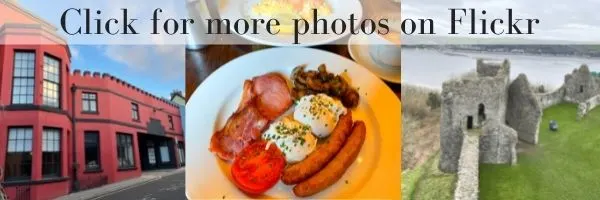Carmarthenshire has a little bit of everything you’d hope to find in Wales. There’s ancient castles, lush green fields, broad sandy beaches. Quiet country roads that meander through a rolling landscape.
We visited for a long weekend and loved the market towns with their colourful houses and cosy cafes. The gardens were bursting into spring life getting ready for estuary walks under wide open skies.
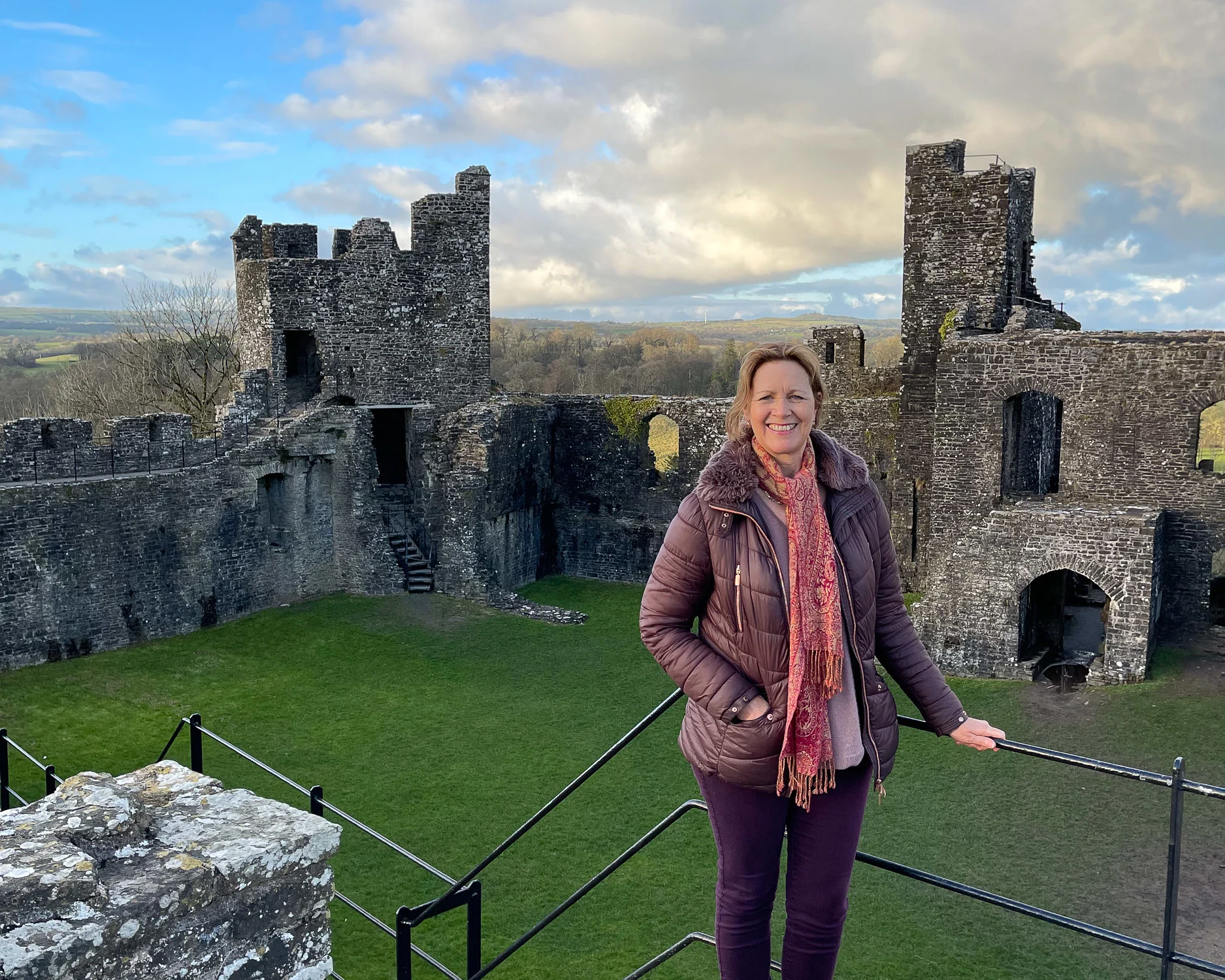
This is a place to enjoy the slower pace of rural life, the gorgeous scenery and friendly welcome – or Cwtch as they like to call it in these parts. Cwtch means a caring hug, or cosy feeling of wellbeing. Discover all the fun things to do in Carmarthenshire Wales, that make it a perfect weekend break destination.
This article may contain affiliate links that provide commission on purchases you make at no extra cost to you. As an Amazon Associate I earn from qualifying purchases.
1 Llandeilo – explore the pretty market town
The pretty market town of Llandeilo, where we stayed, makes a great base to explore Carmarthenshire. Arriving over the sweeping stone arch bridge, a string of colourful cottages leads you past the church and into the town.
You can’t miss the handsome deep red building of The Cawdor hotel, our home for a couple of nights. From the main road, smaller streets and lanes lead you past Georgian houses and interesting small shops that seem just made for browsing.
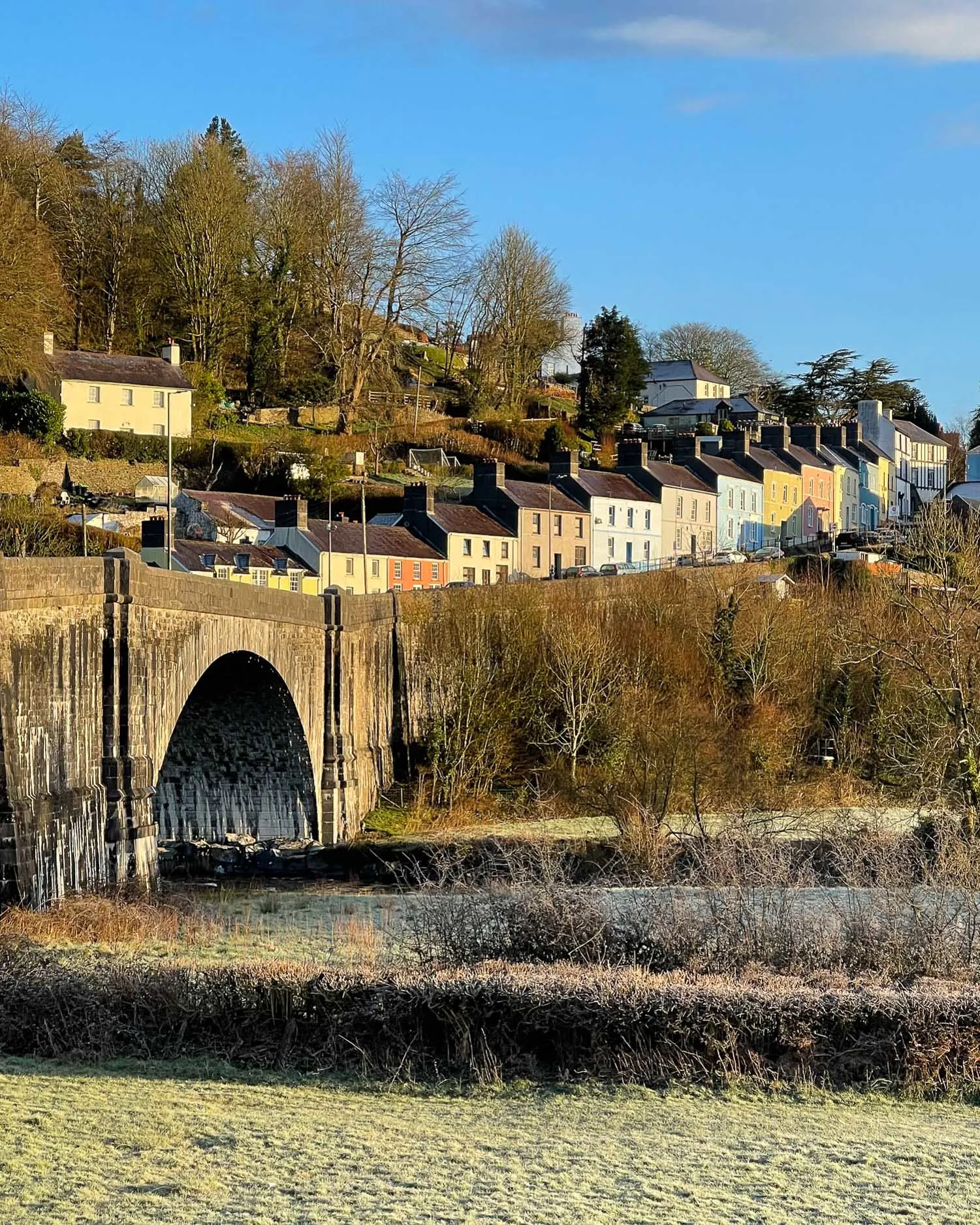
While shopping is one of the fun things to do in Llandeilo, you won’t find many big high street brands (unless you count Toast, which started here). Rather there’s a collection of independent boutiques, galleries, craft shops and cafes.
You’ll find the shopping a bit different with a Welsh flavour. It would be easy to lose a morning here meandering between cafes and clothes shops. Dip into the pretty church and peaceful churchyard, read the plaques around town about the history of the place.
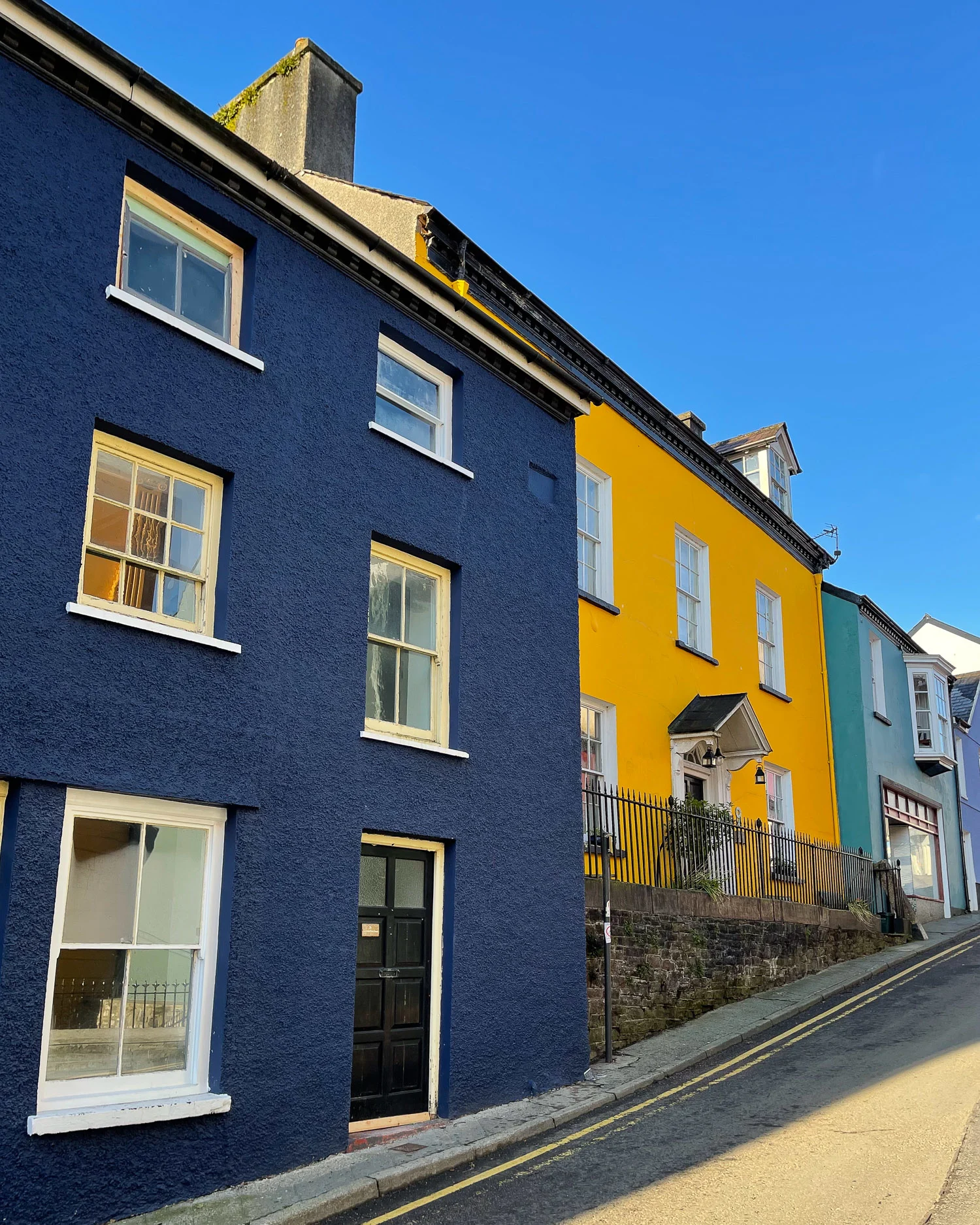
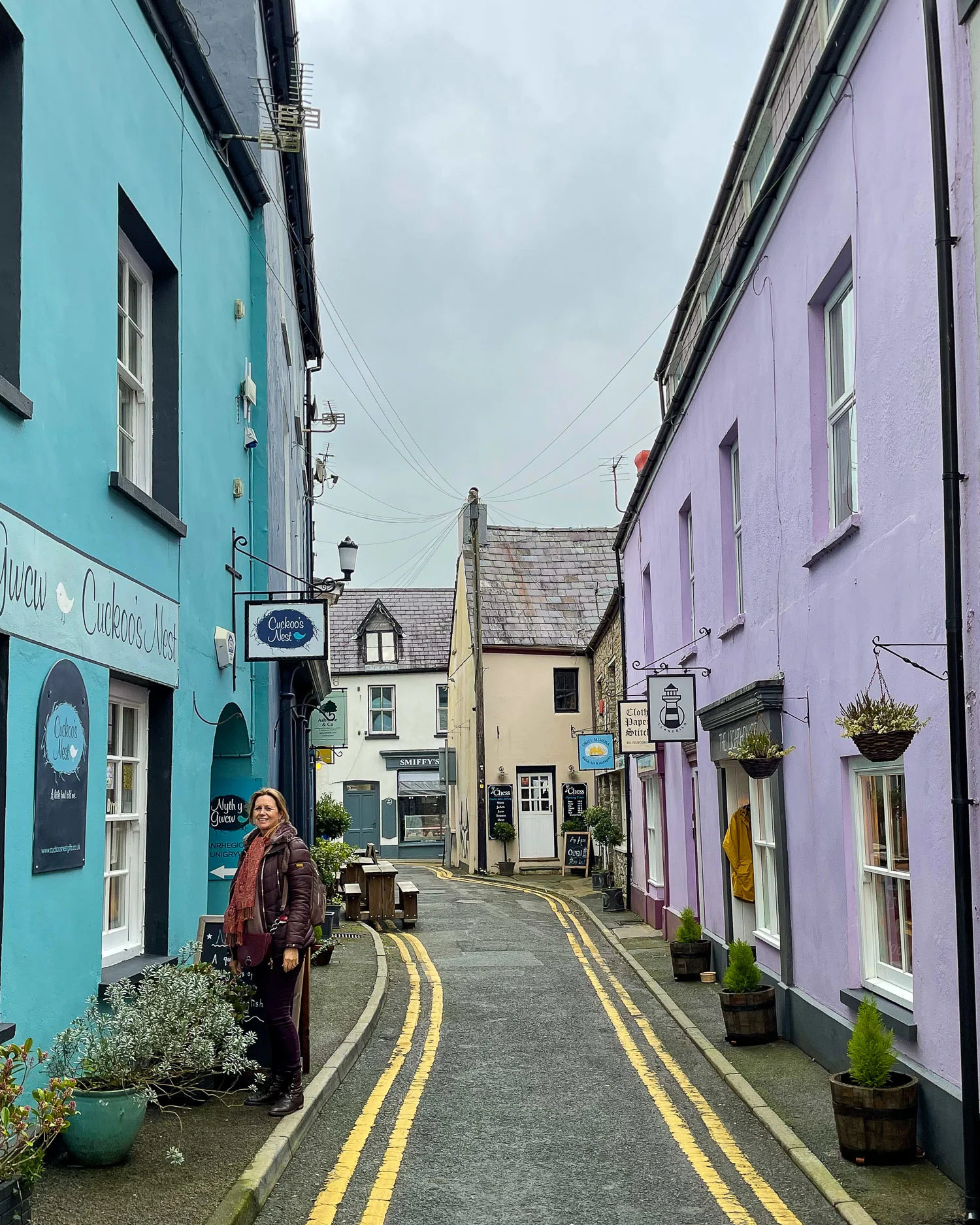
A few of our favourite shops in Llandeilo included
Fashion
This is the home of the original Toast store. They also have an outlet shop for pretty prints and relaxed fashion that suits the country life.
For elegant jewellery that’s made in Wales, including bespoke commissions, Mari Thomas jewellery has a large shop in the former Castle Hotel.
Everything the elegant country lady might need to fill her wardrobe is found at The Lighthouse or for unusual flowing boho style there’s Dot Clothing.
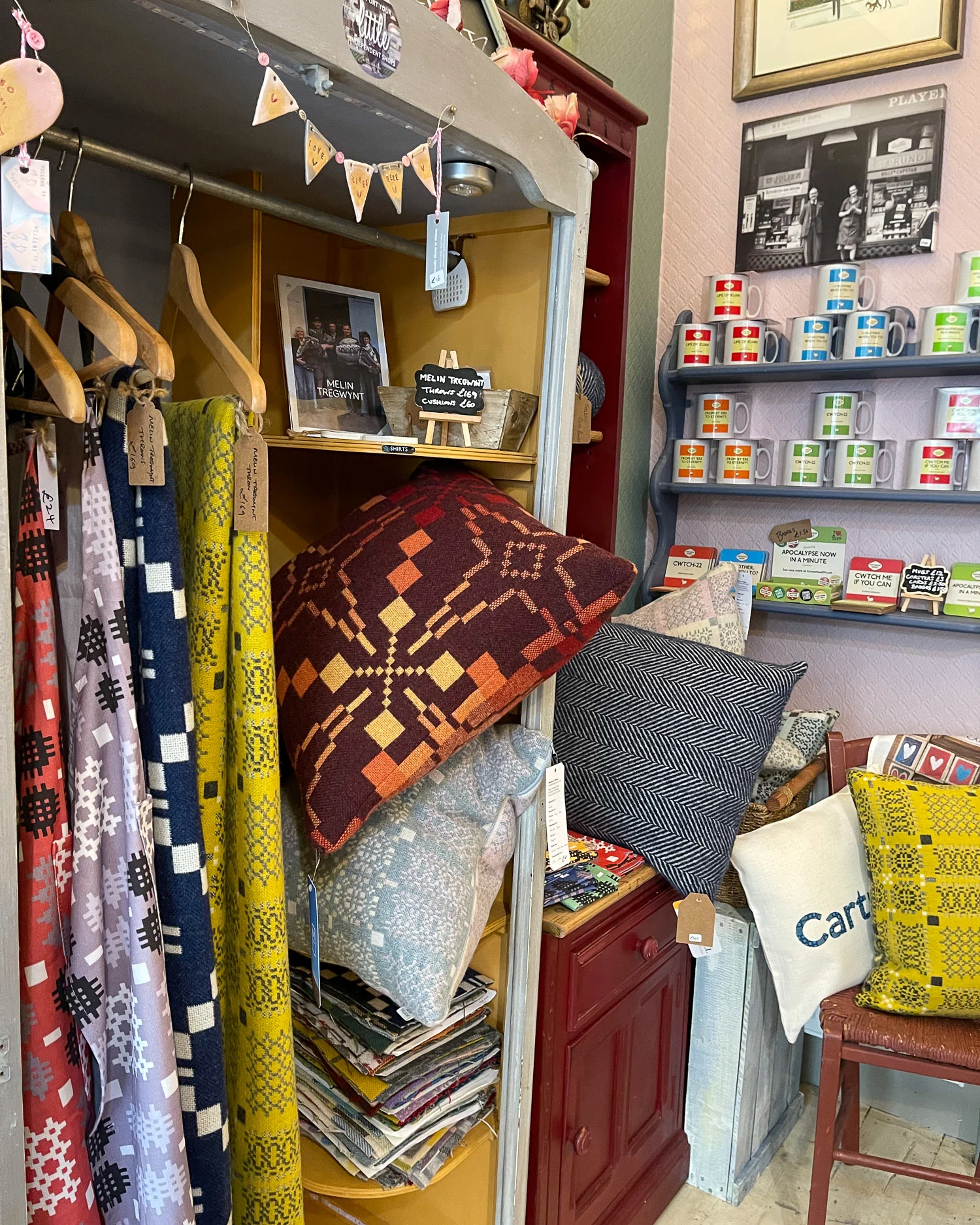
Home
We always love browsing in kitchen shops like Peppercorn cookware full of gadgets and tableware that inspire you to get your friends round and cook up a feast!
On the main street The Little Welsh Dresser has creative gifts for the home. They also run furniture painting workshops and stocking Annie Soan chalk paints for all your upcycling projects.
Scorpio is the place for home furnishings, Welsh woollen cushions and blankets, while Papillon Interiors is full of pretty French style accessories for the home.
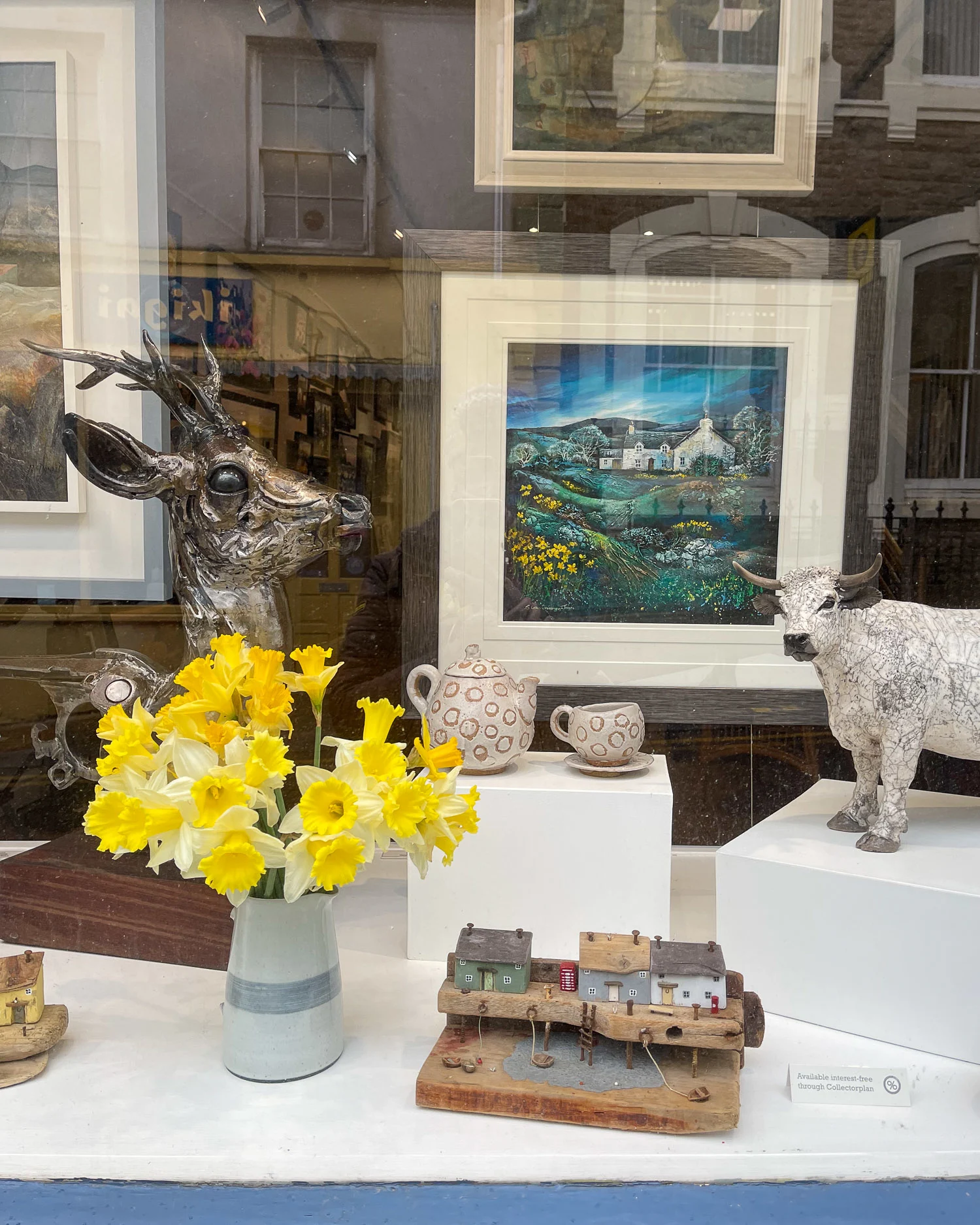
Gifts
Visit the lavender painted Cuckoo’s nest gifts tucked down one of Llandeilo’s prettiest lanes for unique and quirky gifts, especially for little ones.
On the main street Crafts Alive Wales has a big selection of crafts made by local artists who take it in turn to work in the shop and welcome a chat about their work.
For paintings and sculptures by local Welsh artists visit Oriel Mimosa fine art with more artwork in the gallery above Dot clothing.
More information on the Llandeilo website or the Discover Carmarthenshire website
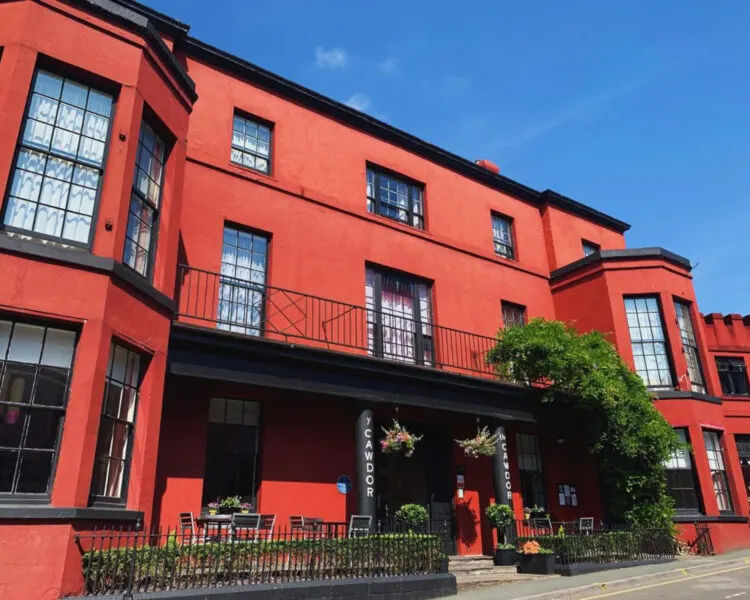
Stay at the stylish boutique hotel The Cawdor in Llandeilo – this was the base for our weekend in Carmarthenshire
2 Discover the local Welsh food scene
Llandeilo is also a great place to discover the fabulous Welsh food scene. There some excellent cafes and restaurants here. The lush green landscape of Carmarthenshire offers some wonderful produce and is home to numerous artisan food businesses.
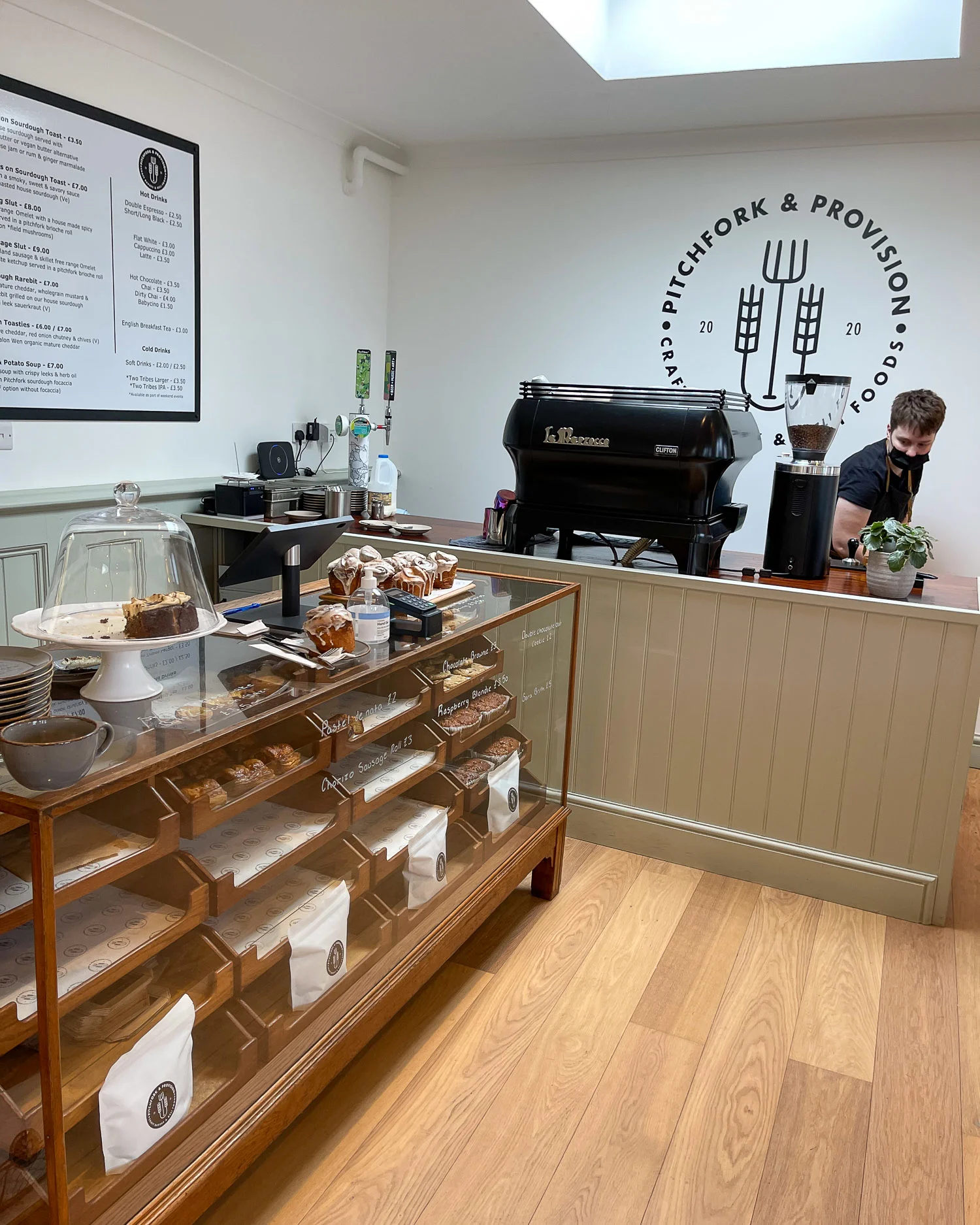
Breakfast in Llandeilo
We stopped for coffee at the artisan bakery and coffee shop Pitchfork and Provision. With spare white walls and an old cabinet full of delicious looking cakes and sourdough bread it wouldn’t have been out of place in hipster East London.
Another coffee stop we’d like to have tried were Diod, a coffee and wine shop with a light and airy Scandi vibe. Or Heavenly where they sell indulgent chocolates, cakes and gelato.
Read about 16 fun things to do in South Wales – in the Valleys
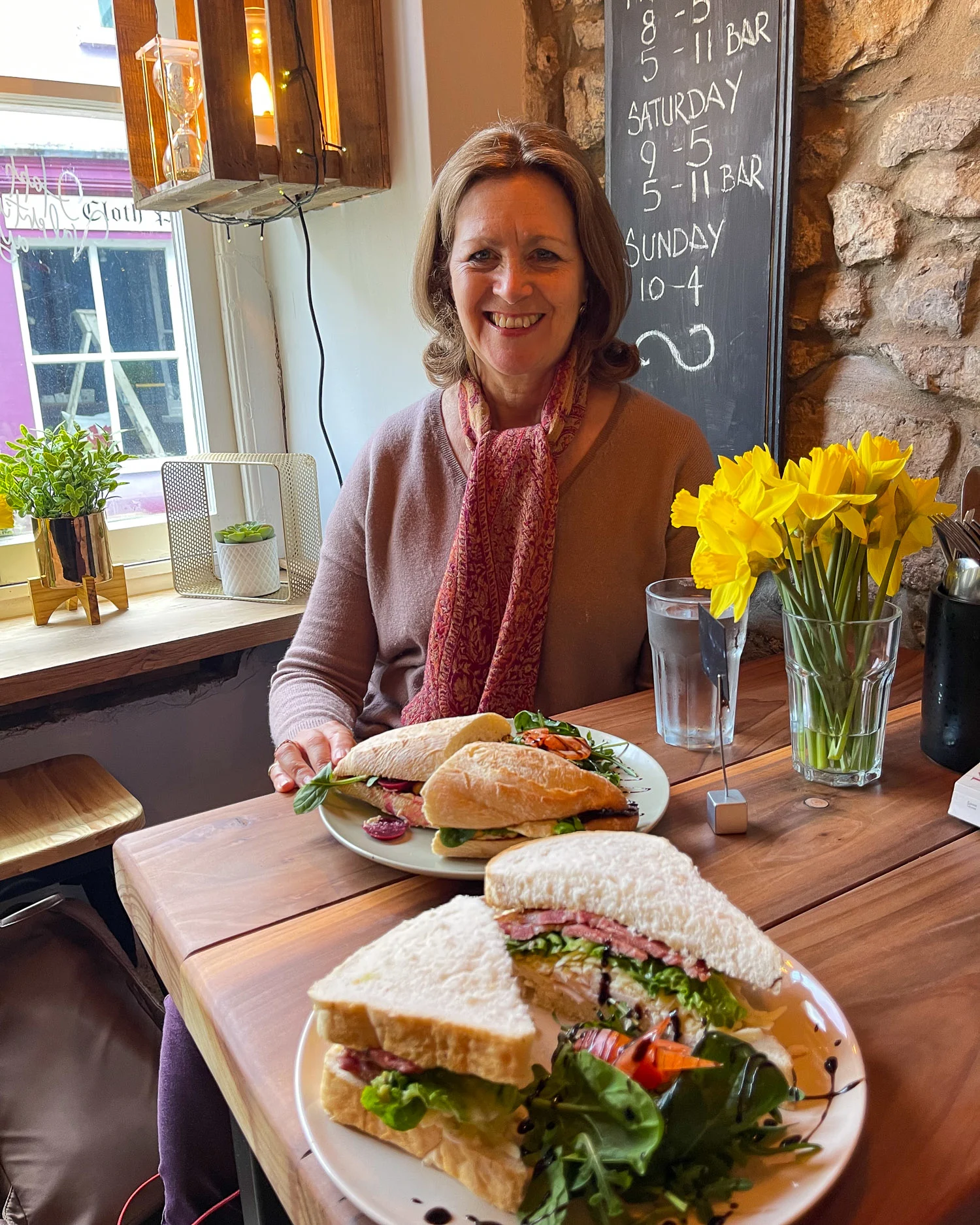
Lunch in Llandeilo
For lunch in Llandeilo, we stopped in at Flows on Market Street, formerly part of the Ginhaus deli but now running independently under new ownership. This popular all day cafe has a delectable selection of cakes and serves light dishes and sandwiches at lunchtime.
My beetroot and hummus rustic baguette was super tasty and fresh. Drinks are also served into the evening, with live music events some nights.
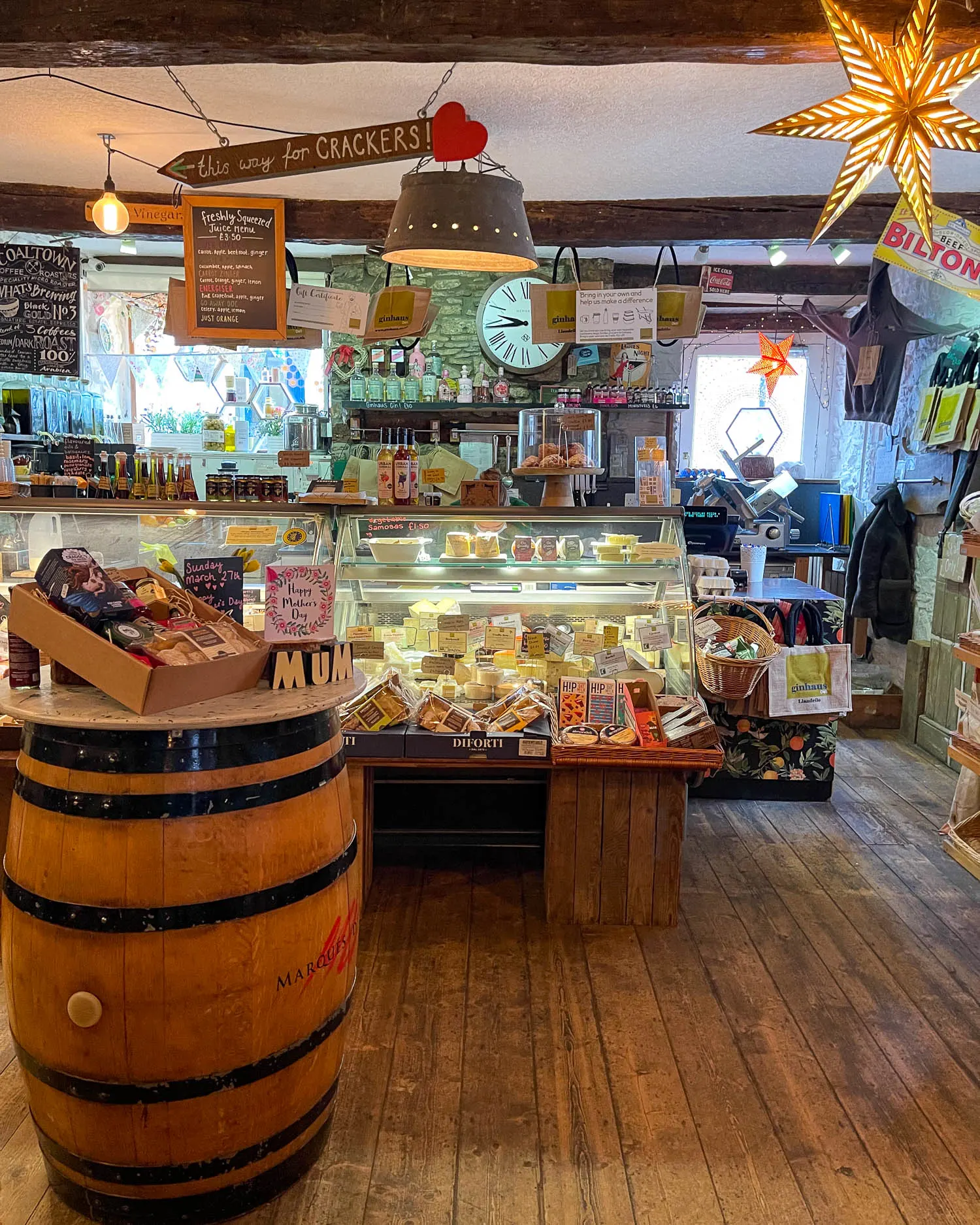
Next door to Flows is Ginhaus Deli, an emporium of delicious deli products. It boast a cheese and charcuterie counter that features lots of Welsh cheese and shelves stuffed with jams, preserves and sauces.
As the name suggests, they are best known for their enormous selection of gins. There’s over 200 different brands including their own Ginhaus brand.
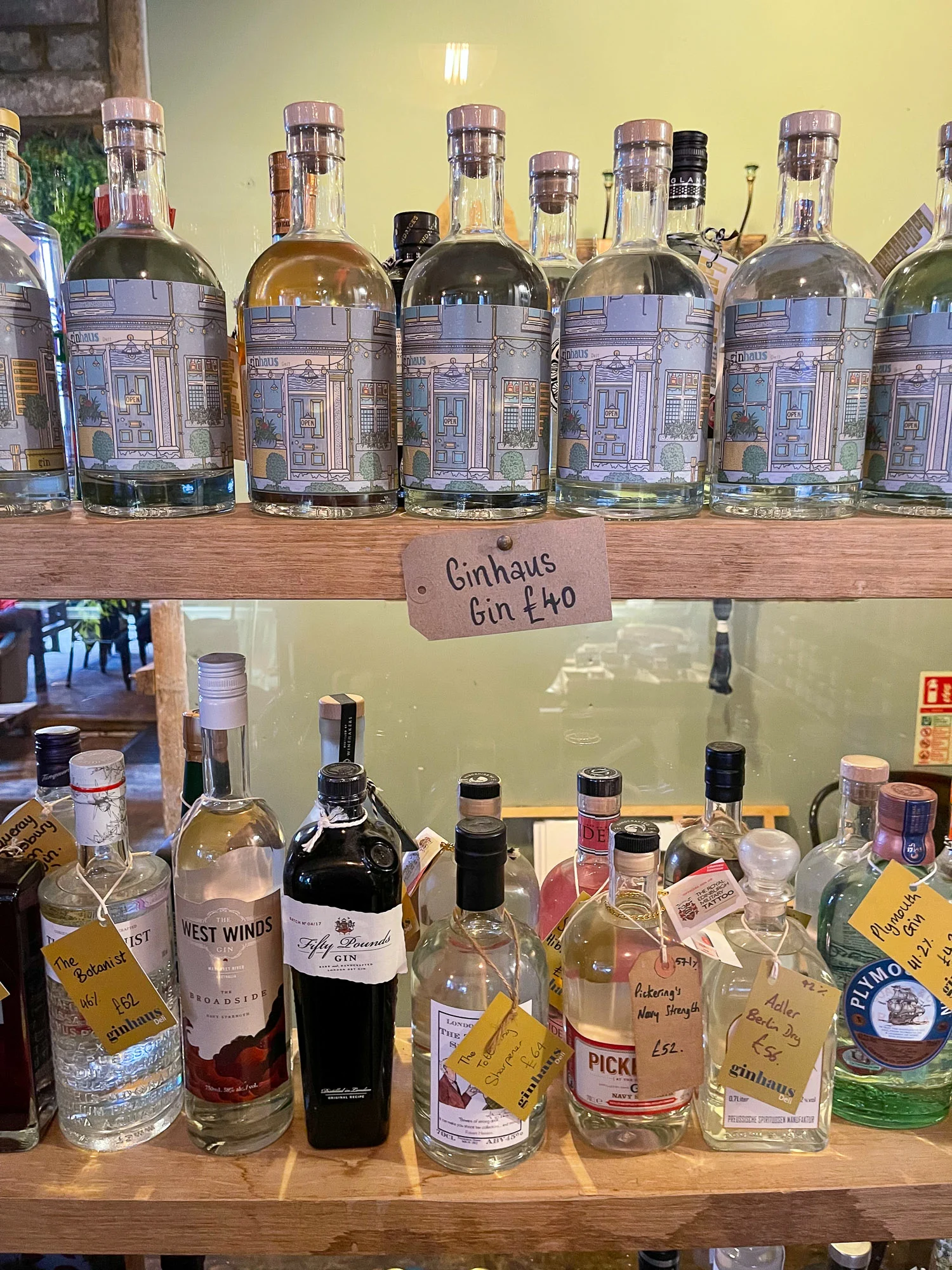
The deli is a one stop shop to discover local Welsh producers from Carmarthenshire and beyond. Look out for coffee from Coaltown Roastery (they have their own cafe at Ammanford) who are bringing employment to a former Welsh mining area.
Check out the bars of Little Croft chocolate, plant based Do Goodly Dips and Cwrw Llyn craft beers brewed in North Wales, to name but a few.
3 Newton House – full of creativity and stories
Just outside the town of Llandeilo you’ll find Dinefwr park and castle. At the heart of the 18th century deer park sits Newton House. This Grade II listed mansion was home to the Rhys family, descendants of the Welsh Prince Lord Rhys, for 300 years.
Before management of the house and park was taken over by the National Trust in 1990, Newton House was used as an arts centre. It is this legacy of music and the arts that is now being taken forward with a programme of artistic and cultural events.
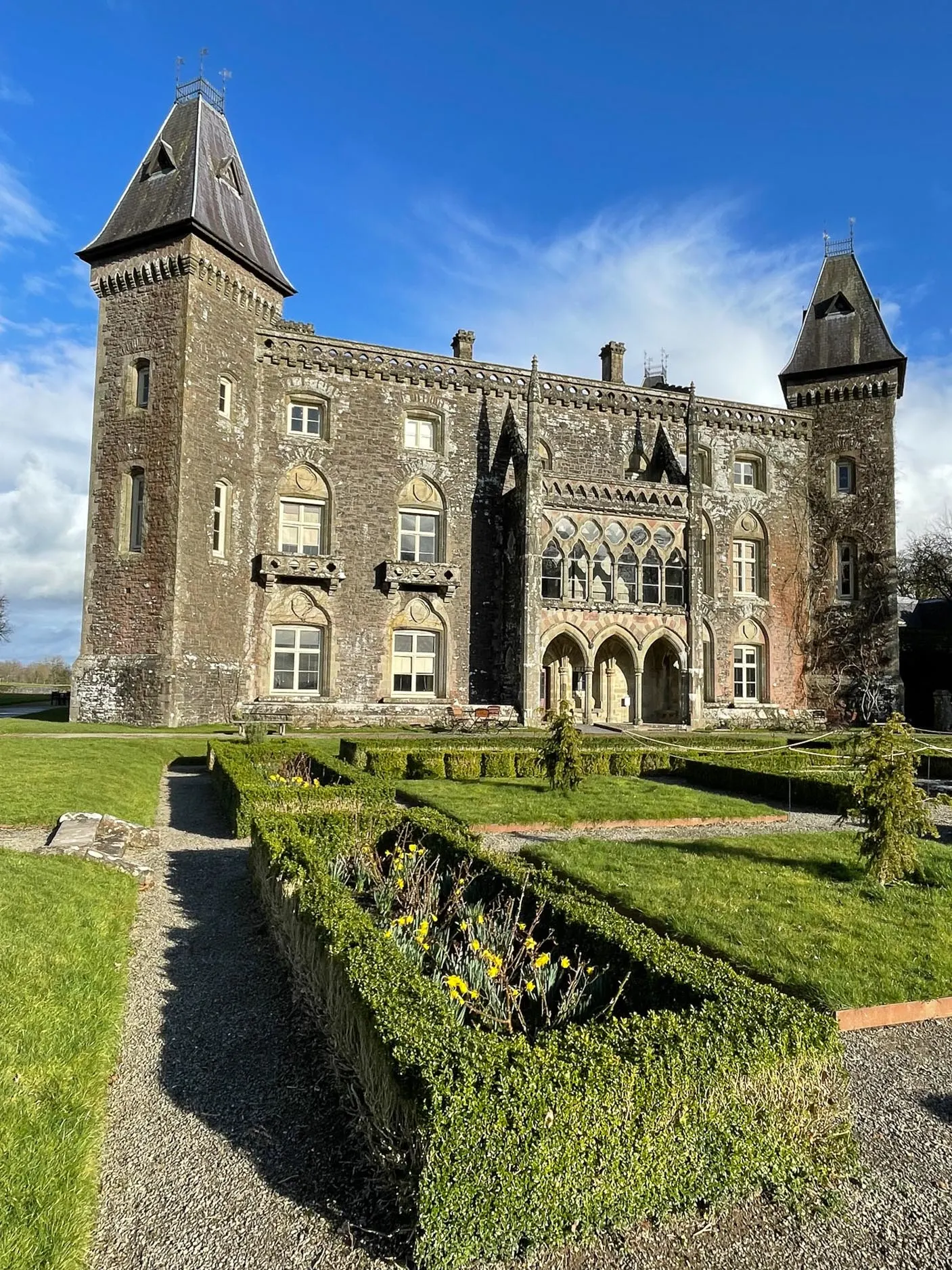
Look out for the famous White Park Cattle of Dinefwr, an ancient breed who graze in the fields around Newton House during the summer. You’ll find the meat is on sale in the National Trust shop. Here’s what we especially enjoyed from our visit;
- Be sure to look up at the decorative plasterwork ceilings throughout the house, which are original and date back to 17th century.
- We enjoyed relaxing in the squashy pink velvet sofas in the drawing room, which were used in the film Downton Abbey. They are actually part of the cafe, so you can sit and sip tea in elegant style, like the lady of the house from days gone by.
The ornate fireplace
- Also in the drawing room is the beautifully carved fireplace which although it looks old, was actually carved by a local craftsman more recently. You can see the models for the design of fruits and flowers in the exhibition of 125 objects upstairs.
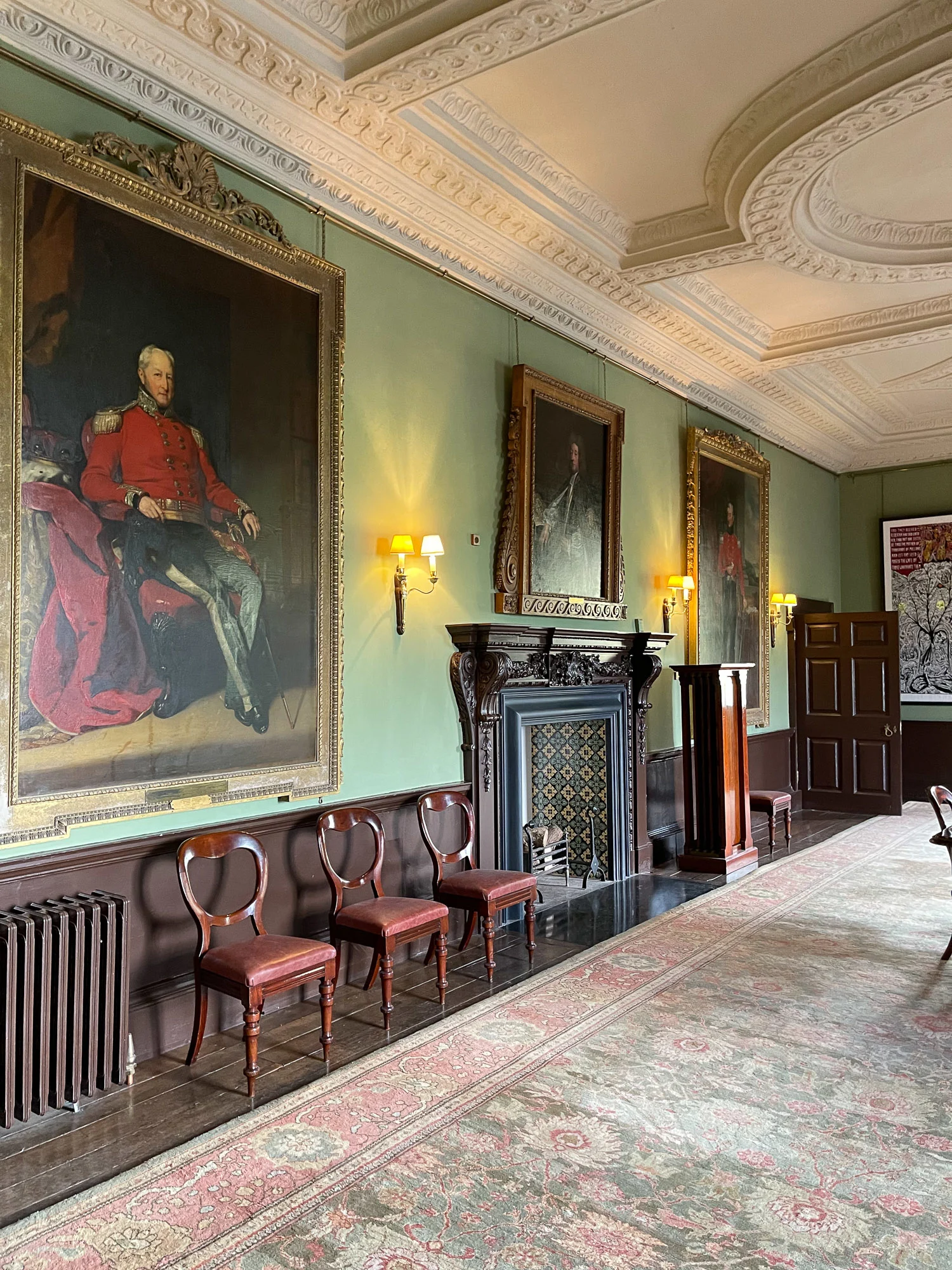
- In the green dining room hangs a contemporary lino-cut by local artist John Abell. It commemorates the Rebecca riots of 1843, when local farmers sometimes dressed up as women to protest against and burn down toll booths, a symbol of excessive taxation. Nearby hangs the portrait of Colonel George Rice, owner of Dinefwr who received death threats during the riots.
- On the first floor, the gothic style glazed balcony looks out over the deer park that was landscaped by Capability Brown. It is said to have been inspired by the gazebos in Venice.
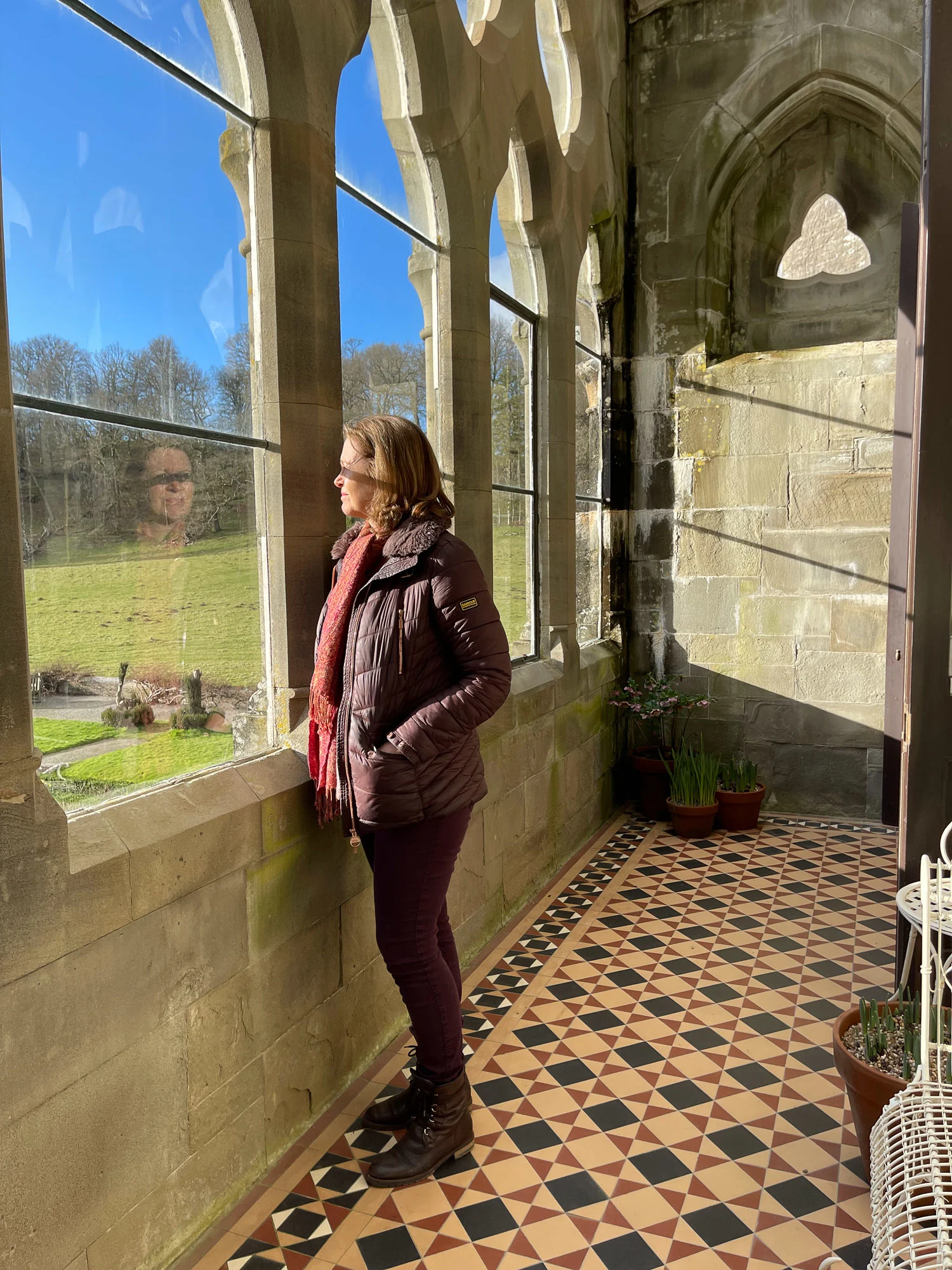
- The exhibition 125 objects at Dinefwr is full of interesting everyday objects that are part of the fabric and history at the house. A Welsh tall hat on display is a part of the traditional Welsh costume. A metal leek may have formed the top of a flag pole but other objects have a mysterious and fascinating history.
- Newton House, Dinefwr is said to be haunted. If you visit the basement kitchens and servants quarters, a smell of pipe smoke may indicate the ghost of Walter the butler. Or perhaps you will sense the presence of the ghost of Lady Elinor who is said to have been murdered in the 18th century. Visit at Halloween for after dark tours to hear more about the ghostly residents of Newton House.
More information to plan your visit on the National Trust website
4 Dinefwr Castle – views over the Tywi valley
From the National Trust car park within Dinefwr park, it’s an easy 15 minute walk up the hill to Dinefwr Castle. It’s ideal to combine this with a visit to Newton House.
The walk up through a woodland nature reserve takes you past ancient oaks. Bluebells spring up from the layer of fallen branches and leaves, ready to flower later in the spring.
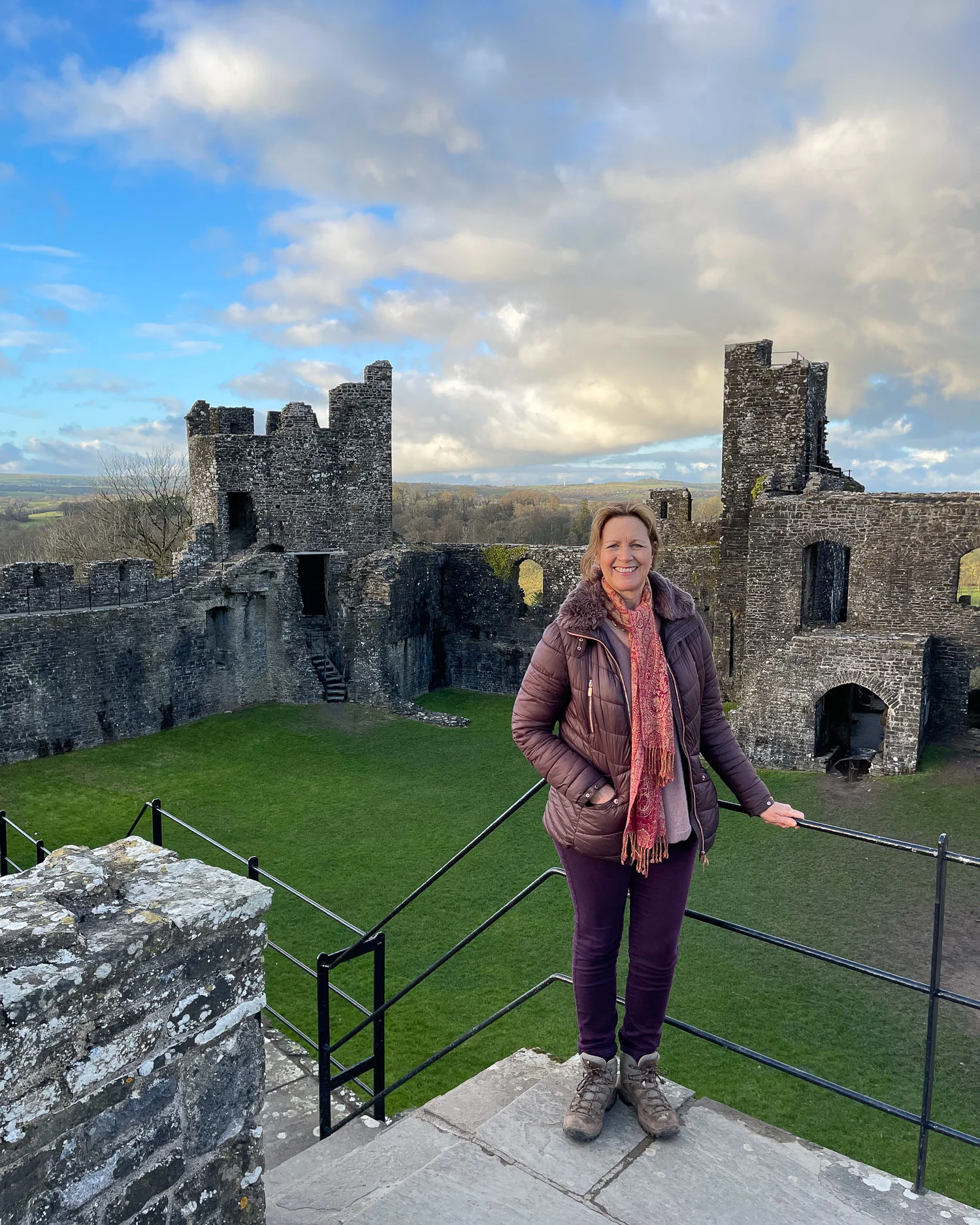
This castle on the high ground above Llanleilo has dominated the River Tywi valley for centuries and the views from the battlements are stunning.
The original fortress would have been built of wood, replaced by the thick walls of this castle fortress. These were constructed in the 12th century by Lord Rhys, ruler of the Southern Welsh kingdom of Deheubarth.
Read about a long day’s walk on the Pembrokeshire Coastal Path – Broadhaven to St Davids
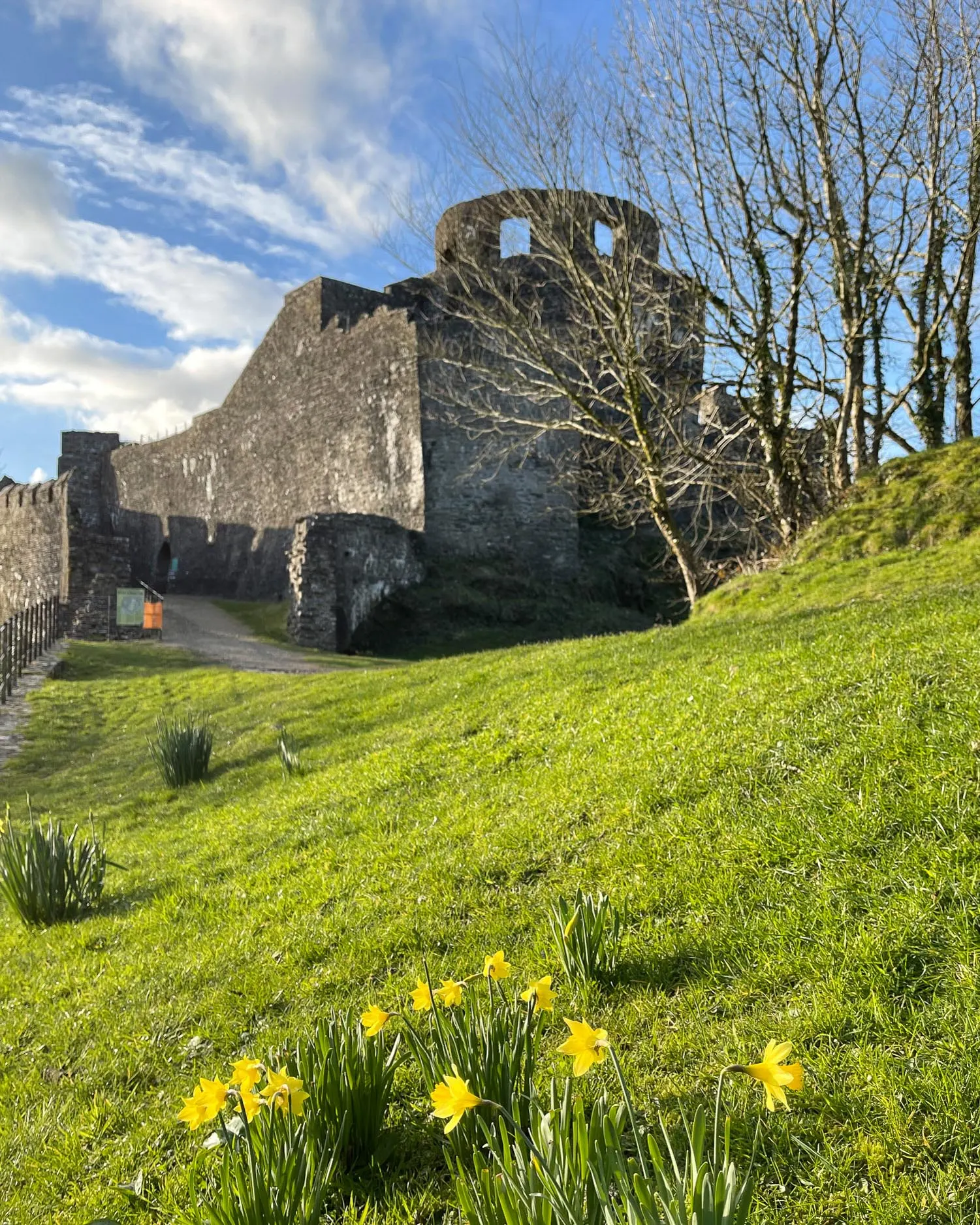
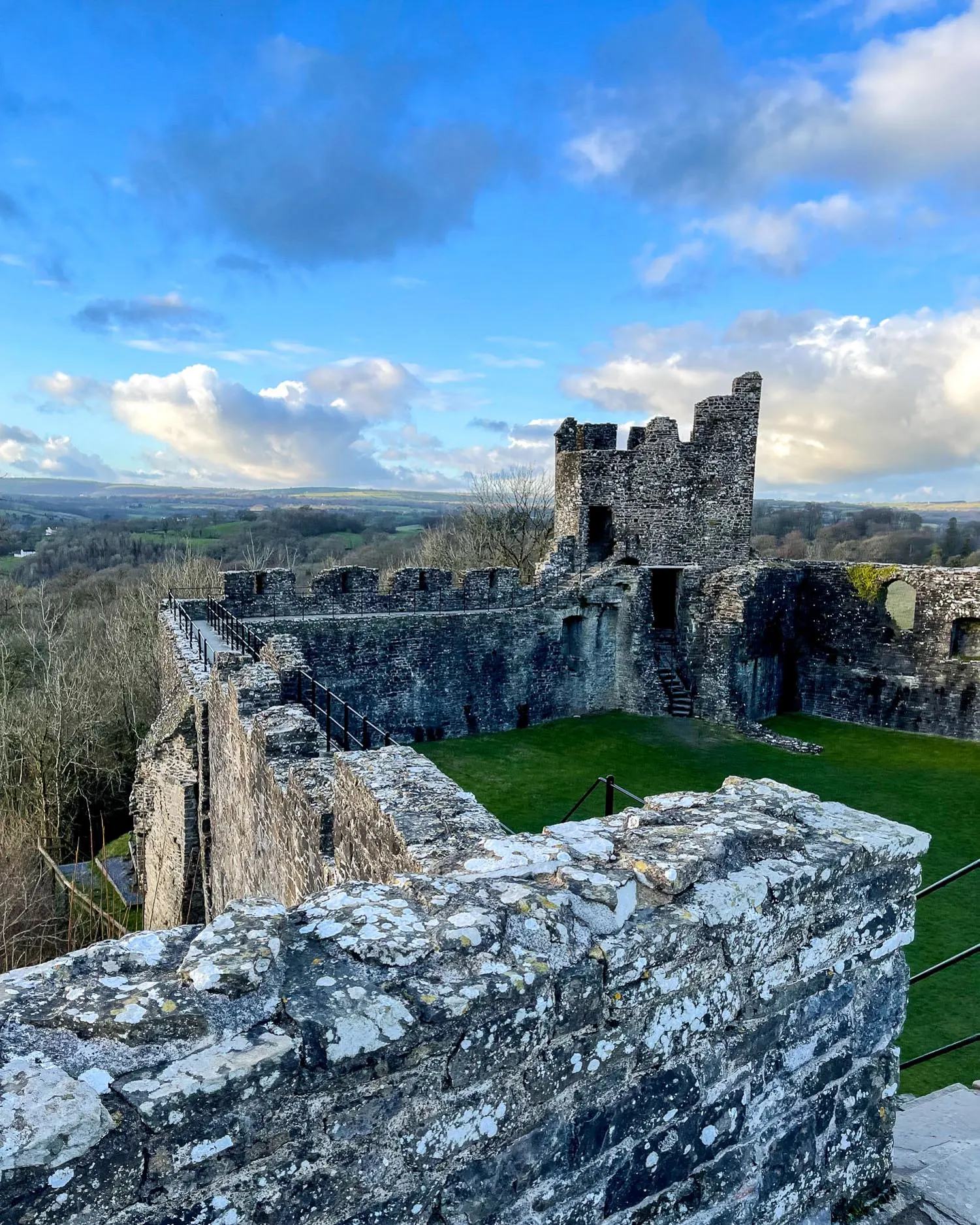
The defensive castle walls enclosed a tower and other buildings that would have provided comfortable living quarters for the constable of the castle and his visitors. Dinefwr changed hands between the Welsh princes and English Marcher lords several times in later centuries.
Today you can walk around the top of the circular tower and climb up one of the square towers for spectacular views over the whole surrounding area.
The castle is free to visit, open daily 10-5pm and managed by CADW Wales. More information to plan your visit is on the Dinwefawr Castle CADW website.
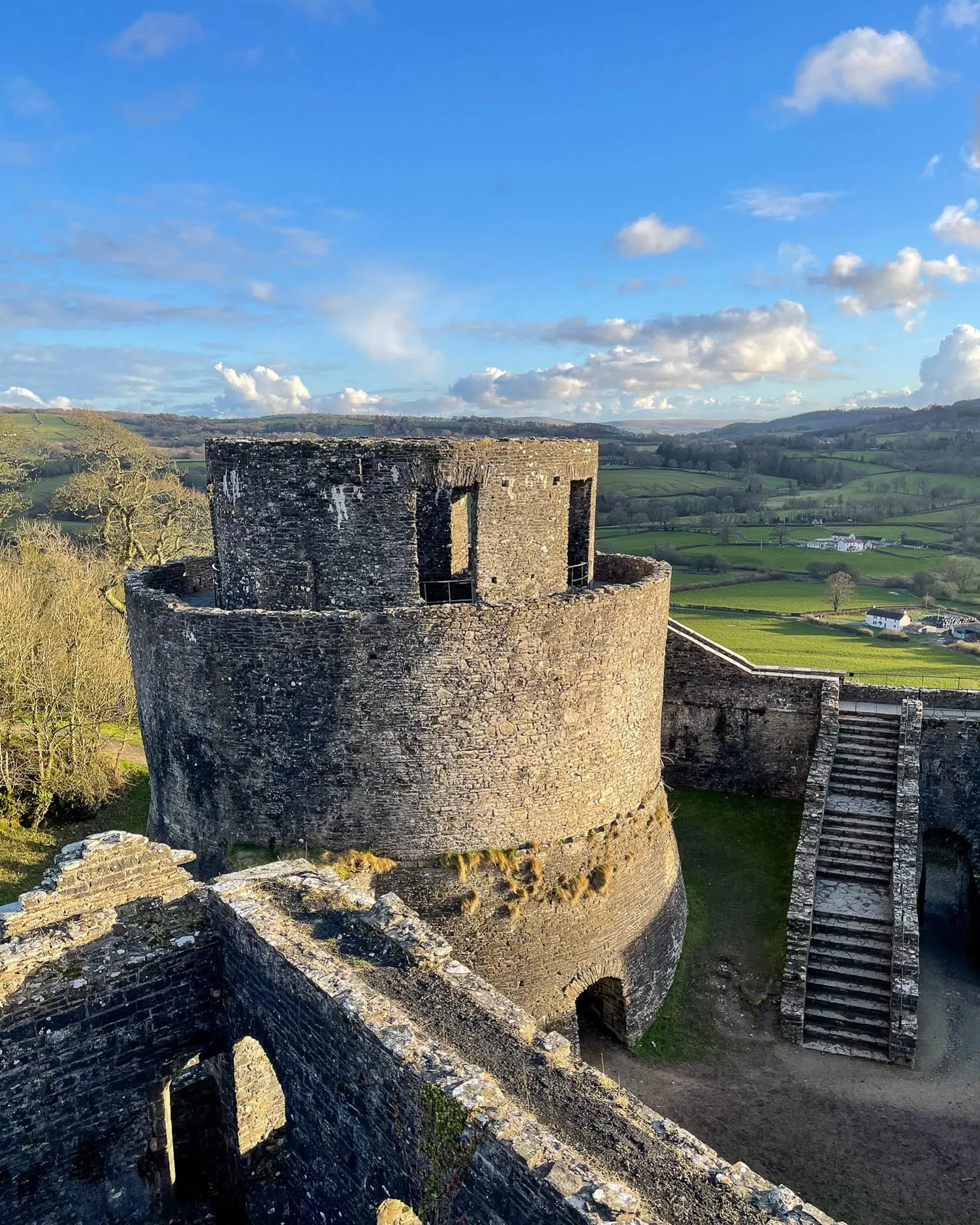
5 Aberglasney Gardens – a garden for all seasons
Also close to Llandeilo and Dinefwr Castle is Aberglasney, a beautiful garden for all seasons. There was a house surrounded by gardens here in the reign of Henry VIII, owned by the High Sheriff of Carmarthenshire, Sir William Thomas.
In the 1600s, the estate was bought by Bishop Anthony Rudd, the Bishop of St David’s. Rudd remodelled the house and gardens, creating the Elizabethan Cloister Garden.
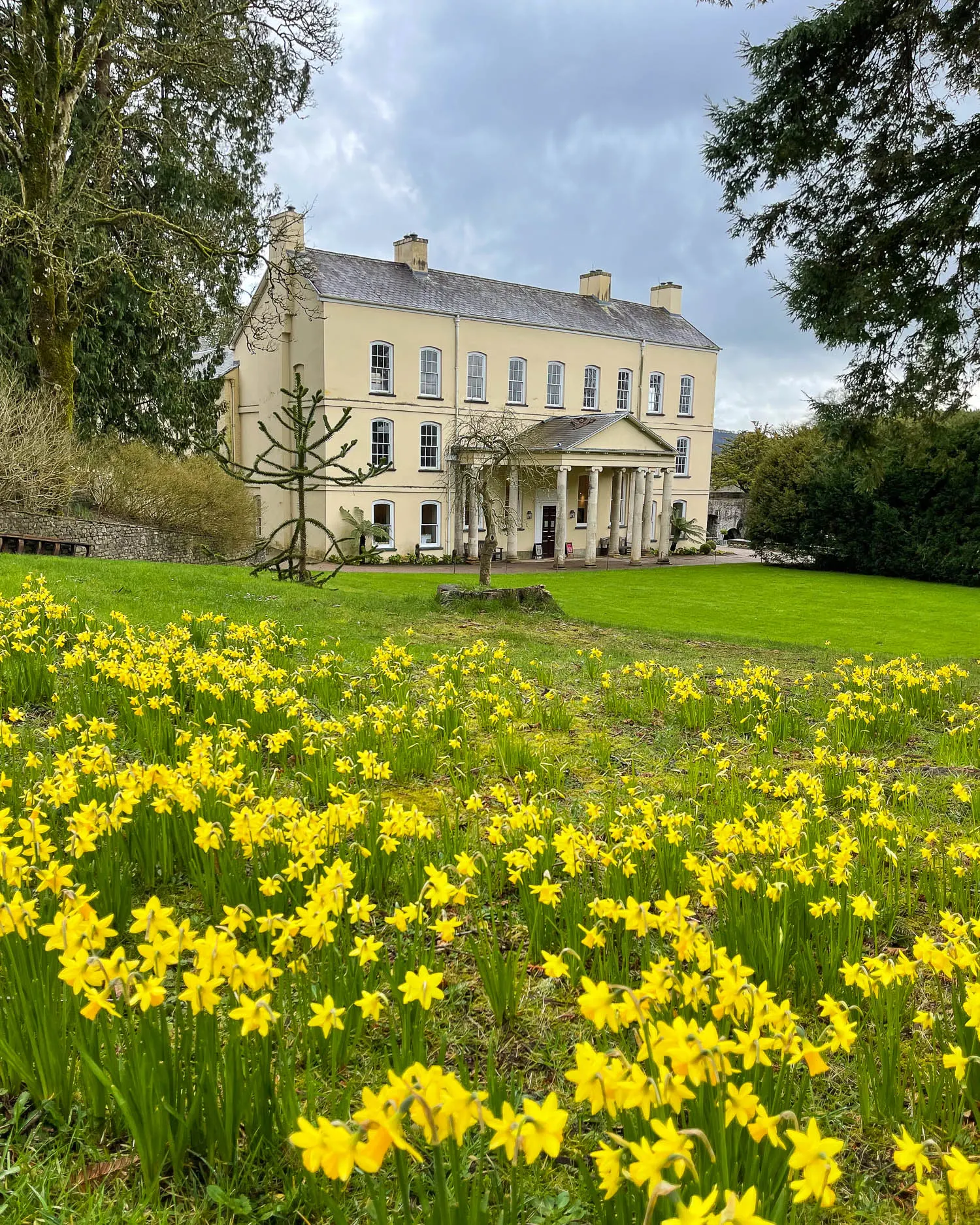
In the Regency and Victorian period, the house was owned by the Phillips family. Their money had been acquired through the East India Company but in the post war years it fell into decline.
Then in 1995 the house and gardens were taken over by a trust, funded by an American benefactor. The restoration of the gardens led Aberglasney to feature in a BBC TV series, “A garden lost in time”.
Today it’s mainly the gardens that visitors come to see, as only the ground floor rooms of the mansion are open and used as exhibition space. The highlights we enjoyed on our visit to Aberglasney were;
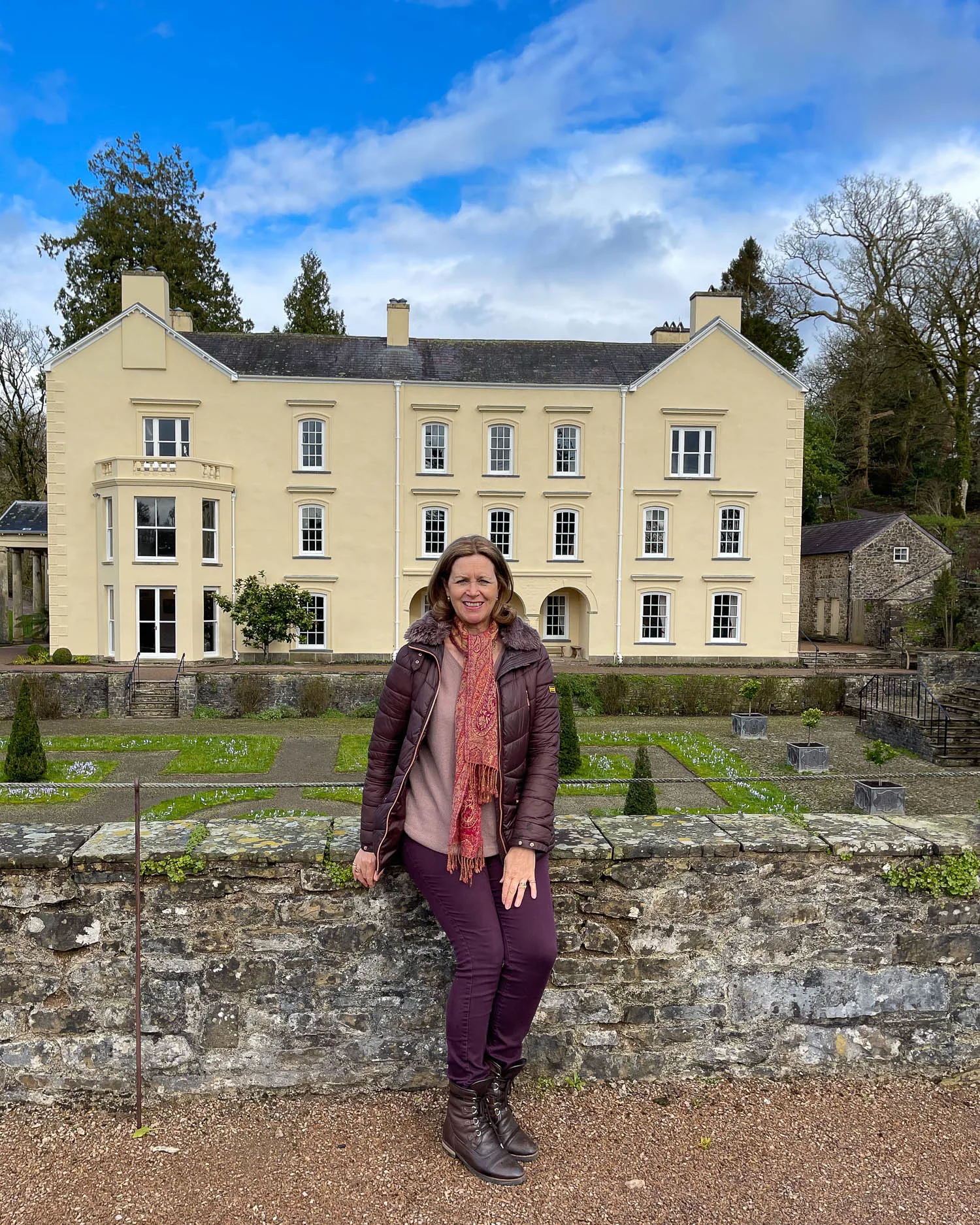
Elizabethan cloisters
- The famous Elizabethan cloister gardens bounded on 3 sides by arched cloisters that you can walk under. The gardens are designed to be viewed from above, from the house windows or the walkway on top of the cloisters. The grass of this formal garden was full of crocus when we visited, but in summer it’s bounded by flowering borders.
- The Ninfarium, a glass roofed courtyard at the side of the mansion. It encloses a sub-tropical garden full of palms and orchids protected from the cold.
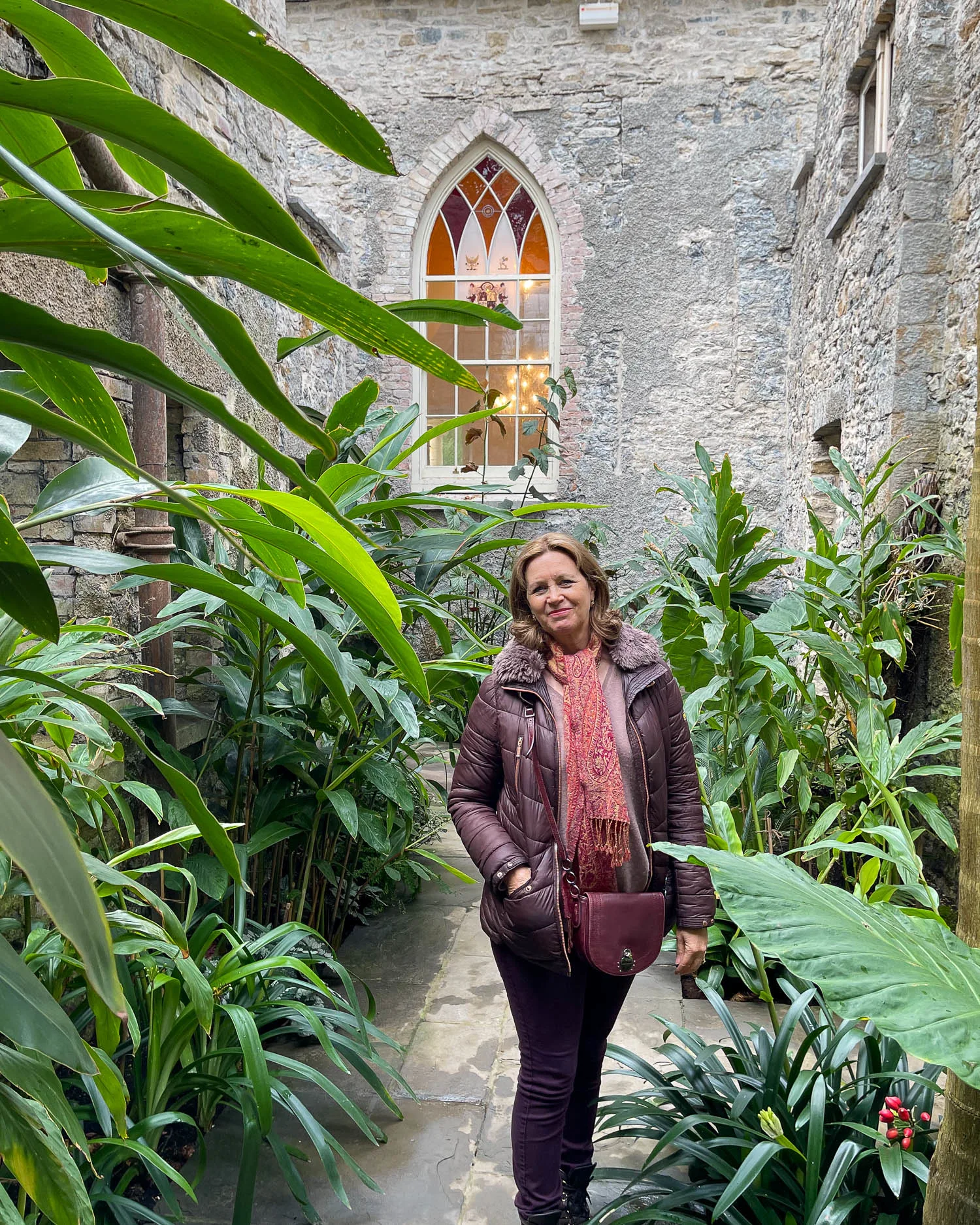
- The Alpinum, a gravel and rock garden that was full of colourful miniature spring bulbs when we visited.
- The Upper walled gardens with cones of topiary, designed by garden designer Penelope Hobhouse. When we visited the hellebores were flourishing and we could see tulips and other spring flowers coming into flower.
- The pool garden with its calming reflections, would once have been used to stock fish to feed the house.
More information on the Aberglasney Gardens website
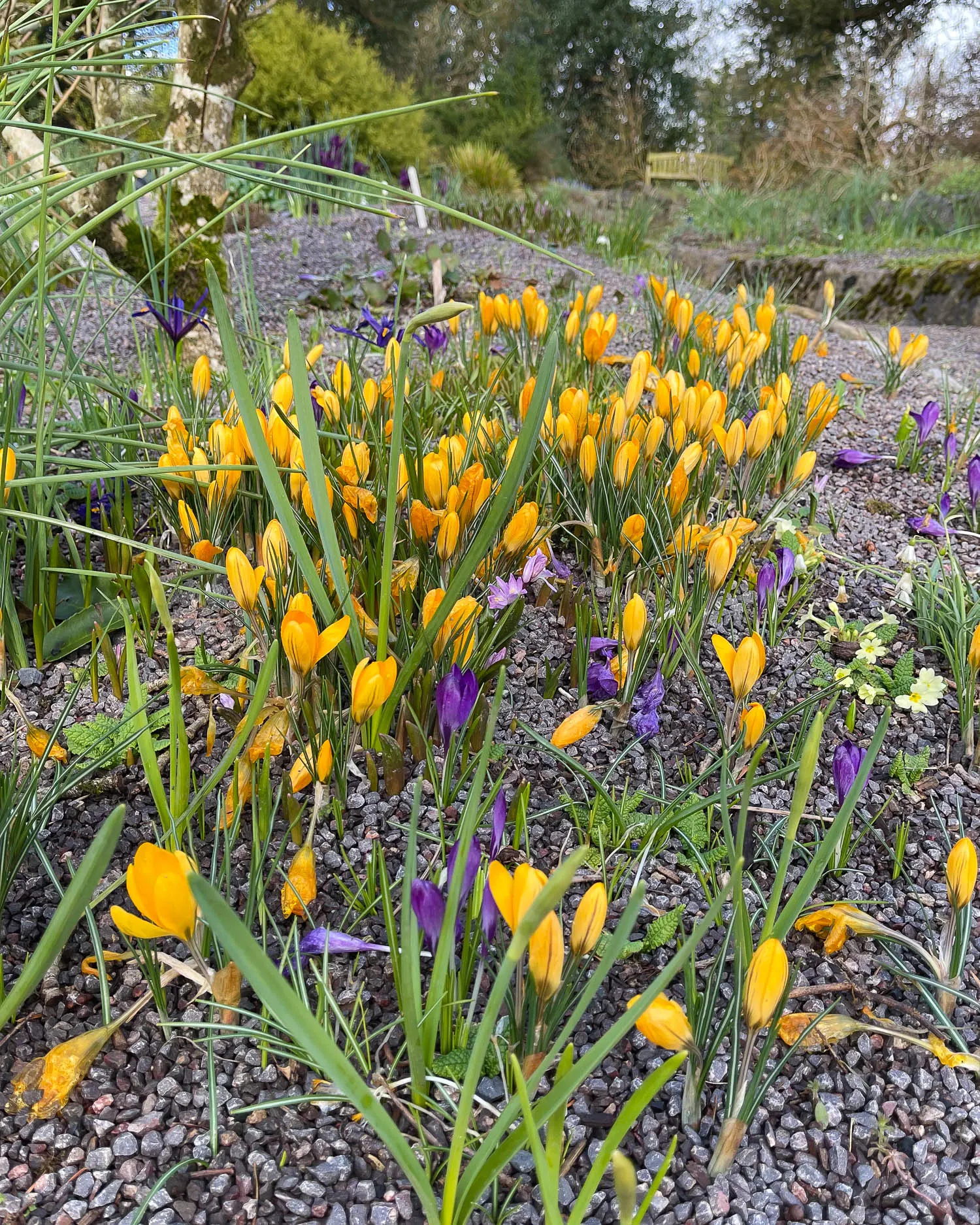

Stay at the stylish boutique hotel The Cawdor in Llandeilo – this was the base for our weekend in Carmarthenshire
6 Llandovery – drovers, bikers and veggie street food
A 20 minute drive from Llandeilo is the market town of Llandovery, where we had dinner one evening at The Bear Llandovery. This market town grew up at a crossing point of the River Tywi. It is a popular meeting point for outdoor enthusiasts who enjoy the nearby Brecon Beacons National Park.
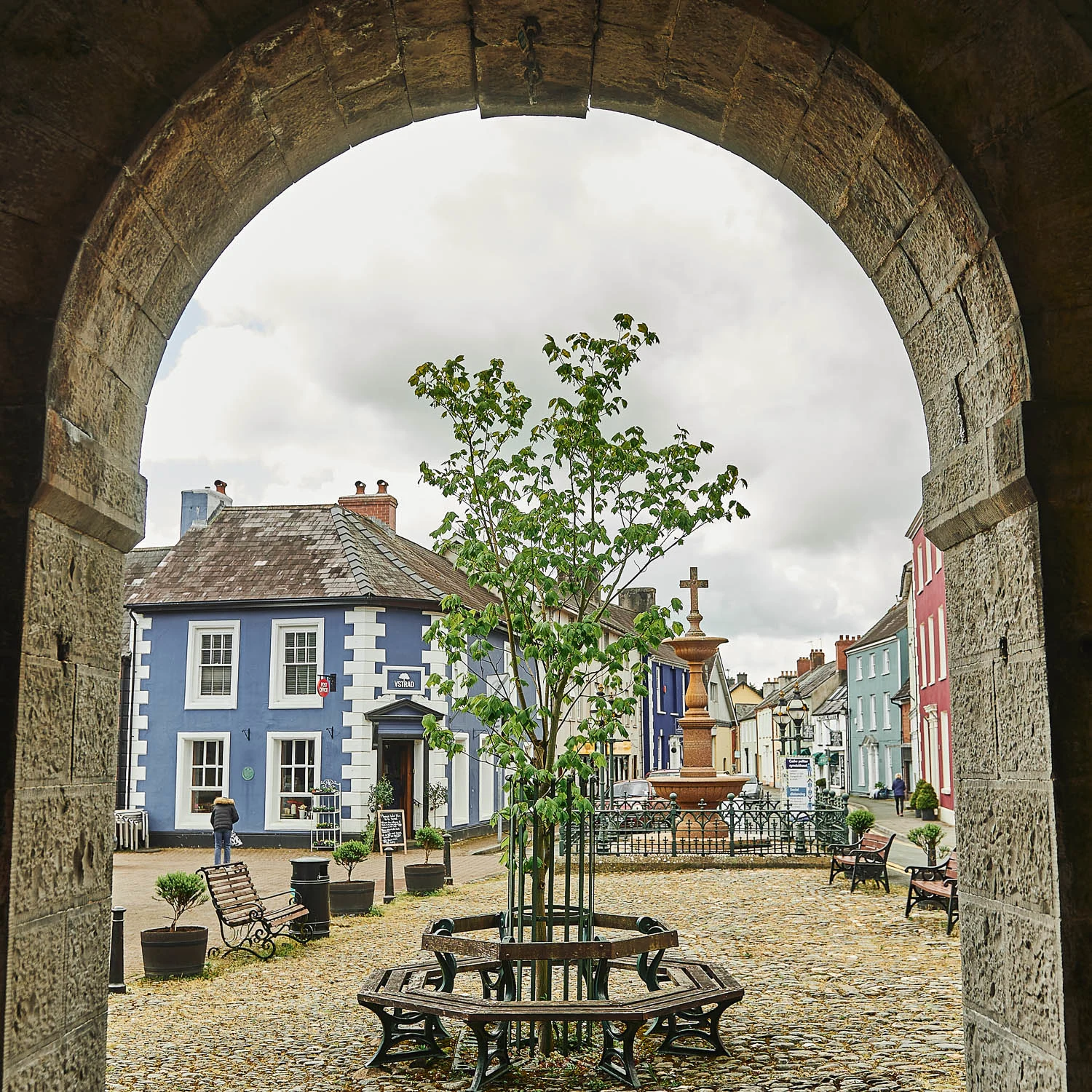
Llandovery is a solid Welsh farming community, and important centre in the past for drovers. The drovers brought their Welsh Black cattle here before taking them across the border to the English markets. If you have time it’s worth a stop to enjoy the cobbled market square, coloured houses and coffee or lunch stops.
Discover the Wye Valley – what to see, where to eat and stay on your picturesque Wye tour
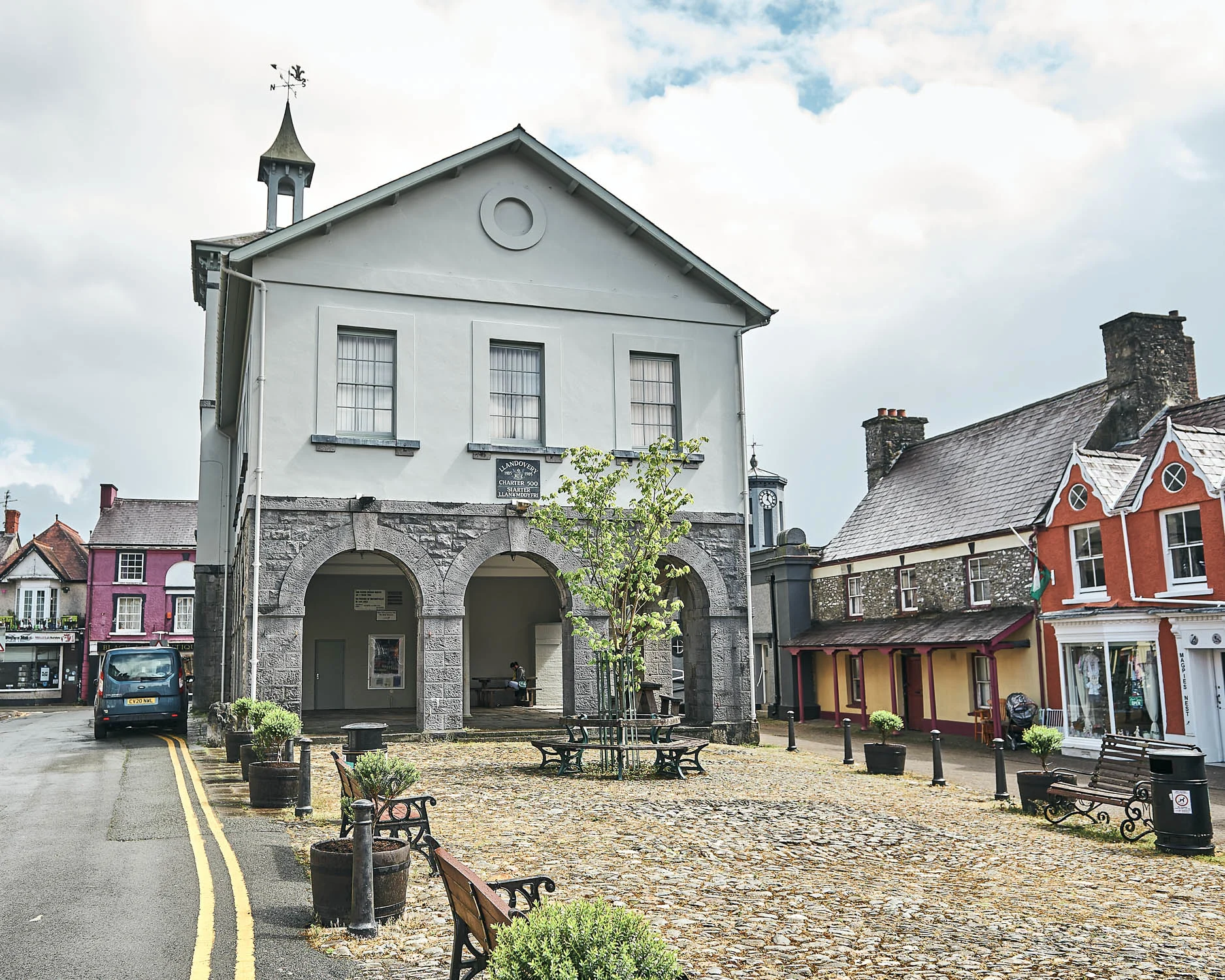
The Bear Llandovery
We ate at The Bear Llandovery, which you can hardly miss on the main road through town. It’s painted orange and black, in the tradition of coloured houses that seems to be strong in this area.
The former inn is now a cute and cosy restaurant, although it still keeps a pub style bar. It specialises in veggie / vegan Asian street food.
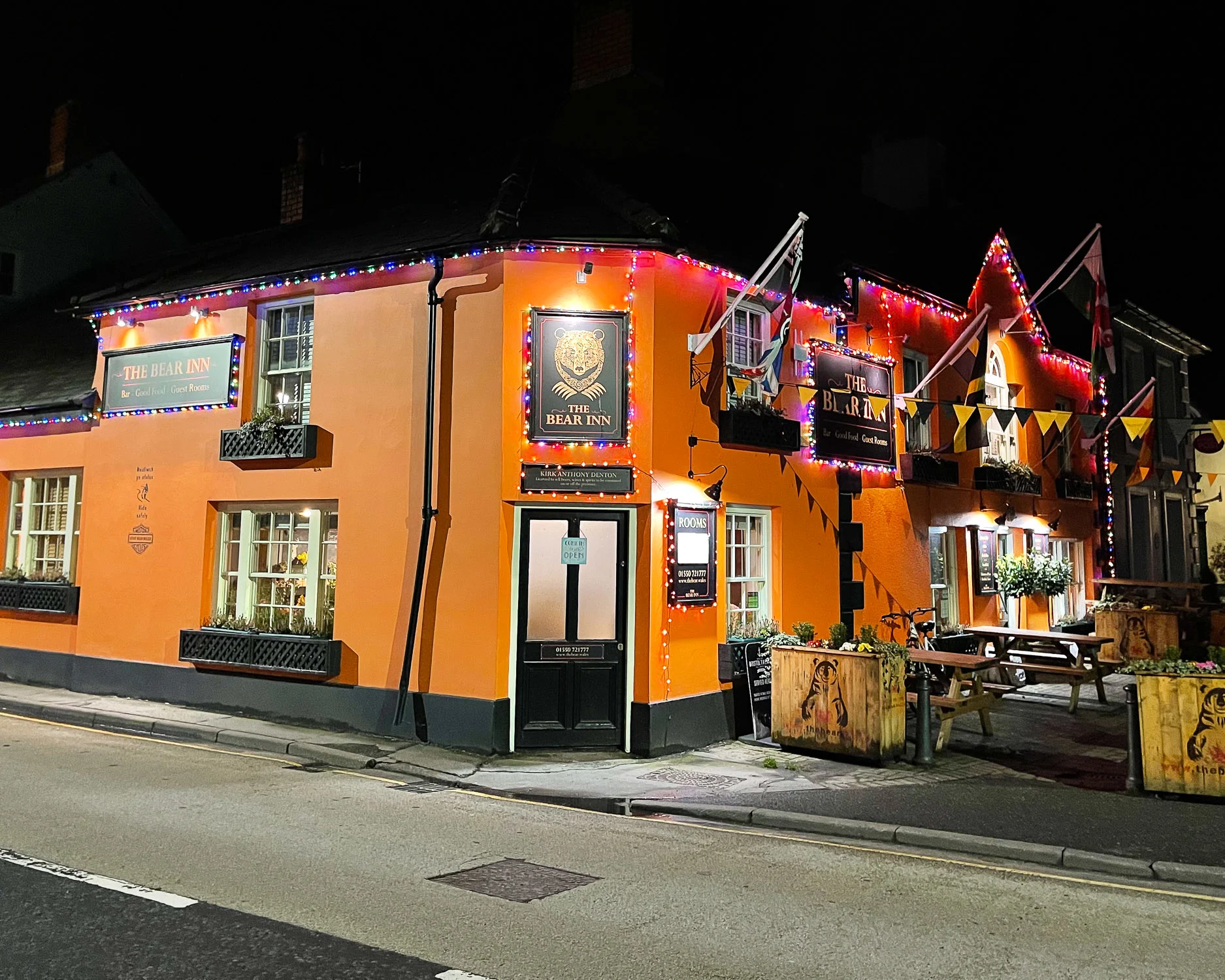
Although it may seem a little incongruous in a traditional Welsh farming town, once inside we were seduced by the warm welcome. Their tasty dishes feature flavours from Sri Lanka, Singapore,Thailand and Vietnam. The owners are very much rooted in the community, using locally grown salads and veggies for most of their dishes.
Co-owner Hanh, who comes from Vietnam and is the chef behind the Asian style menu. Hanh supports local community enterprises and runs a foundation that rescues trafficked women in Vietnam, India and Sri Lanka.
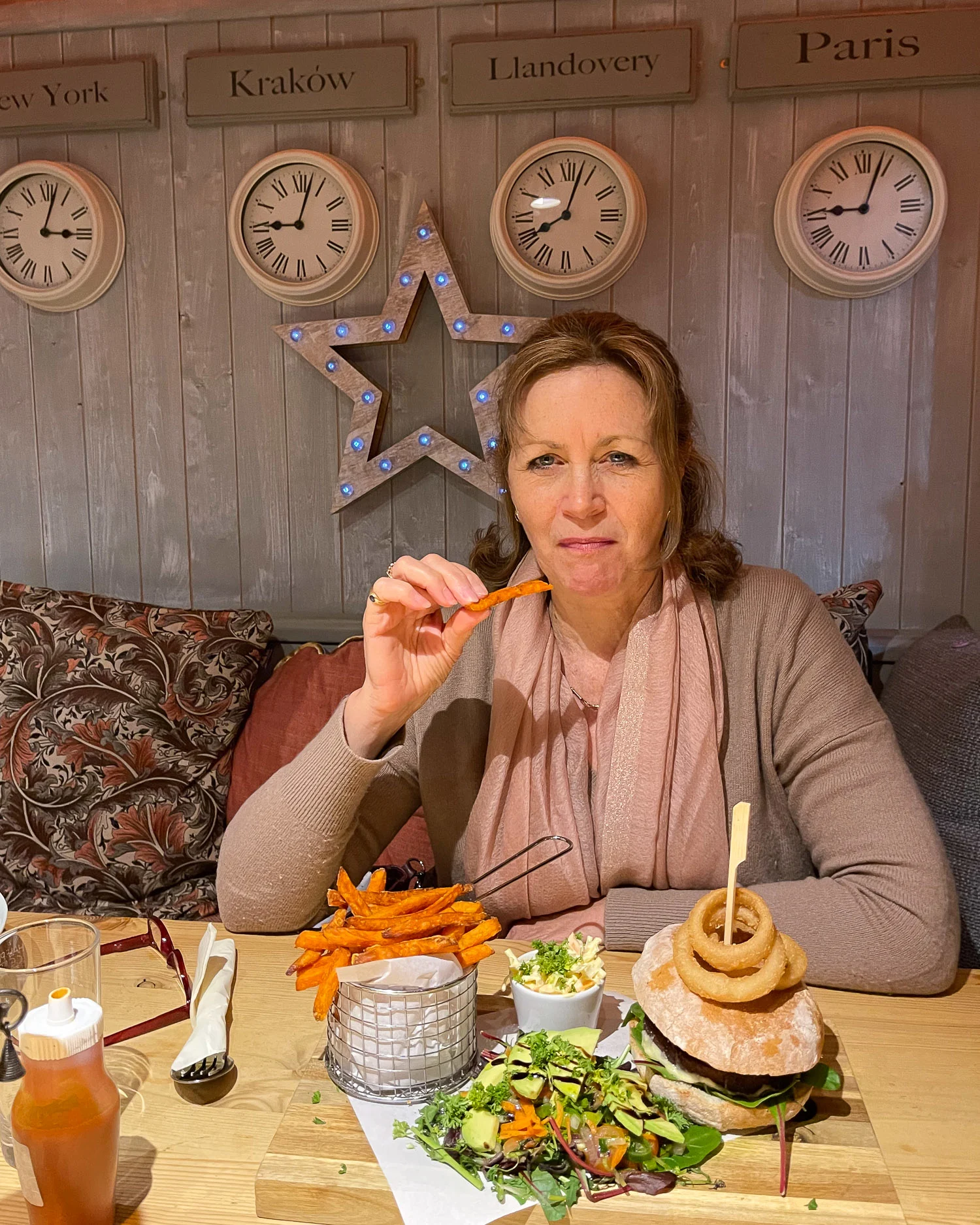
The Bear is also biker friendly! They welcome touring motor bikers who love the twisting, turning roads and gorgeous scenery of Carmarthenshire and often pass through the town.
Our beetroot and mushroom burger with sweet potato fries, salad and onion rings was worthy of any top notch pub fare, veggie or not! For something a bit different, we can highly highly recommend The Bear Llandovery .
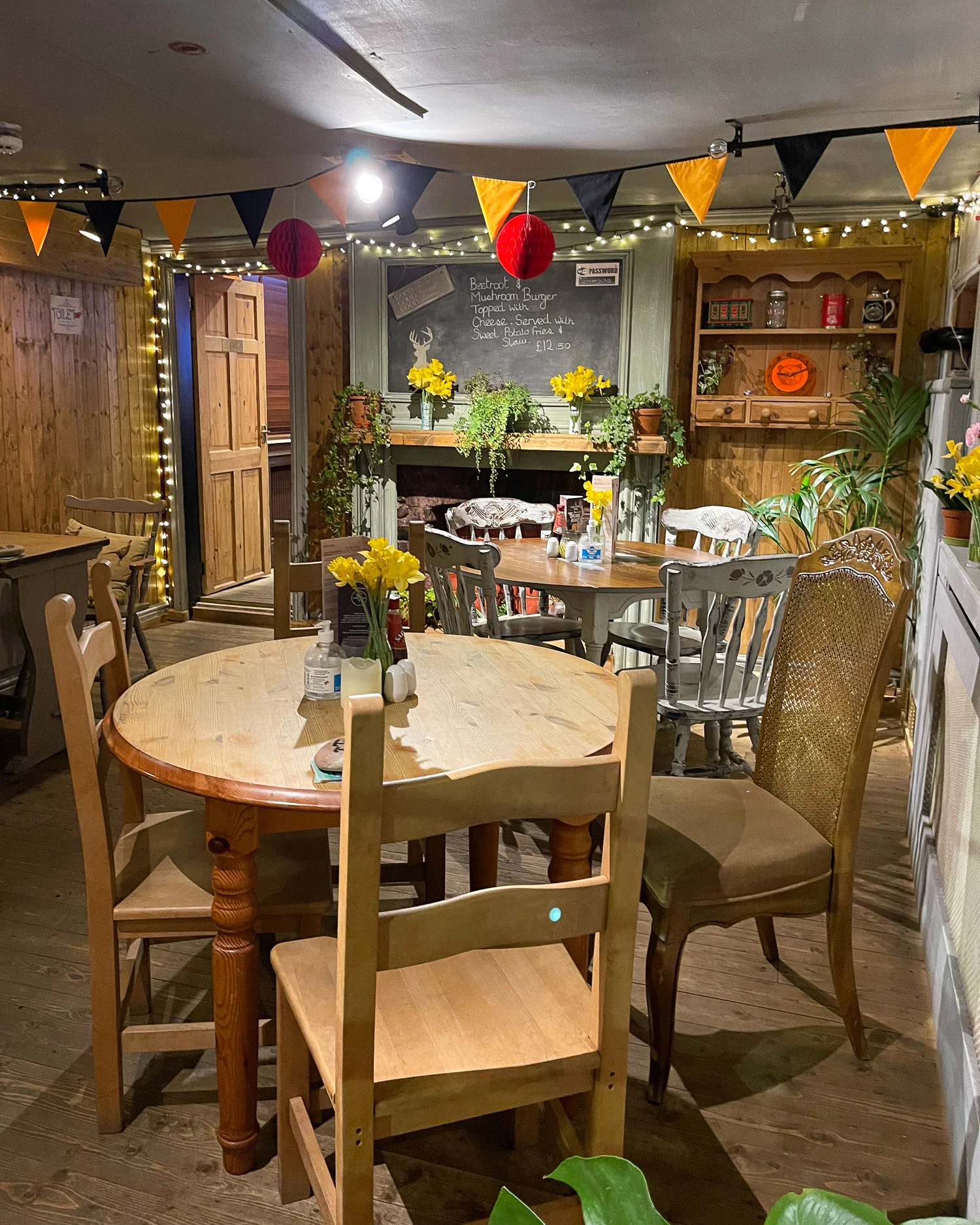
7 National Wool Museum – from fleece to fabric
Close to Newcastle Emlyn, in an old stone woollen mill is the National Wool Museum. Here is where we dipped into the history of the Welsh woollen industry. Using wool from the sheep grazing in the lush green fields nearby, mills like this were a big rural employer.
Workers transformed the fleece into woollen blankets and cloth. We enjoyed watching the old machines that are still in use, to follow the process of preparing the wool through carding, spinning, dyeing and finally weaving.
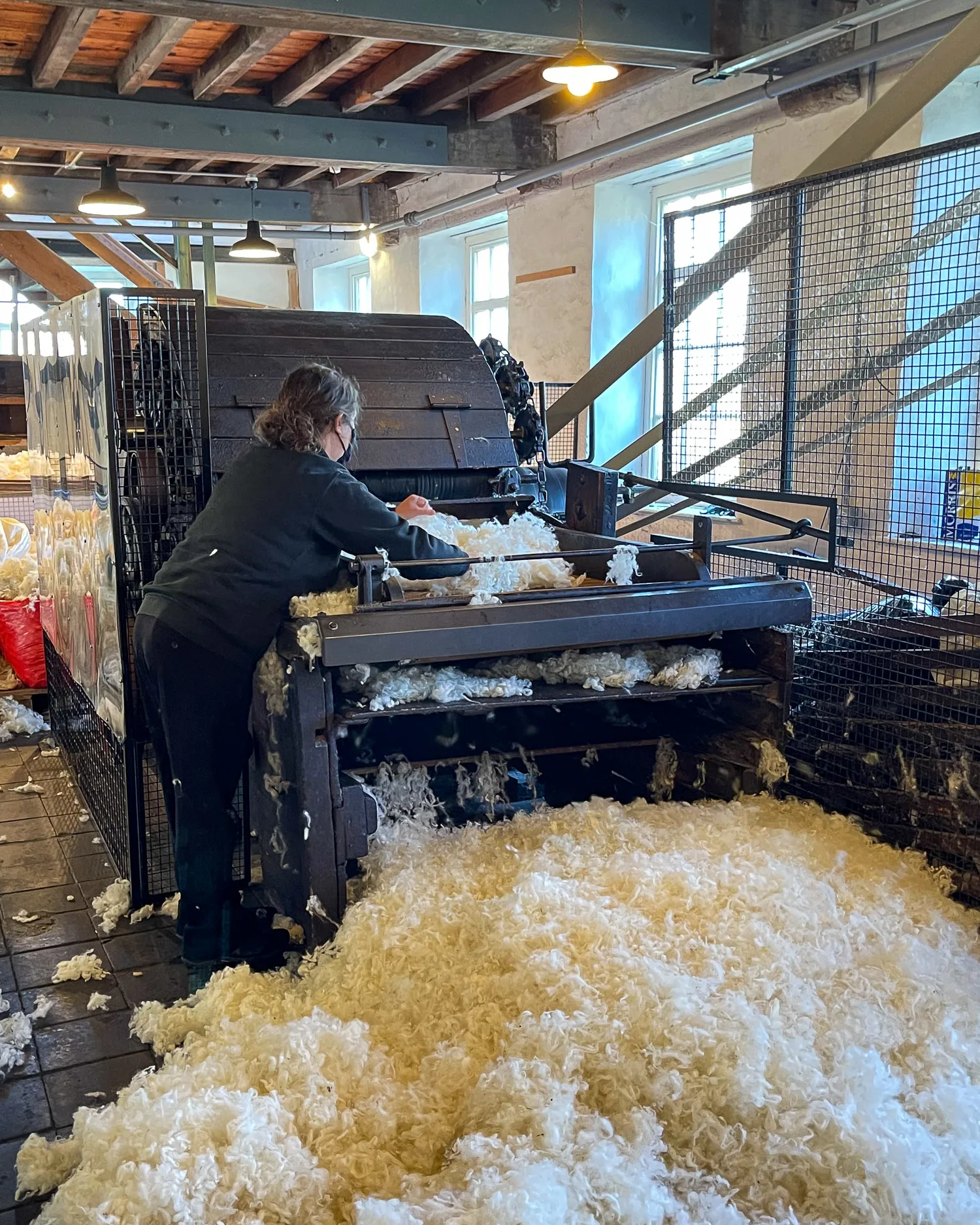
The Willower machine was in use while we were there, pulling the fleece apart and blowing it out in a soft cloud ready for carding and spinning. The machine was also known as “the devil”. Its sharp teeth made it dangerous to use if you caught a hand or arm in the machinery.
The fleece was then put through the carding machine. We also saw the looms set up, with the staff explaining the process of hand weaving the cloth and the metal links that created the pattern automatically.
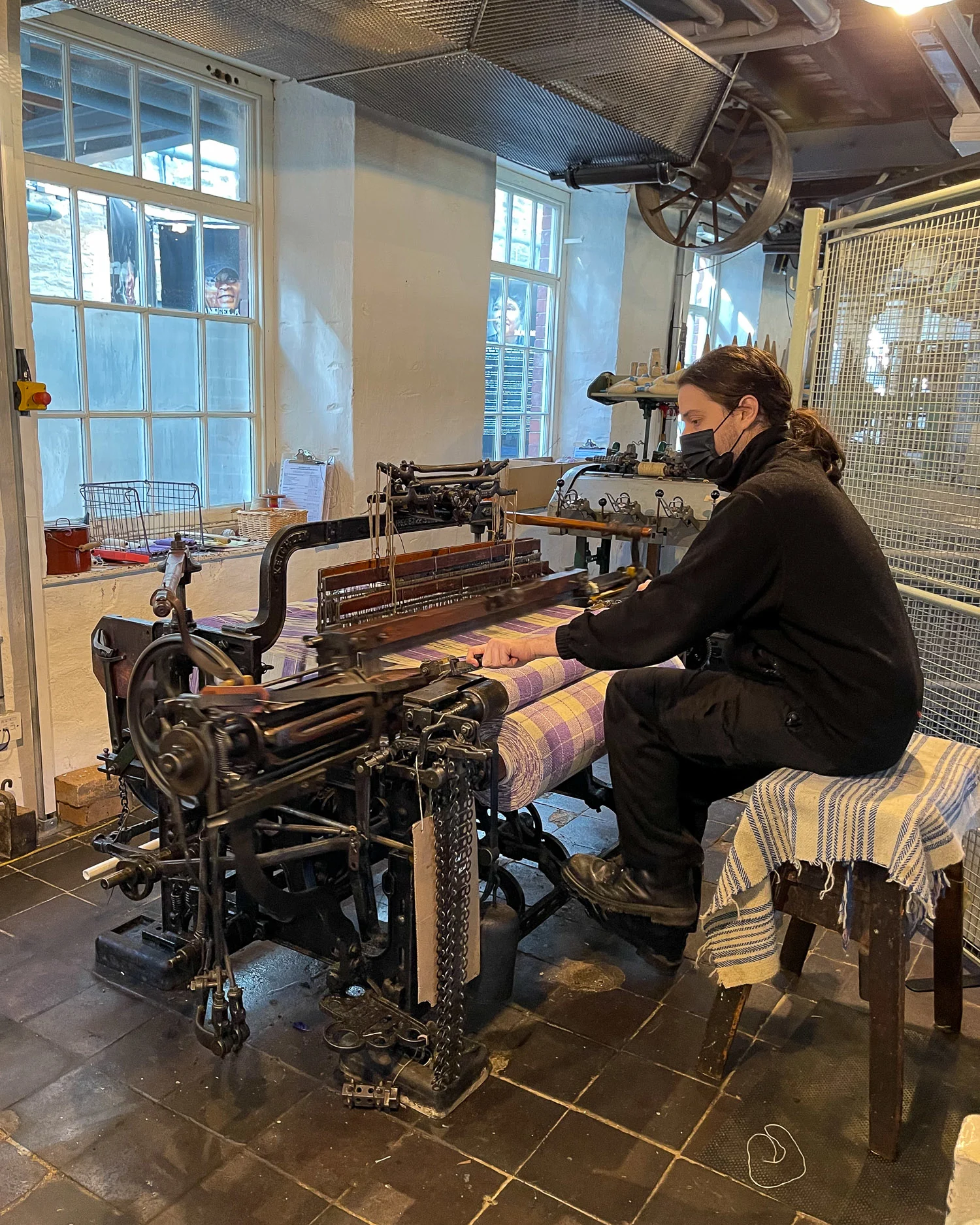
Later we walked through the interesting exhibition showing how Welsh woollen cloth and blankets were sold in draper’s shops. The tapestry designs became popular for fashions in the 60s and 70s. I loved looking at all the archive patterns of different Welsh blankets that you can still find in local antique and vintage shops.
The National Wool Museum is free to visit but you need to pre-book a ticket on the website.
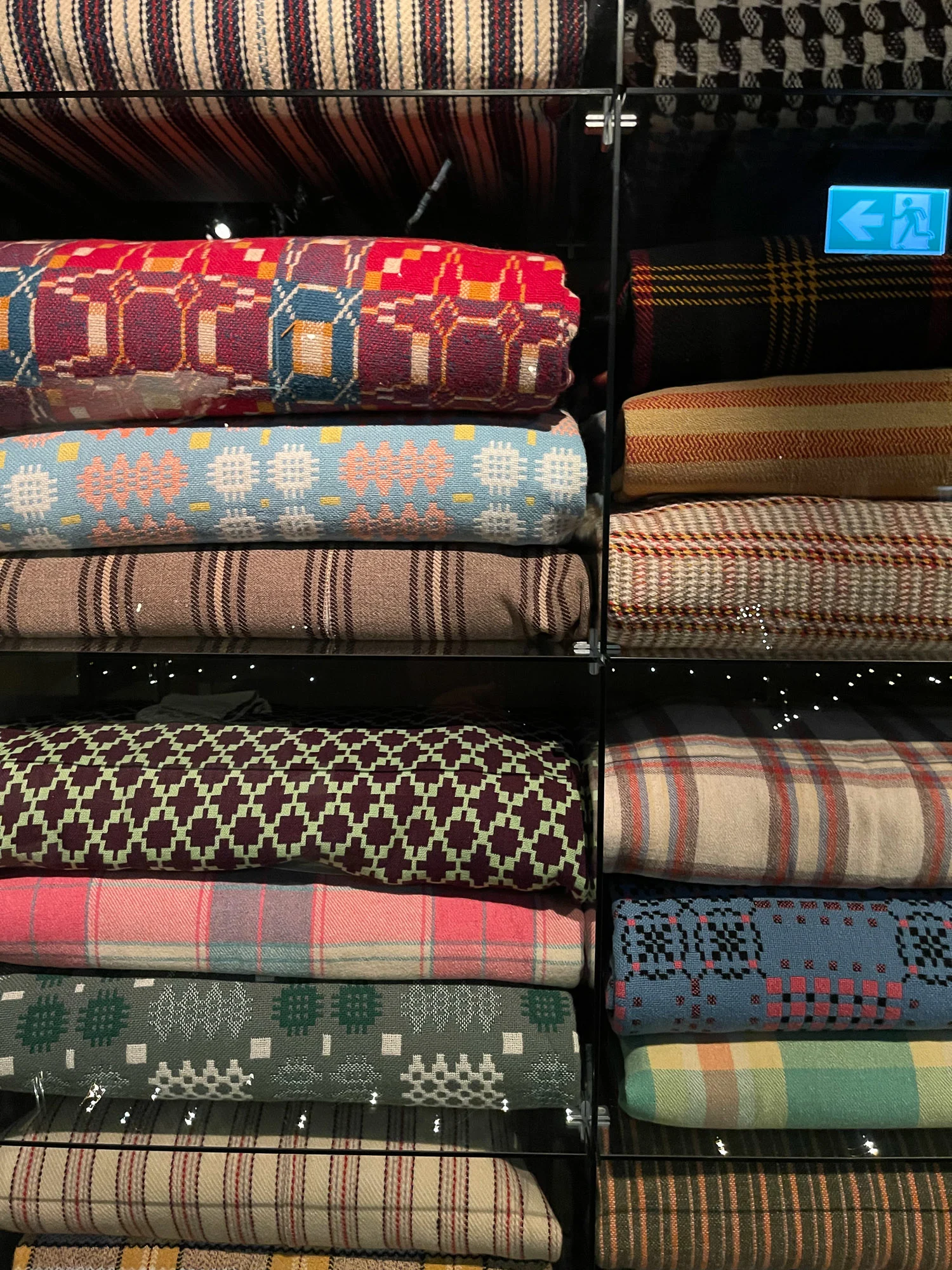
8 Newcastle Emlyn – a colourful country town
From the Wool Museum, we drove the short distance into Newcastle Emlyn itself. This small town had a bustling feel, full of small independent shops.
The coloured houses that we’d seen in Llandeilo also lined the high street here. There’s lots of lovely clashing colours on the shopfronts; orange and cobalt blue, lemon yellow and fuschia, soft blue and grey.
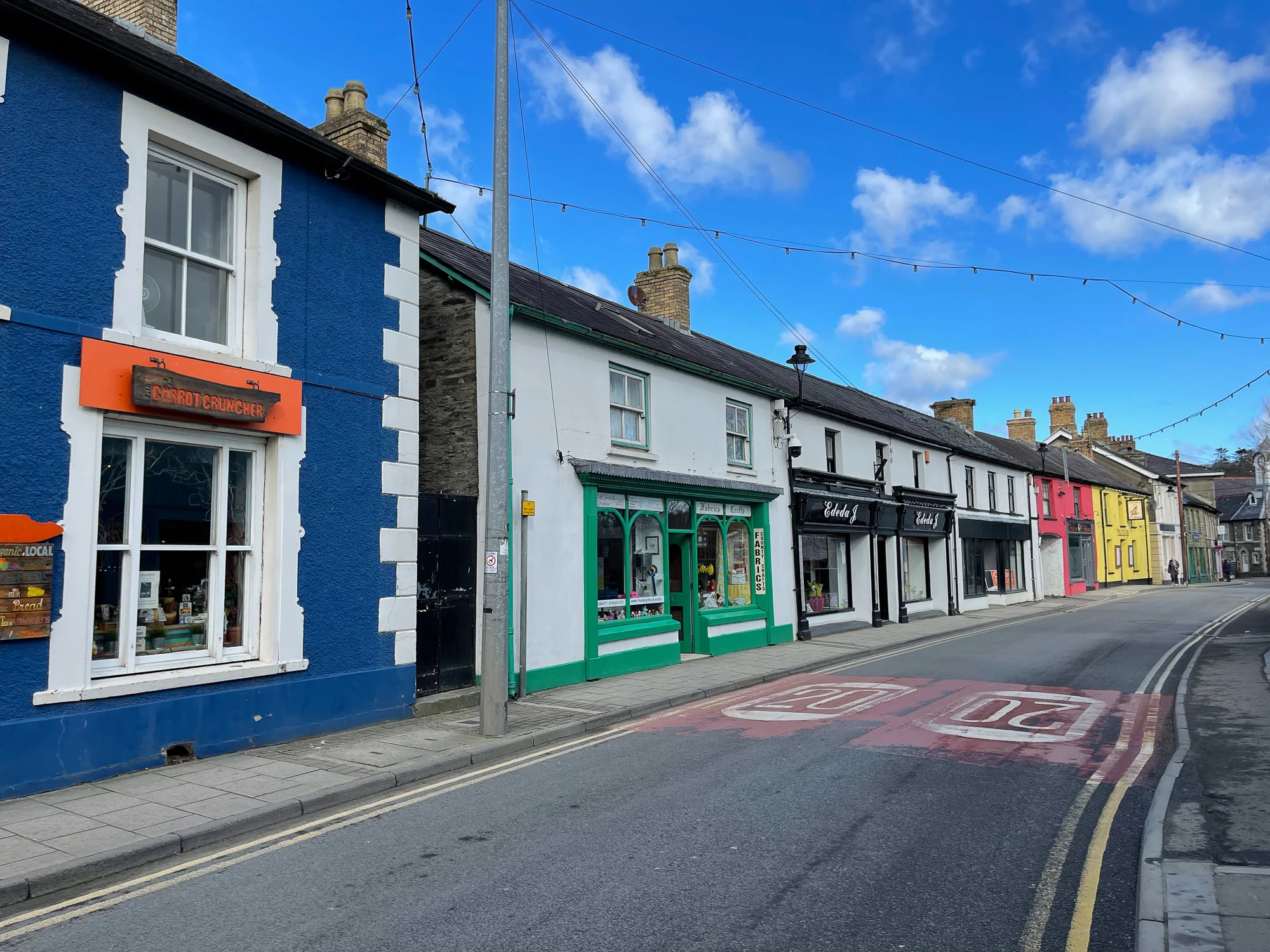
Newcastle Emlyn is a fun place to browse for antiques and vintage, at the Vintique Shop with pretty homeware and the Antique Centre. We were tempted by the piles of vintage Welsh Blankets.
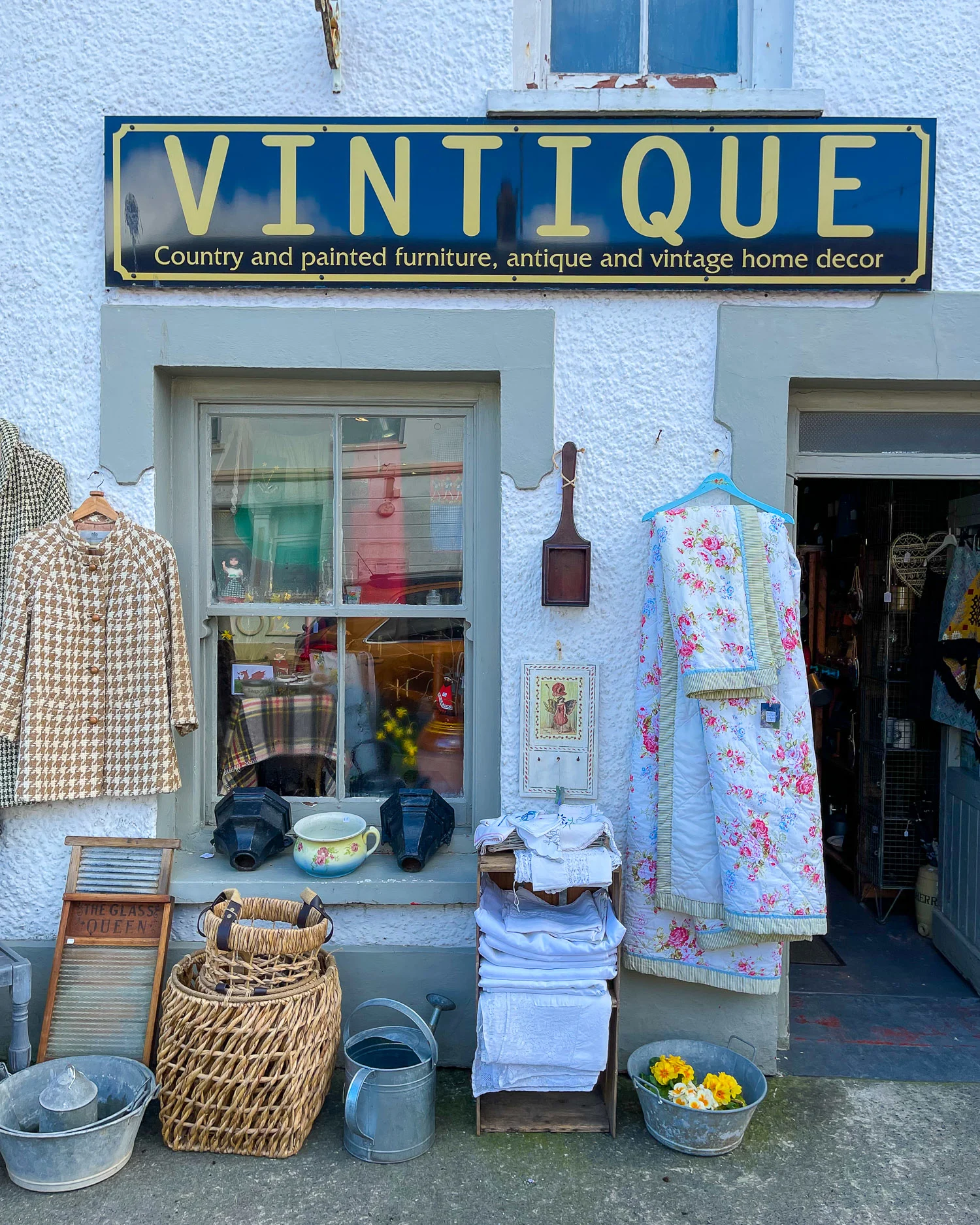
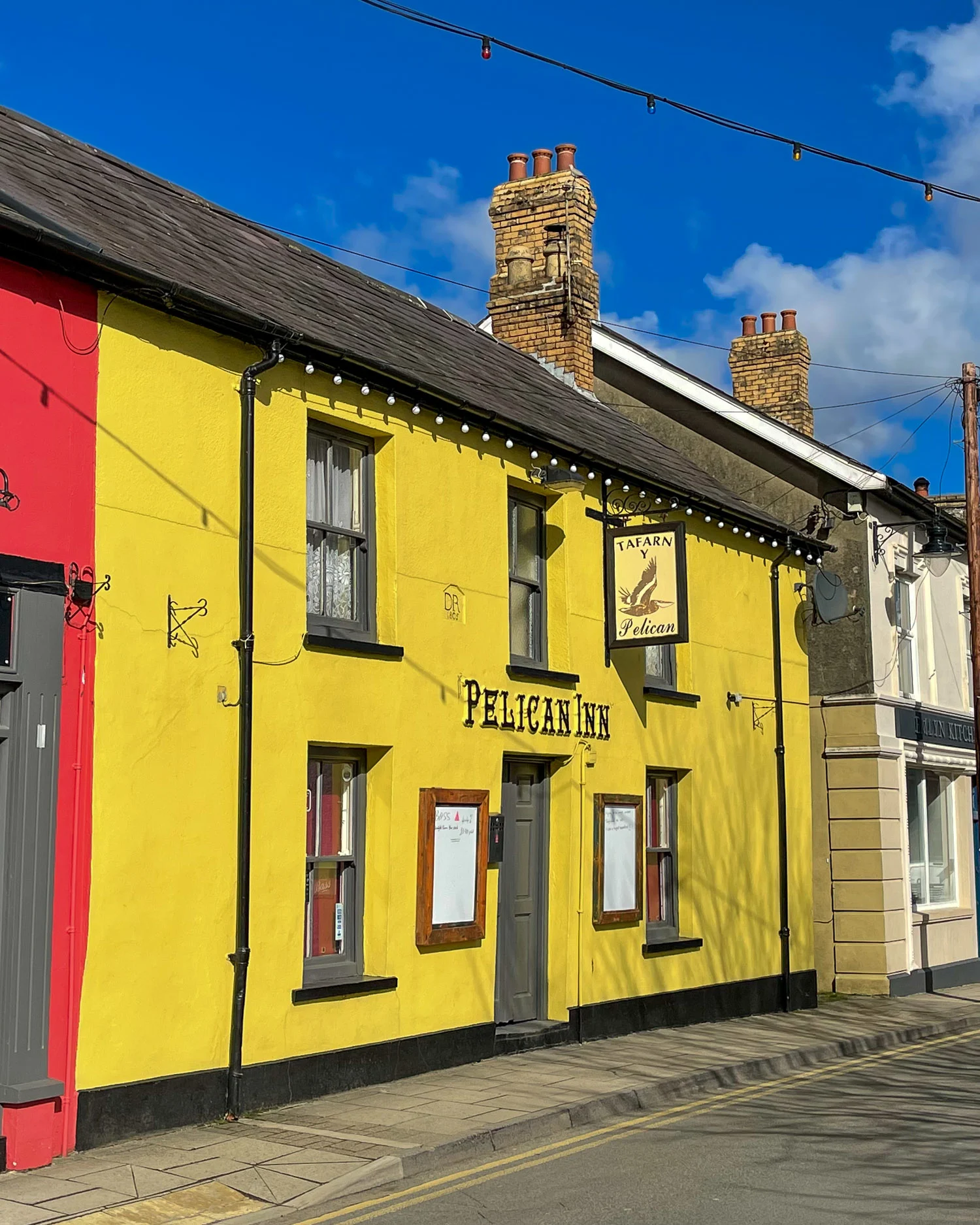
Continuing down the high street we stopped for lunch at the Petit Biarritz deli, who have a couple of tables to serve coffees and light lunches. They stock products from Spain, France and the Basque country.
From the short lunch menu I tried a very tasty feta and spinach filo. Guy loved his home made fish cakes, both served with a side of salad.
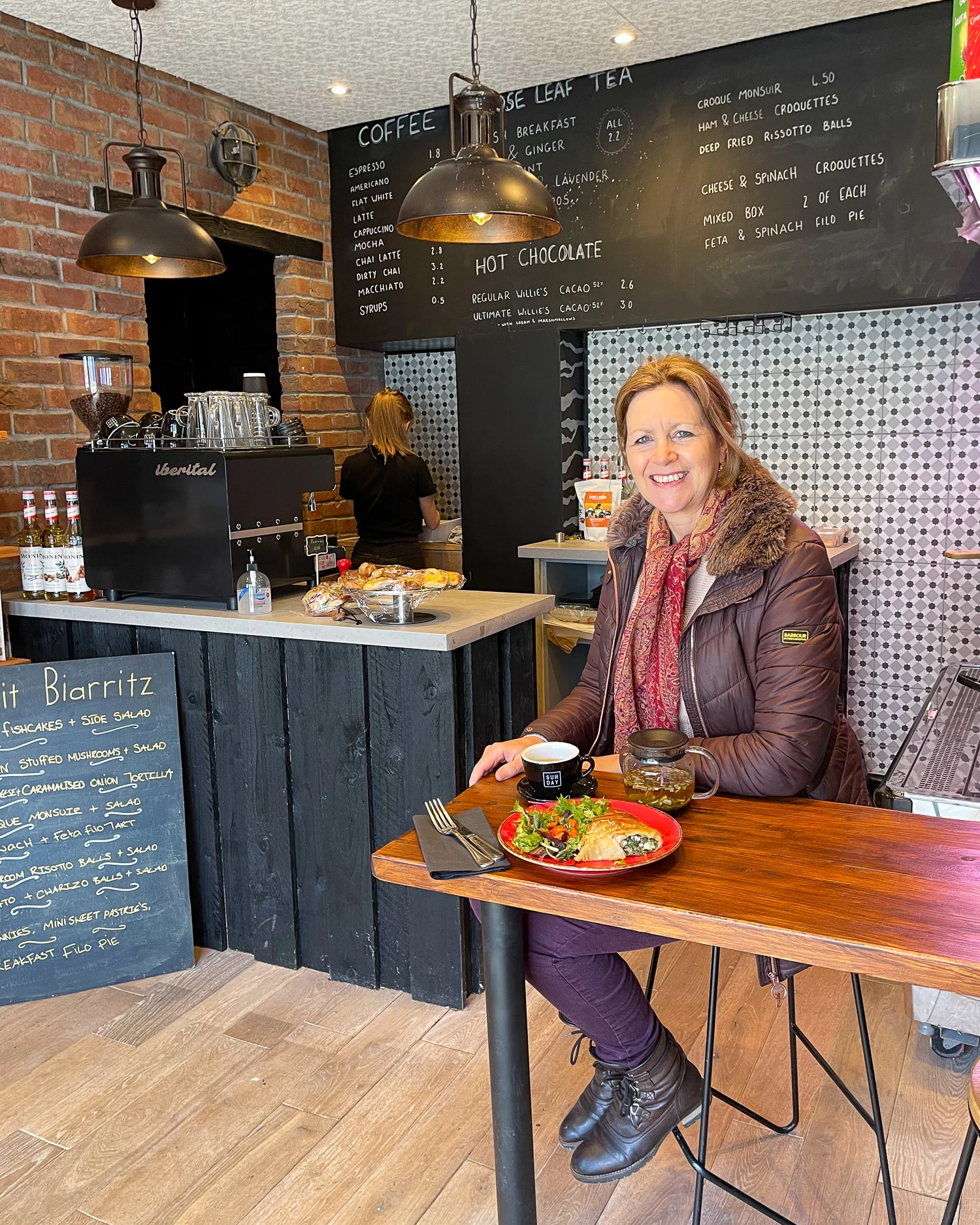
More information to plan your visit to Newcastle Emlyn on the Discover Carmarthenshire website.
9 Newcastle Emlyn Castle – and the golden dragon
Just a short walk from the high street are the ruins of Newcastle Emlyn Castle. It was built in a natural defensive position overlooking the bends of the River Teifi.
Constructed in the 13th century, the castle changed hand several times and was finally blown up in 1645, during the English Civil War. Over the gate to the castle sits the golden dragon who is also commemorated in a mosaic plaque and dragon seat (although it’s lost its head) within the castle.
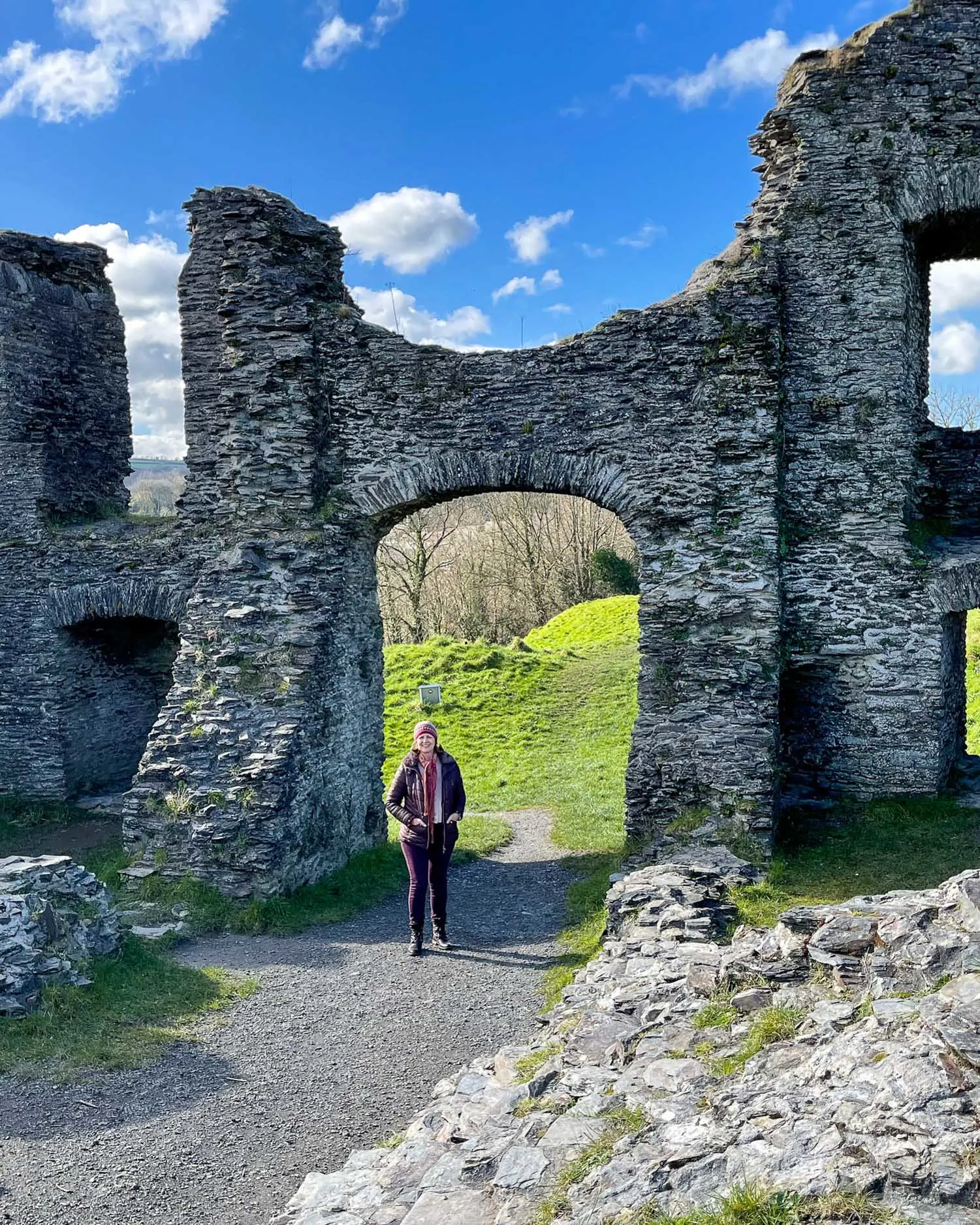
The legend is that Gwiber Emlyn, the last dragon in Wales, terrorised the town of Newcastle Emlyn. The dragon was finally lured down by a red cape laid down by a brave soldier. The soldier speared and killed the dragon as it flew down.
Only a few walls of the castle remain, but there’s a river walk around the base of the castle and the curve of the river. This path continues all the way to the village at Cenarth. You’ll find a leaflet and map about the walk from Cenarth to Newcastle Emlyn here.
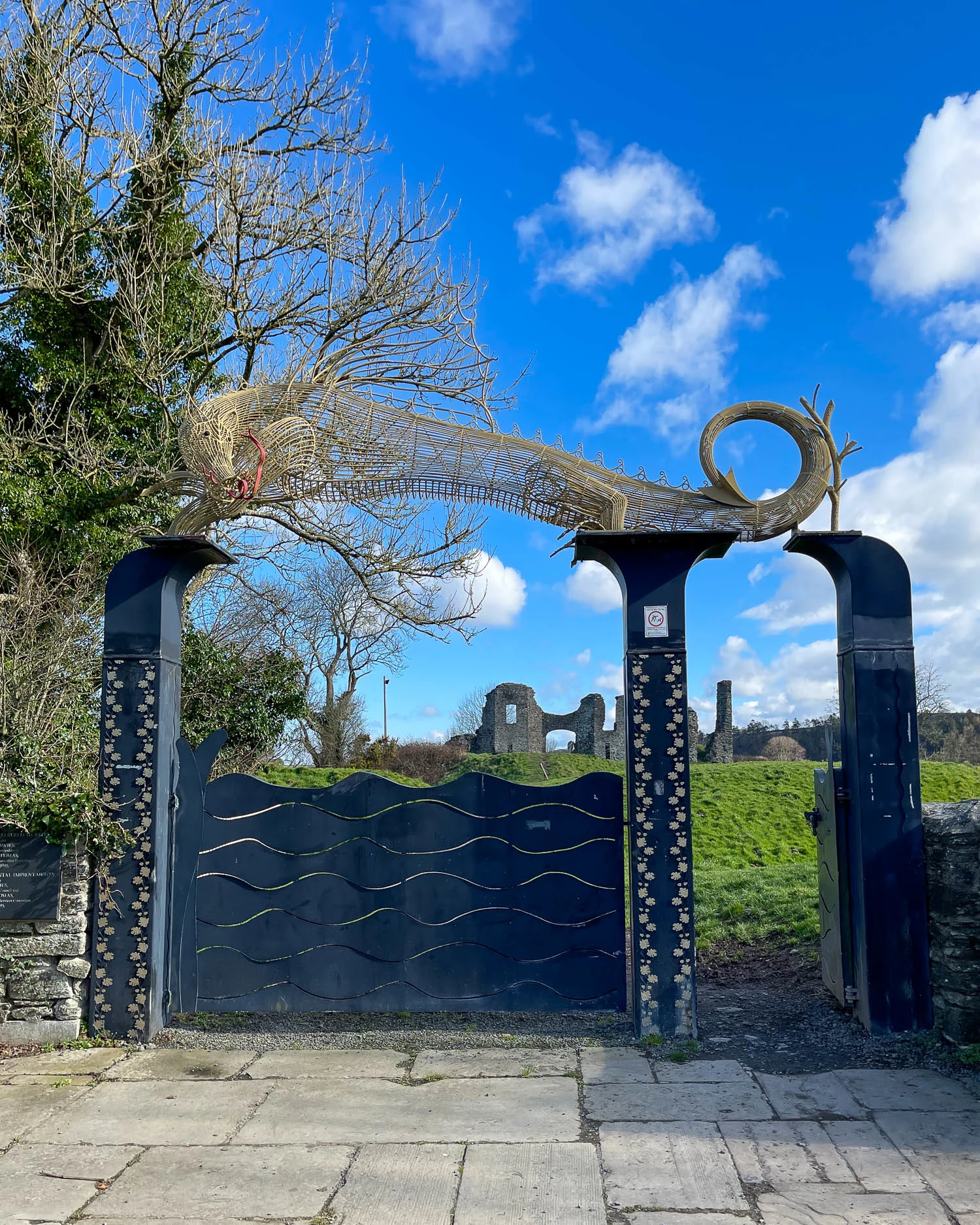

Stay at the stylish boutique hotel The Cawdor in Llandeilo – this was the base for our weekend in Carmarthenshire
10 Cenarth falls and stone bridge
A short drive from Newcastle Emlyn, we finished the day at Cenerth. The old stone bridge over the river Teifi is a great place to stop for a picnic.
There are picnic tables on the south side of the bridge near the White Hart Inn. Or, you can sit on the large boulders on the other side of the river by the main car park.
The 18th century stone arch bridge has some curious holes in it which I thought might be to let the river water rush through in times of flood. They also reduce the weight of the stone bridge without reducing its strength.
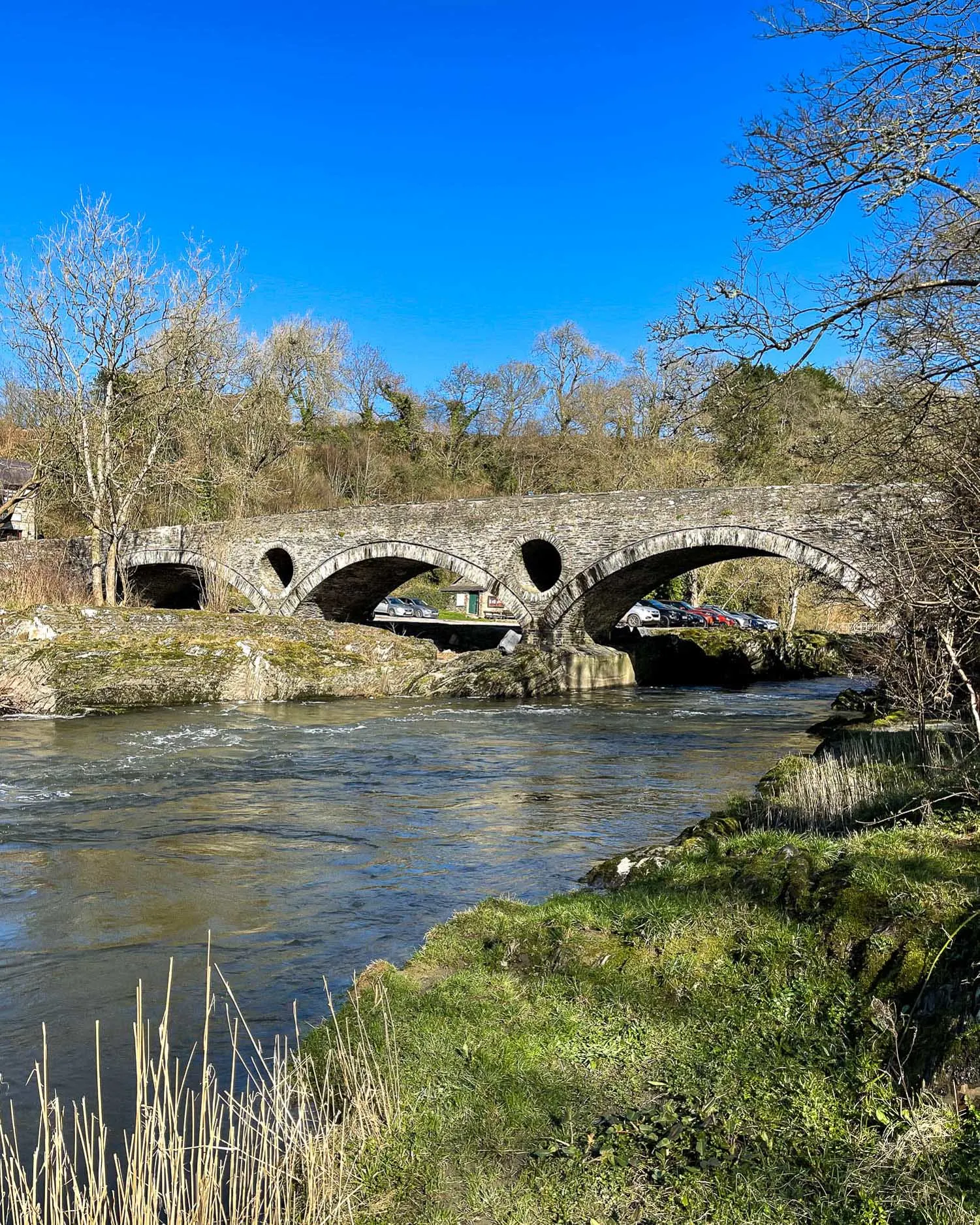
Just upstream from the bridge, the Cenarth falls make a magnificent sight as they cascade over the rocks. In autumn the salmon return to their spawning grounds and leap the falls to get up river.
Traditionally the salmon would be fished from coracles, small round boats made on a wooden frame. These light boats could easily be carried from place to place.
National Coracle Centre
Beside the bridge is the National Coracle Centre to find out more about the ancient craft. You can sit in a coracle like a fisherman, although it was closed when we visited.
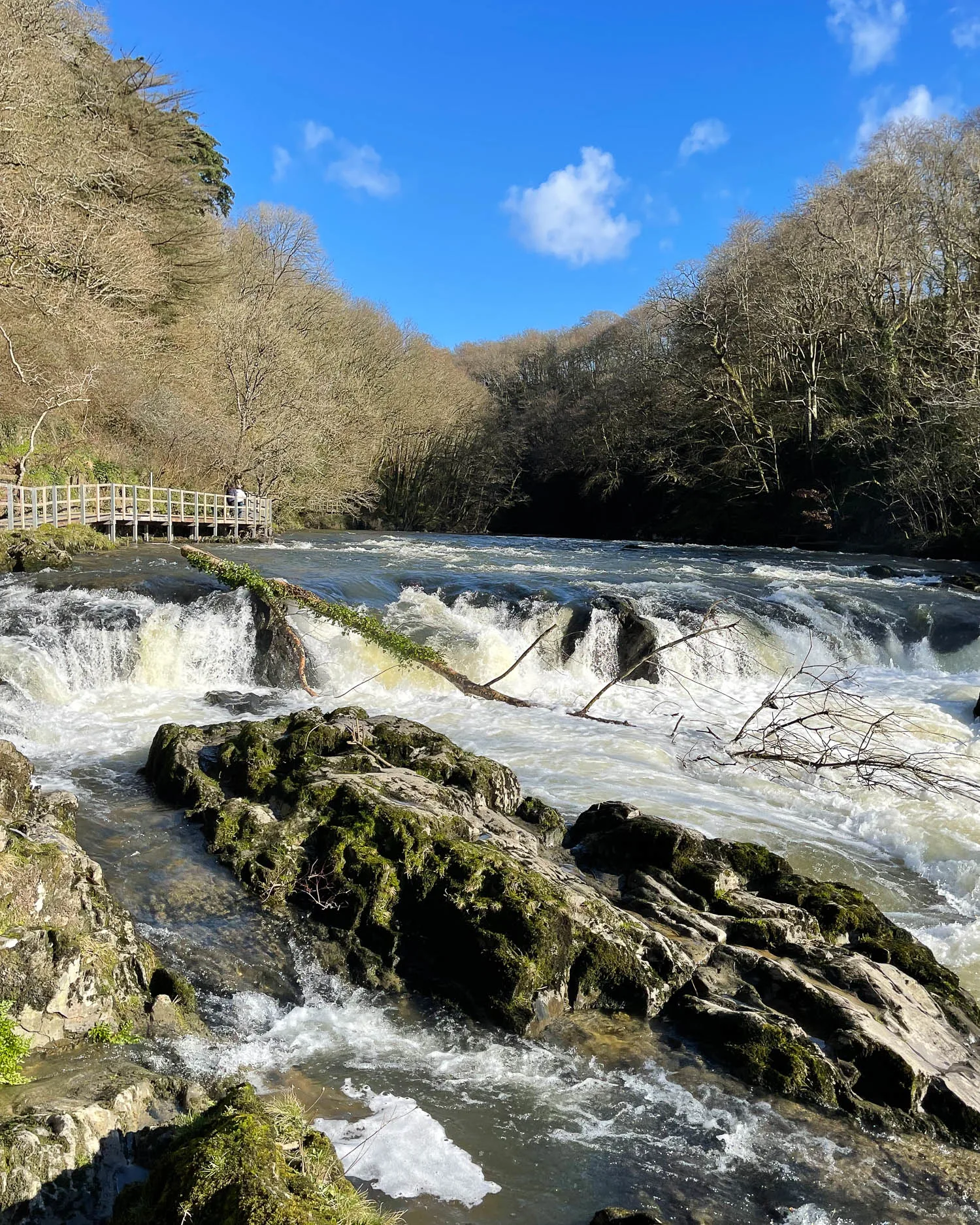
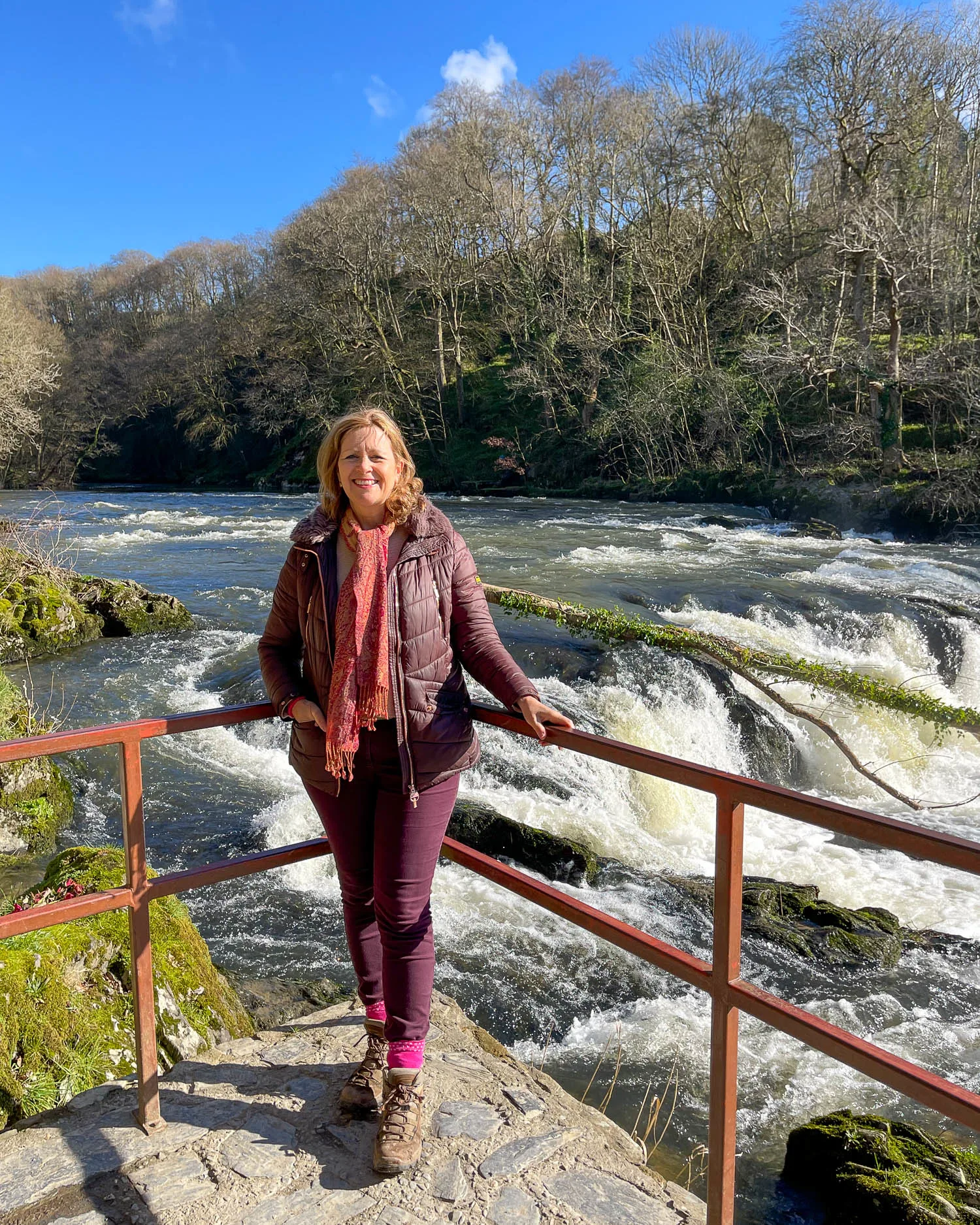
There’s an easy stroll along the riverside boardwalk. The path is buggy friendly and takes you above the muddy bank for a nice stroll with views of the Cenarth waterfalls.
If you fancy a longer walk, you can continue on the footpath as far as Newcastle Emlyn. You’ll find a leaflet and map about the walk from Cenarth to Newcastle Emlyn here.
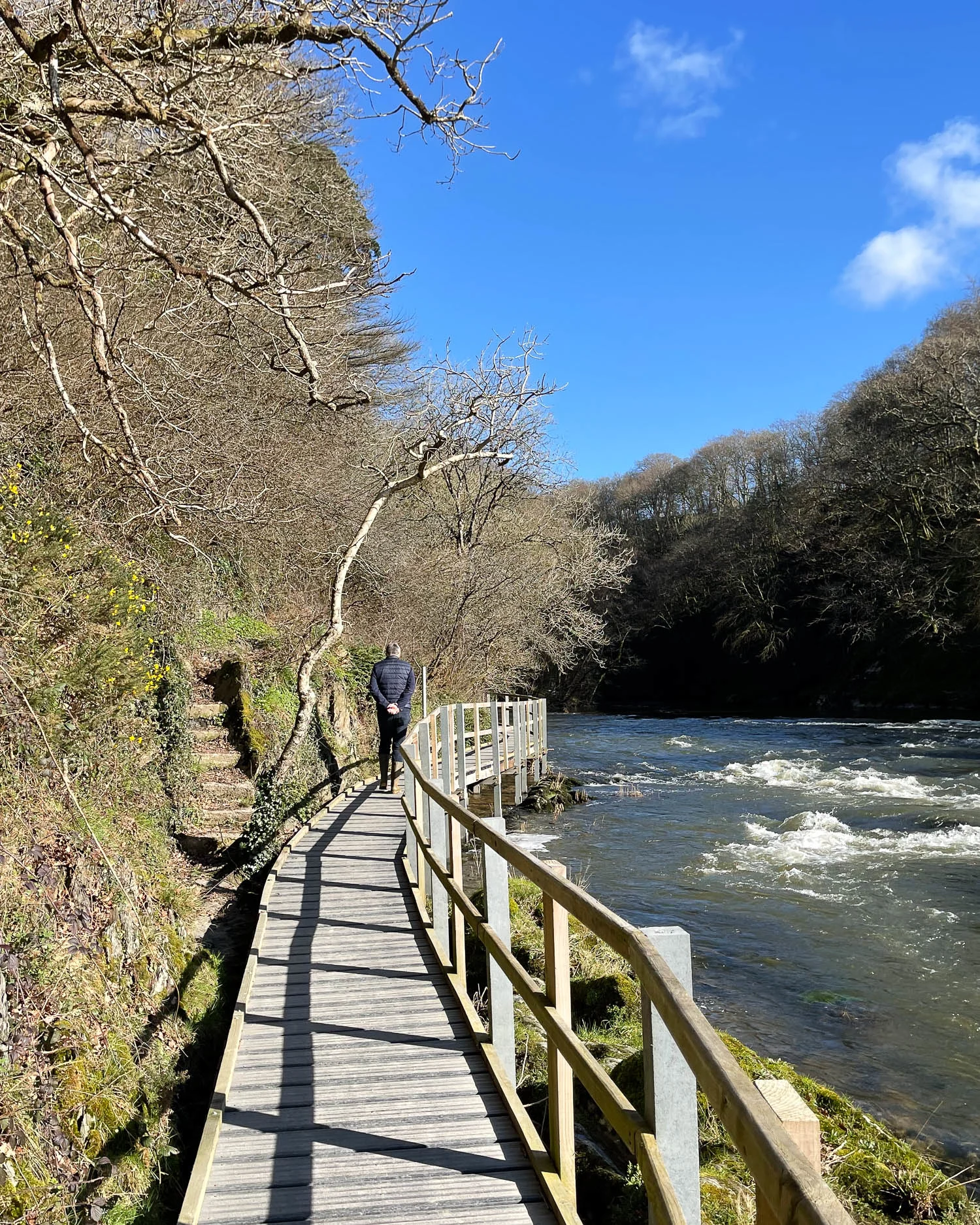
We followed the boardwalk as far as it went to a bend in the river instead of the full walk, as we had afternoon tea planned at the Ty Te Cenarth tearooms. This friendly cafe is close to the bridge.
Here we indulged in the Coracle Cream tea, which included Bara Brith (Welsh fruit bread) and a Welsh tea cake. Also included were warm scones with jam and cream. It was a great way to end our walk and day around Newcastle Emlyn on the western edge of Carmarthenshire.
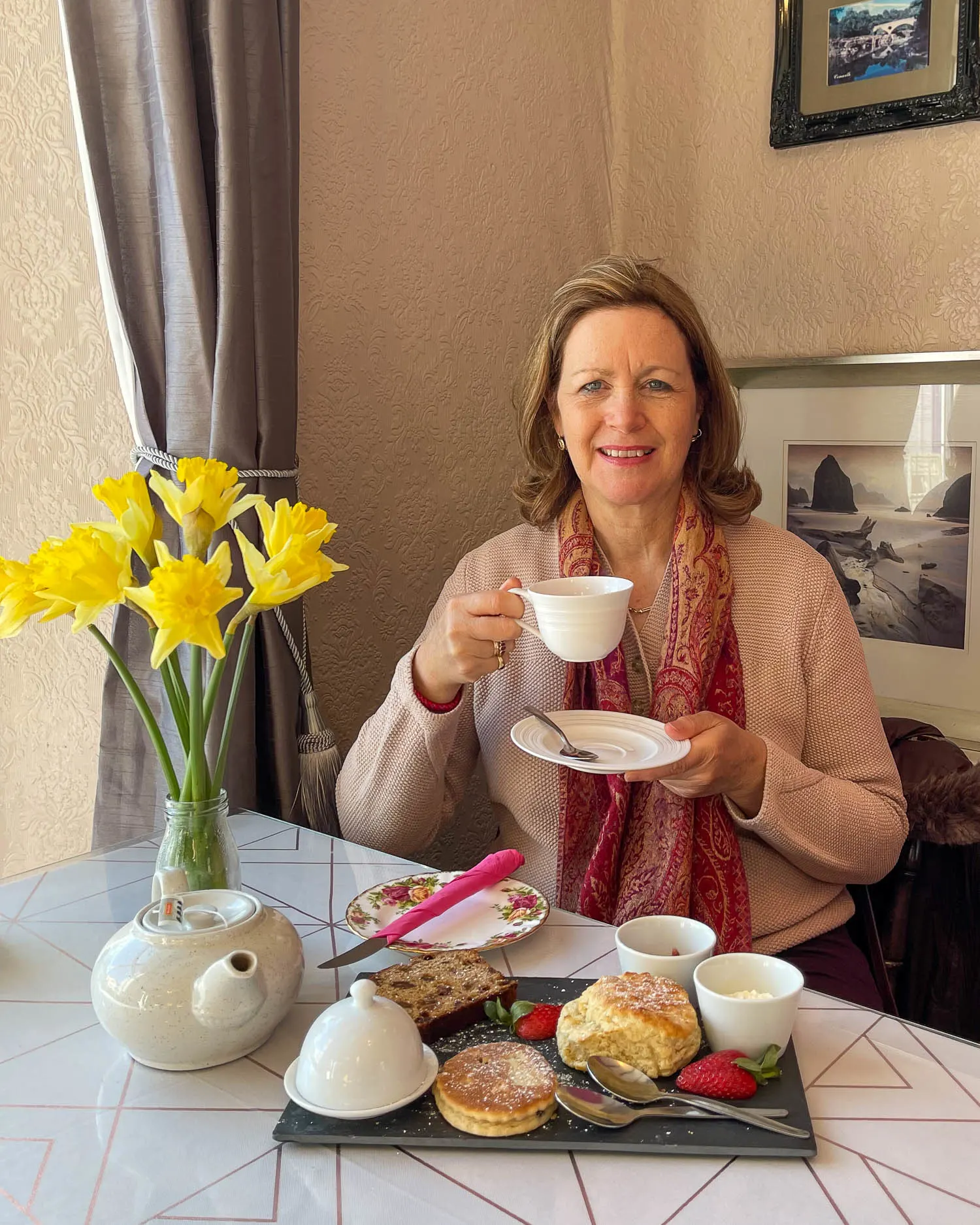
11 National Botanic Garden of Wales
The National Botanic Garden of Wales of one of the jewels of Carmarthenshire. It’s a big reason that the county is known as “the garden of Wales”. You could easily spend a full day here, especially if the weather is fine and you take a picnic. We spent just a morning and really enjoyed our visit.
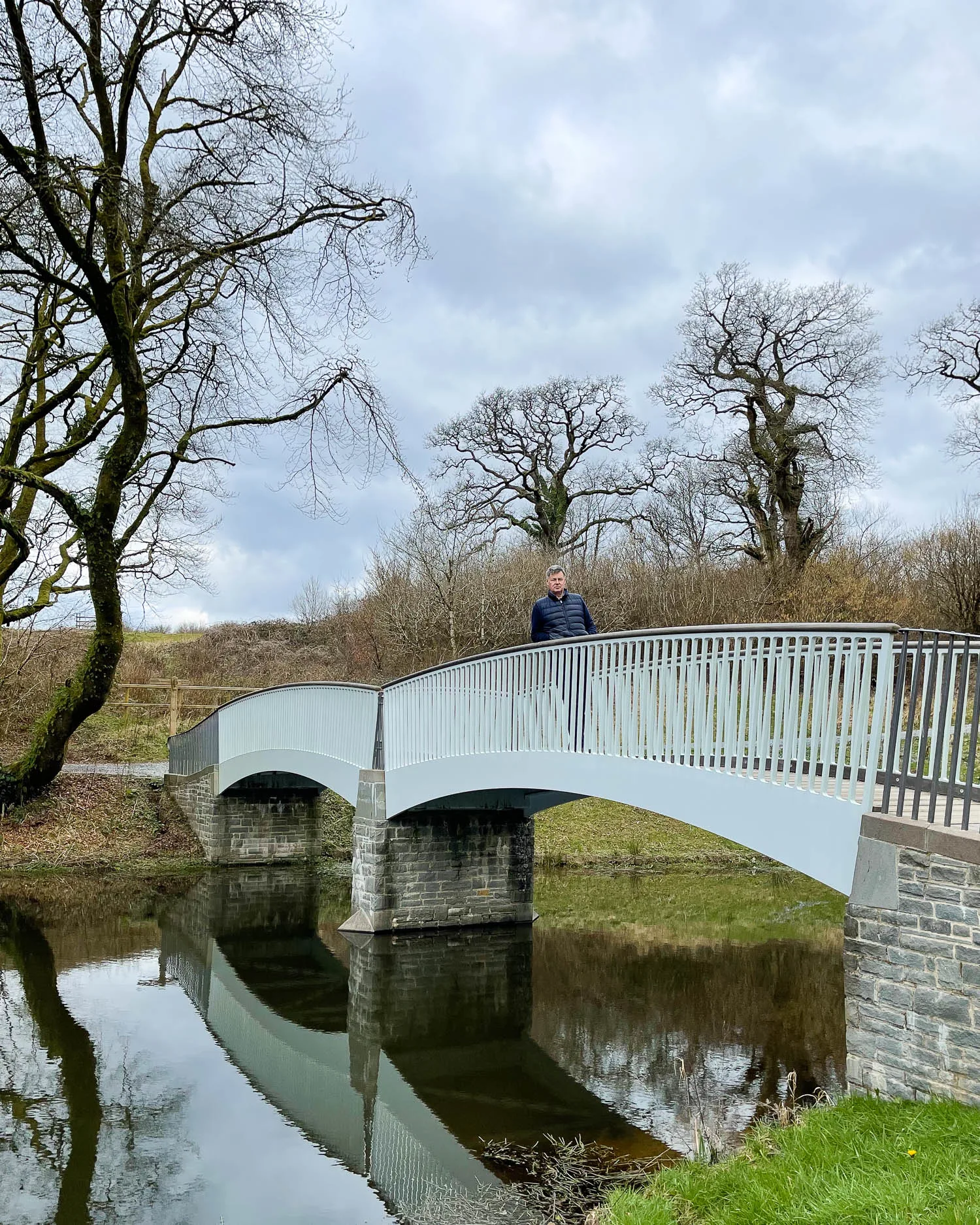
We started with a walk around the Regency water garden with its string of lakes, ornamental cascades and bridges. This has been restored over the last few years in a £7 million project.
Tip: If you are short of time or don’t want to walk so far, ask one of the volunteers to take you down to the lakes in the free golf buggy service. Then, you can walk back up as we did.
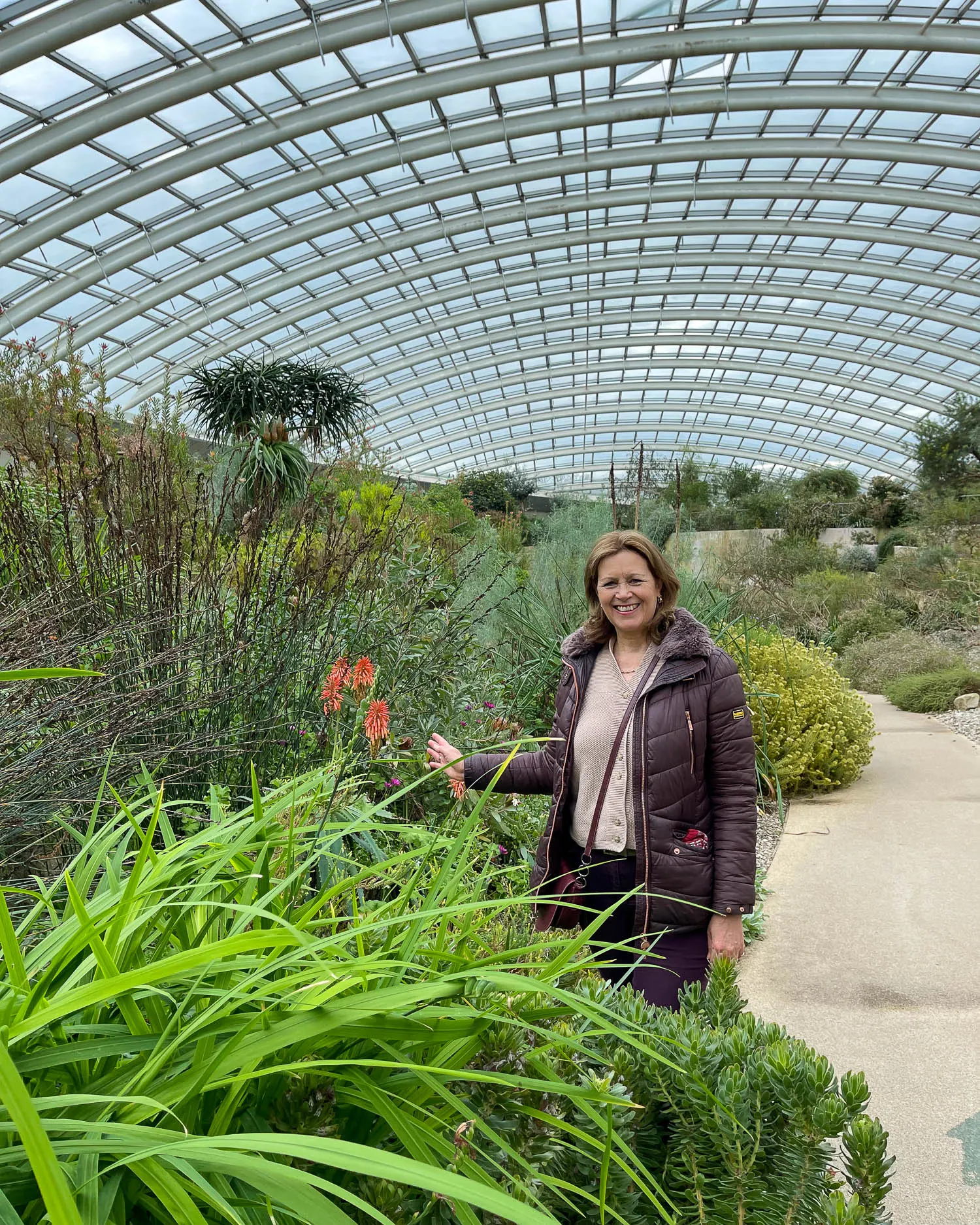
The glasshouse dome
We admired the watery reflections and bridges across the water. Then we made our way back from the lakes to the central attraction of the gardens, the glasshouse dome, designed by Norman Foster.
The dome is buried into the hillside and is the largest single span glasshouse in the world, housing Mediterranean plants from all over. We meandered through the different planting areas, from Chile and the Canary Islands, to Australia and South Africa. Check out the pool and cascade of water that is hidden in the centre of the dome.
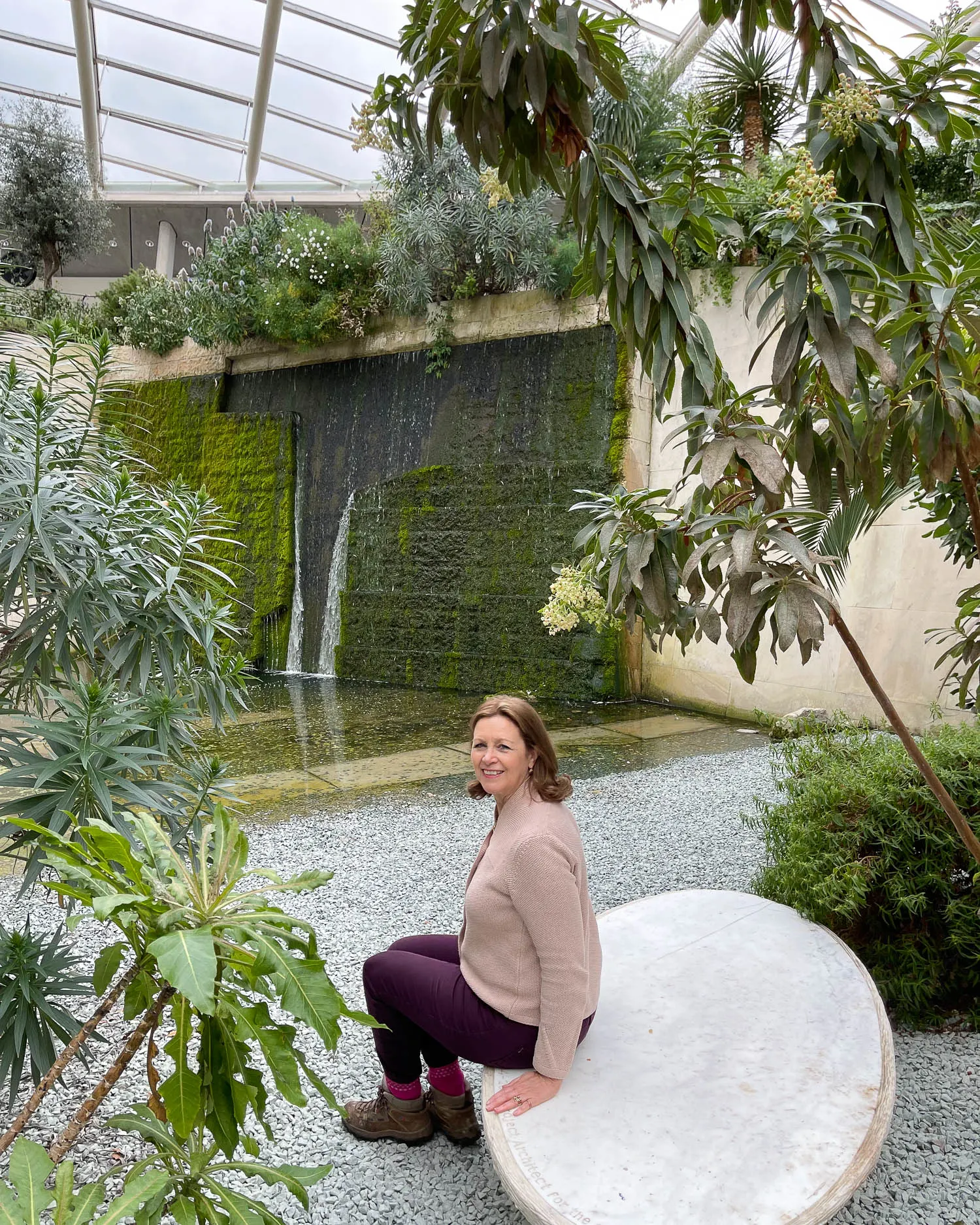
There is not much left of Middleton Hall, the mansion that once stood within this parkland, although you can see the brick footprint of the rooms. Nearby take a look through the Pi sculpture which is carefully placed to frame a view of Paxton Tower on the distant hillside.
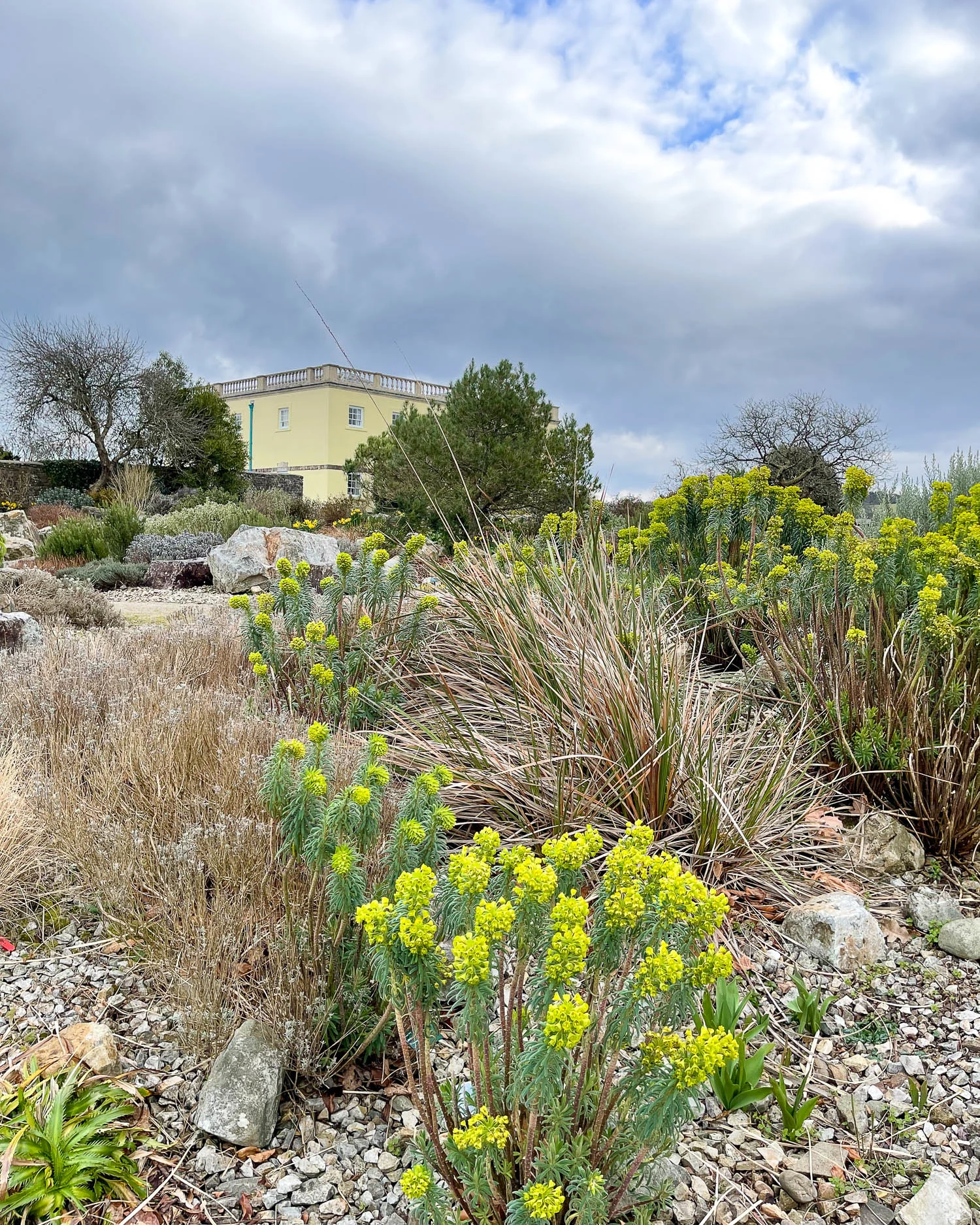
A stableblock at the Welsh botanical garden has been restored to house the tea rooms and gift shop. We walked down through the pretty gravel garden full of aromatic Mediterranean plants.
The double walled garden with its formal topiary and plantings was full of hellebores in flower. There were plenty of spring bulbs and tulips about to burst into a mass of colour. This really is a garden for all seasons and one of the must see places to visit in Carmarthenshire.
More information to plan your visit on the National Botanic Garden of Wales website.
12 Llansteffan – a beach walk on the Tywi estuary
There’s nothing like a blustery beach walk to blow away the cobwebs. The coastal town of Llansteffan was a gorgeous spot for our Sunday afternoon stroll. Parking by the beach, we joined the dog walkers and families enjoying the sand and wide open skies in this pretty holiday town on the Tywi estuary.
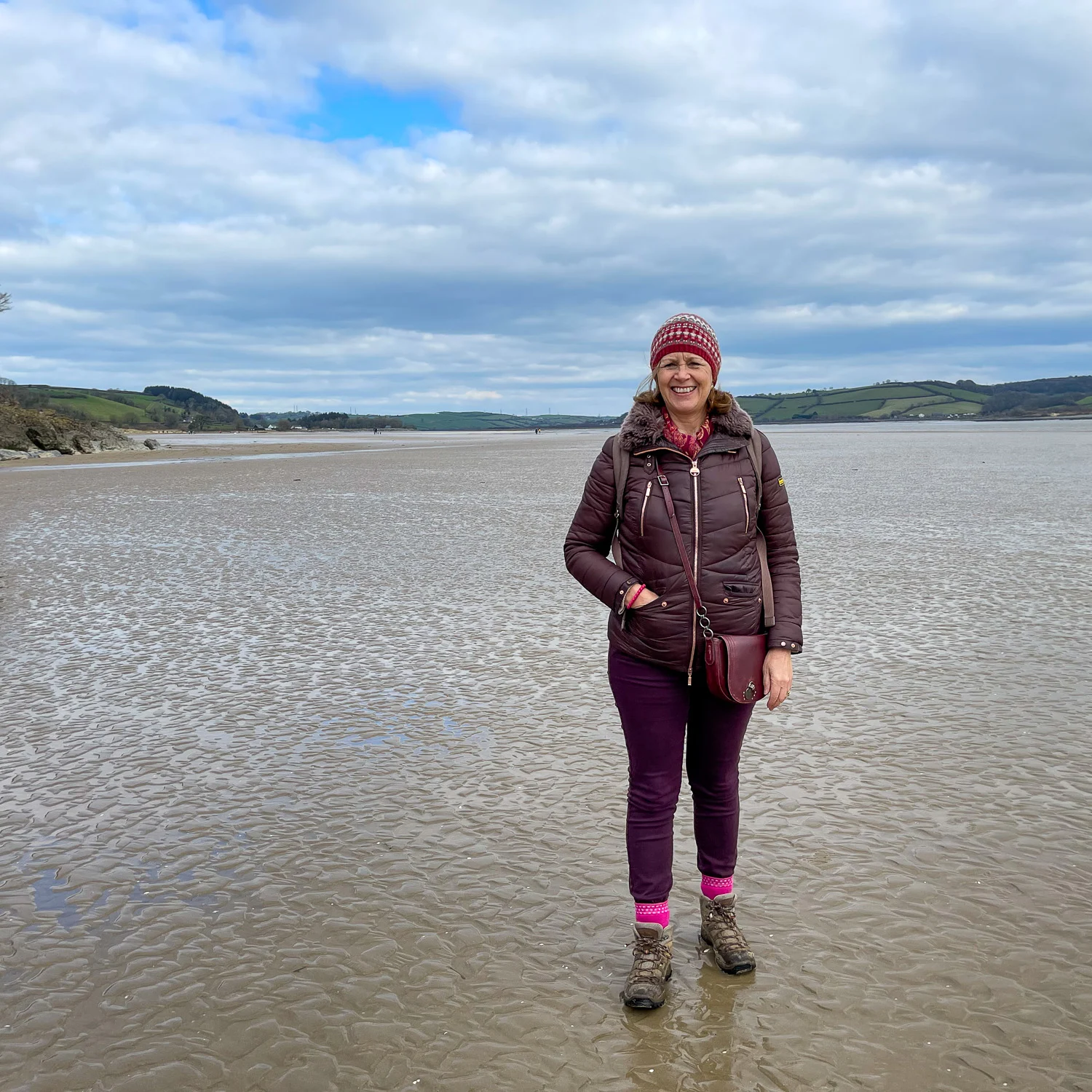
Since the Middle Ages, the estuary mouth and river provided a route for goods to be transported inland and for local fishermen and cockle collectors to make a living. With the coming of the railway in 1852, holidaymakers could catch the train to Ferryside across the river.
Then they could take the ferry across to Llansteffan for a day out. This was a popular summer excursion from the mining valleys of South Wales.
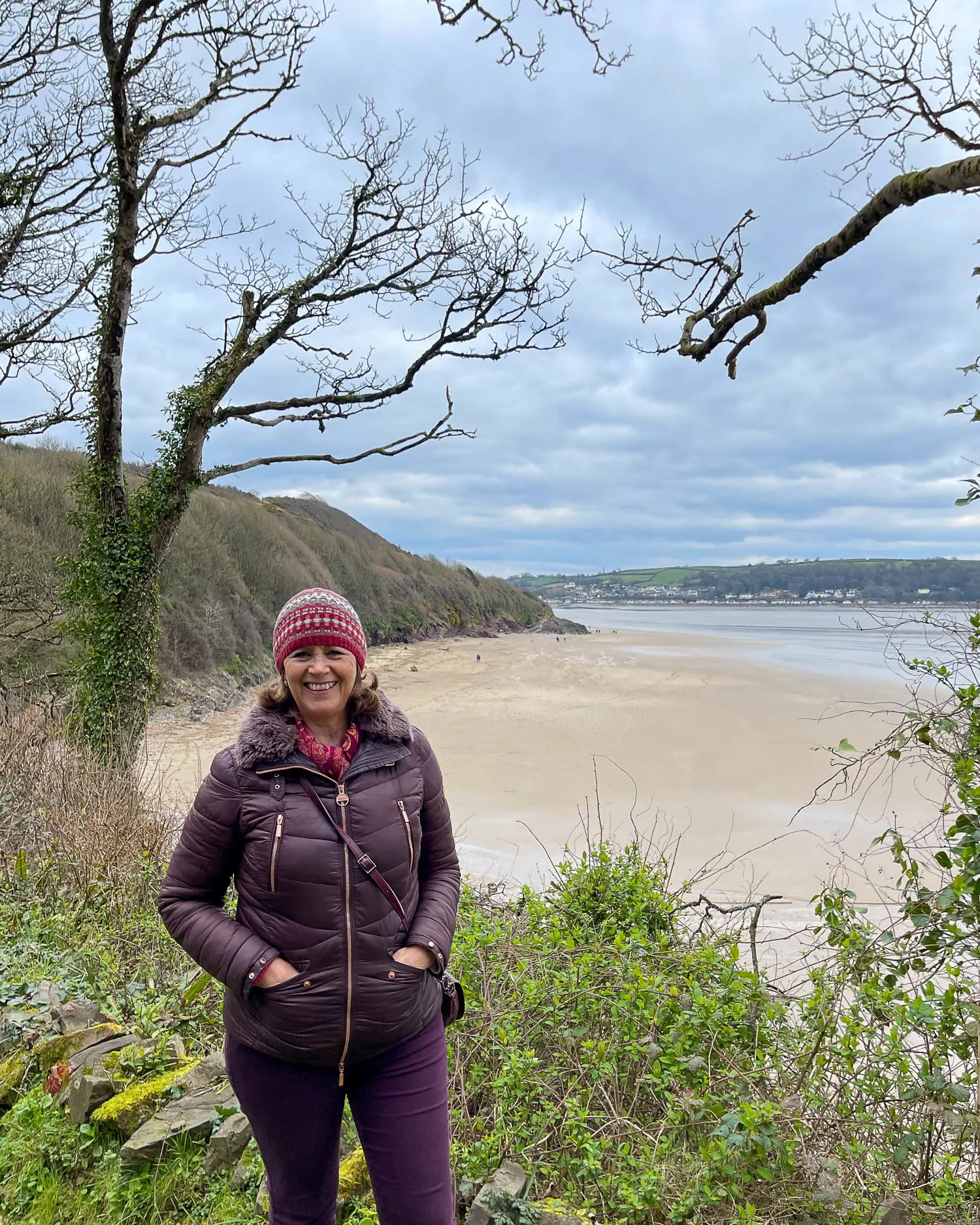
At low tide you can walk right along the beach and around the headland to Scott’s Bay where the Wales Coastal Path continues along the cliff. We followed the beach and took a brief detour up the lane by St Anthony’s cottage, to see St Anthony’s Well. The well is known for its healing waters, although it had been damaged in recent storms.
We returned via the cliff path, lined with banks of primrose until we climbed up onto the high ground to see Llansteffan castle. There are numerous extensions of this coastal walk around Llansteffan. Many loop inland and take you back to the village along pleasant country lanes and footpaths.
You can read about the walks around Llansteffan and download a leaflet here – Llansteffan short walk or Llansteffan Medium walk.
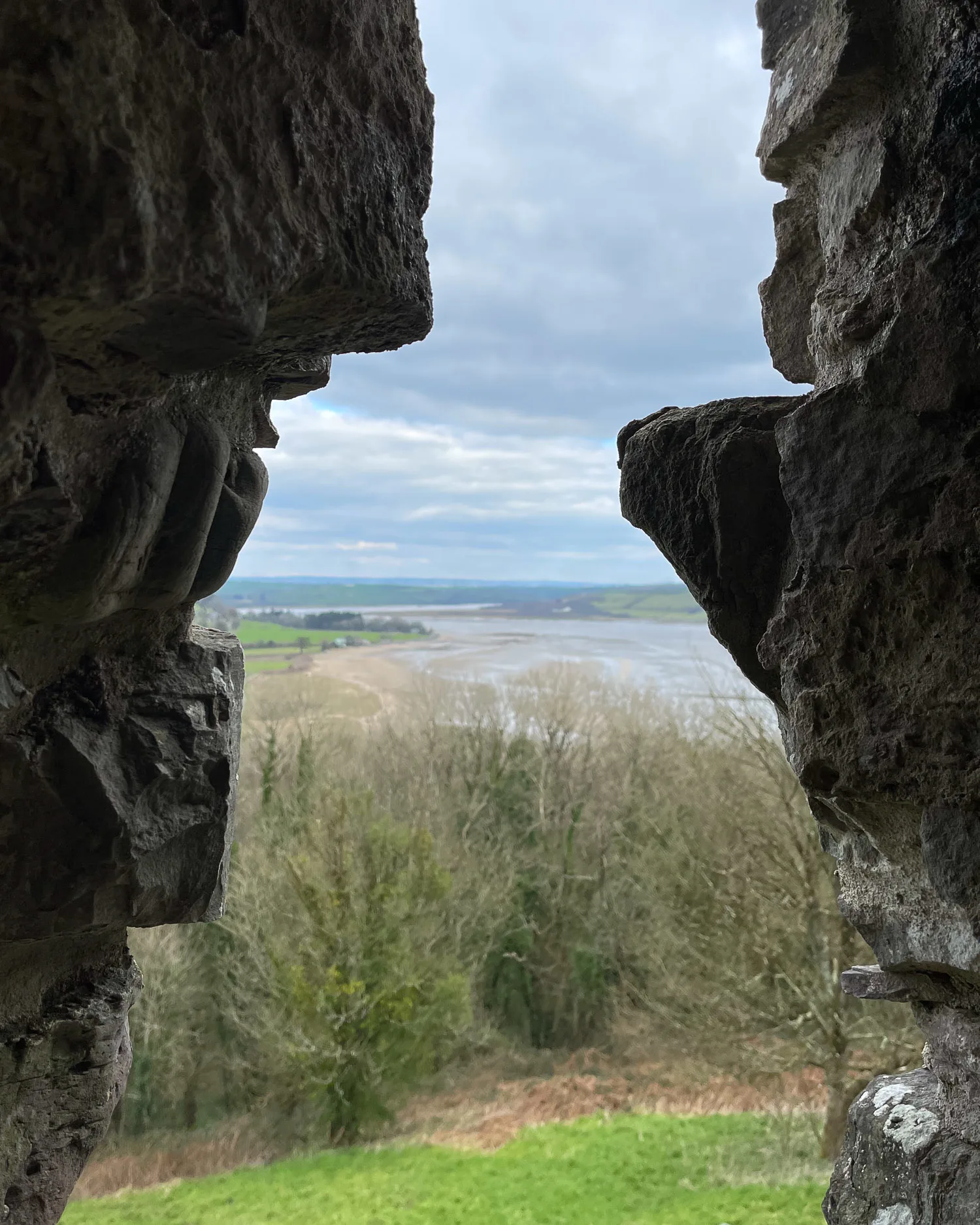
13 Llansteffan Castle – views over the Tywi estuary
Like the other castles we visited on our weekend in Carmarthenshire, Llansteffan castle was built during the 12th century by the Welsh lords. It was used as a fortress to control trade along the Tywi river.
The castle is now privately owned, although under the guardianship of CADW and is free to visit. While the castle buildings and encircling walls are in ruins, you can climb one of the towers. You’ll be rewarded with wonderful views over the estuary and village of Llansteffan.
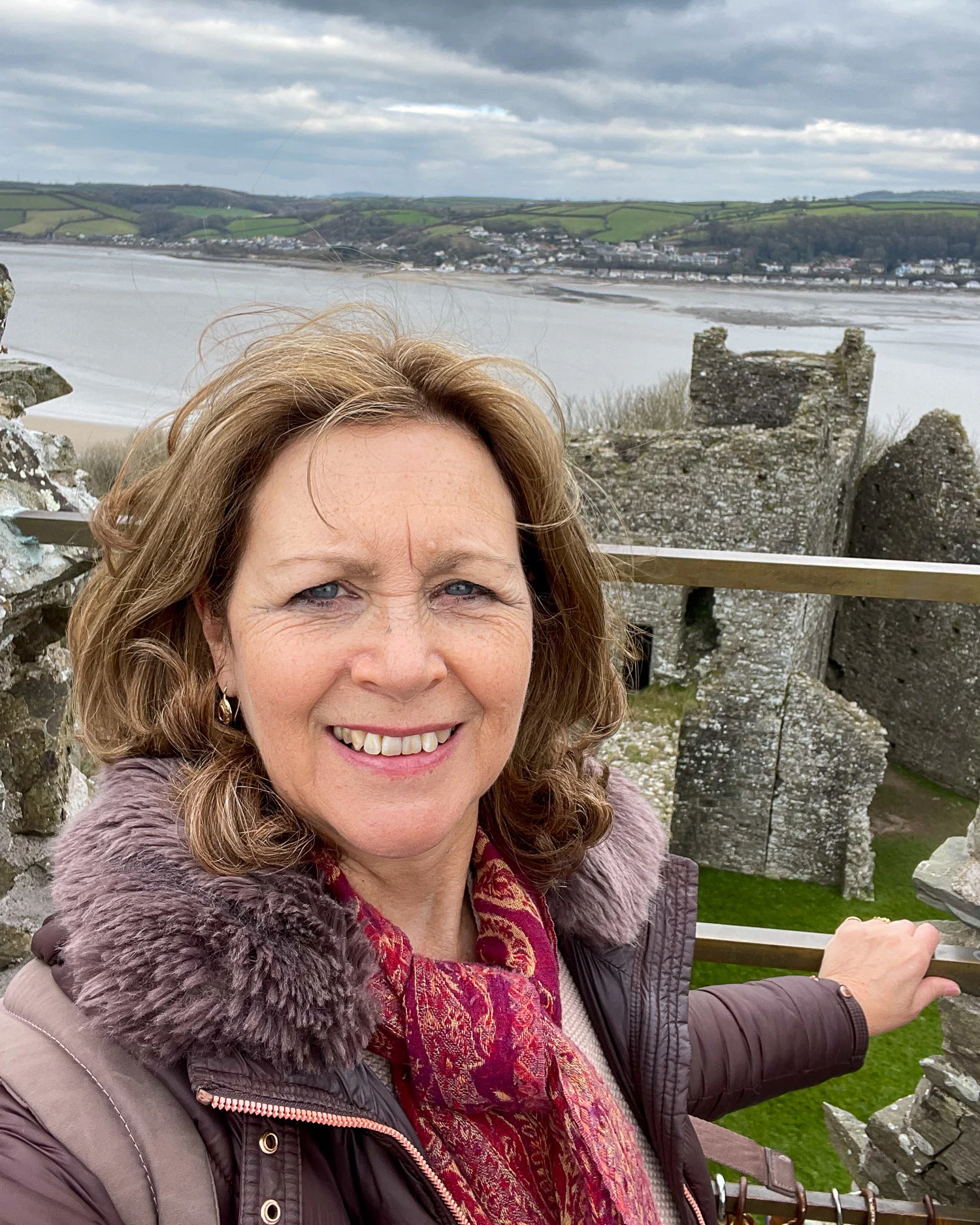
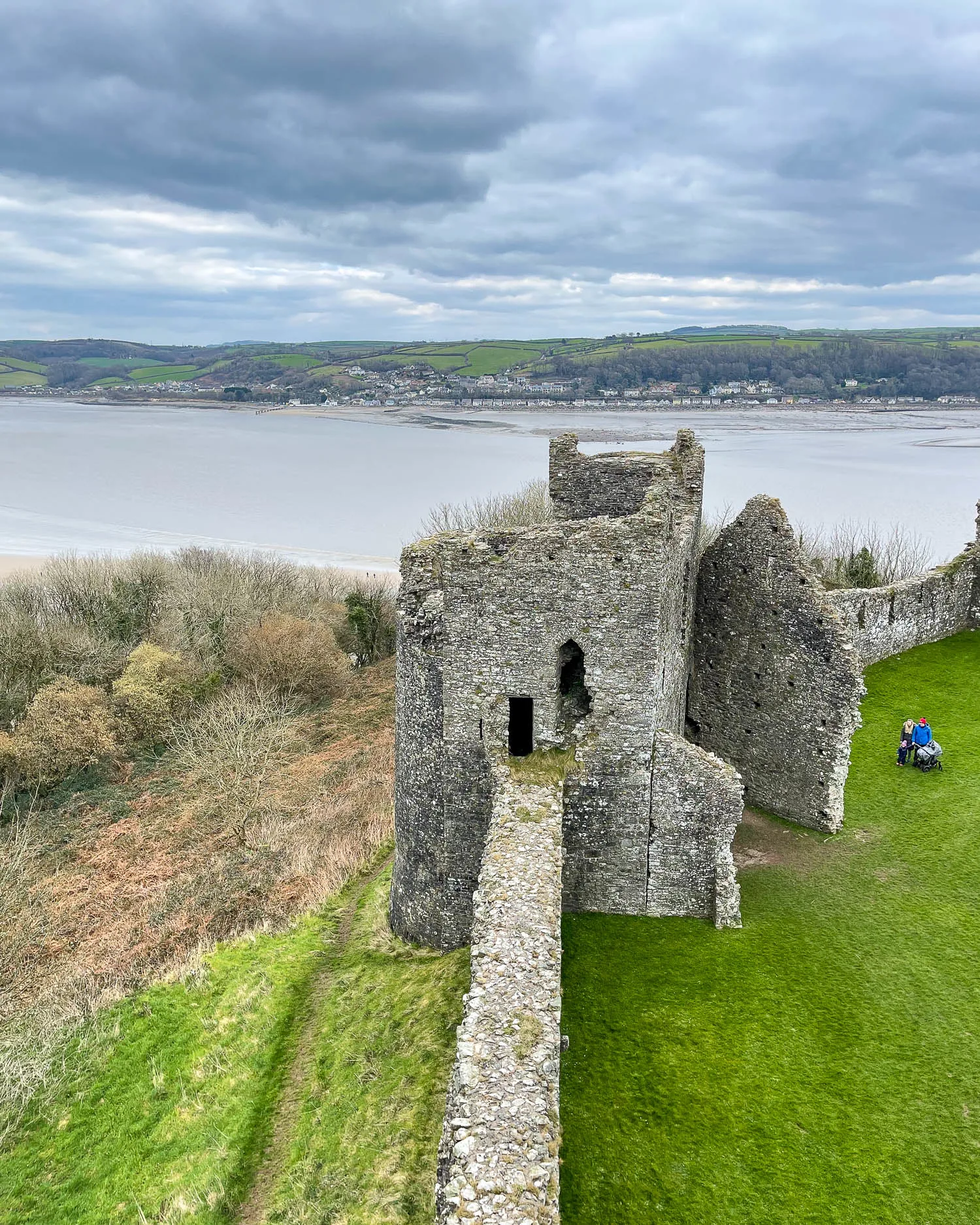
After playing at being Lords and Ladies of the castle, the path took us down through the village. We were booked at the Inn at the Sticks in Llansteffan for their Sunday lunch. The pub gets its name from the woodland below the castle, known as “the sticks”, and serves excellent food, with rooms above.
Their Sunday roast was sensational, with enormous Yorkshire puds to drown in gravy. There was plenty of veg on the side including perfectly crisp roast potatoes and a delicious cauliflower cheese. For desert we shared a sticky toffee pudding, drowning in silky caramel sauce and ice cream.
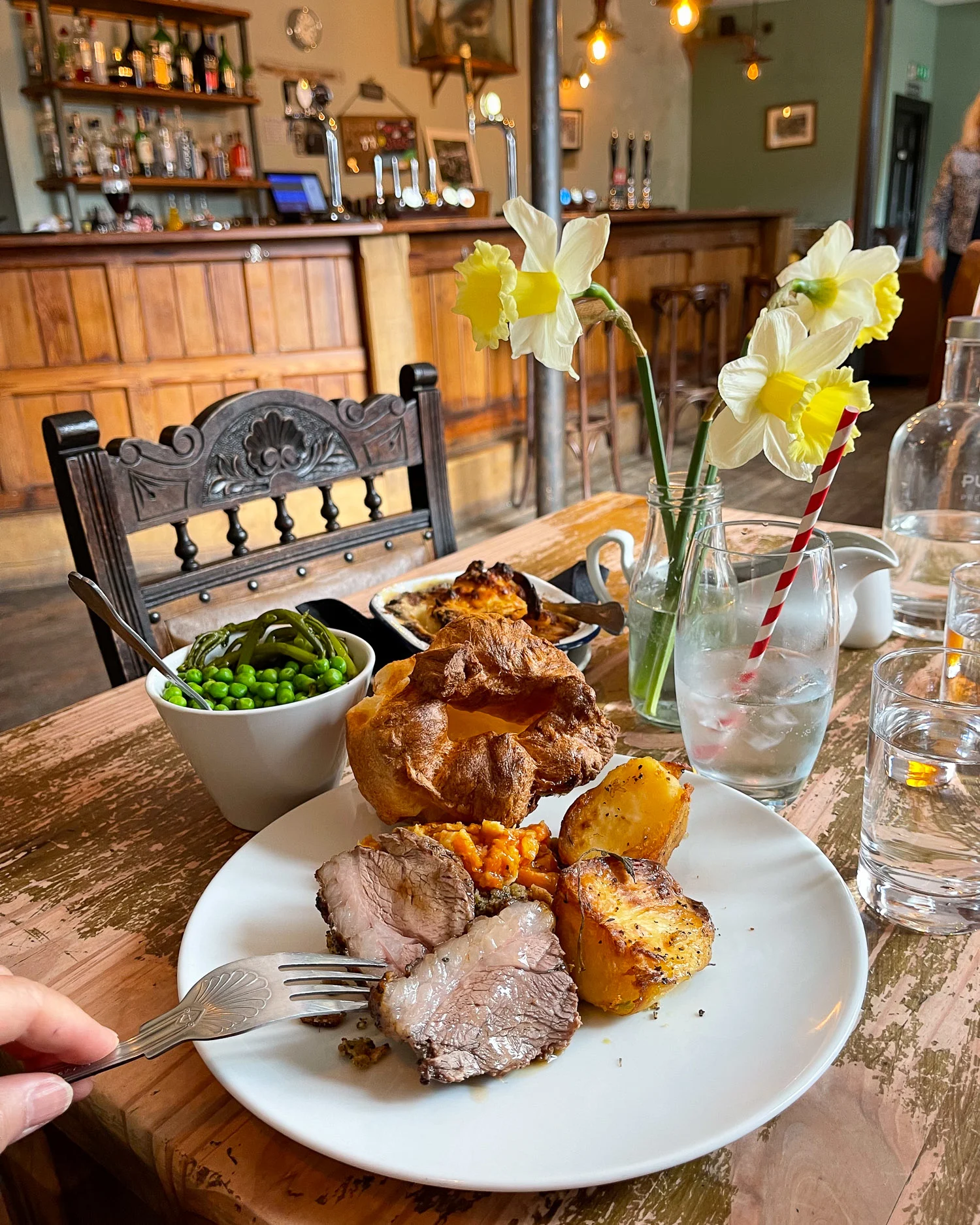
14 Laugharne – the home of poet Dylan Thomas
Just along the coast from Llansteffan is Laugharne, which I visited on a previous trip to Carmarthenshire. Although we didn’t have time during our weekend to visit again, I can highly recommend a stop at this pretty town on the estuary, which was the home of Welsh poet, Dylan Thomas.
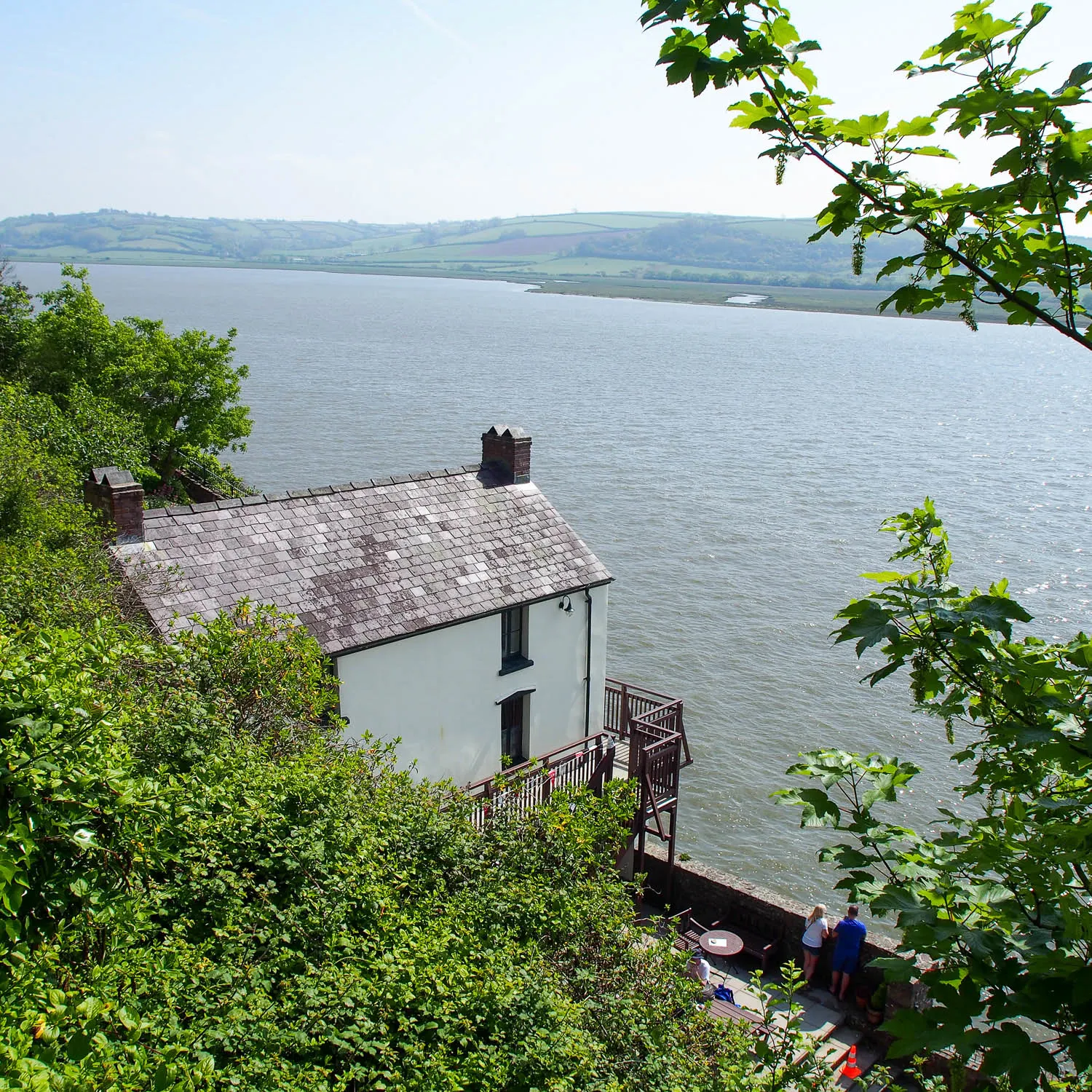
Laugharne is located on the Taf estuary which feeds into Carmarthan Bay, with mirrors of water at low tide. Here the wading seabirds pick their way through the shallows.
This is where Dylan Thomas spent the last 4 years of his life, with his wife Caitlin and children in a fisherman’s cottage called the Boathouse, perched above the estuary.
Read about a driving tour of South Wales: in search of Dylan Thomas
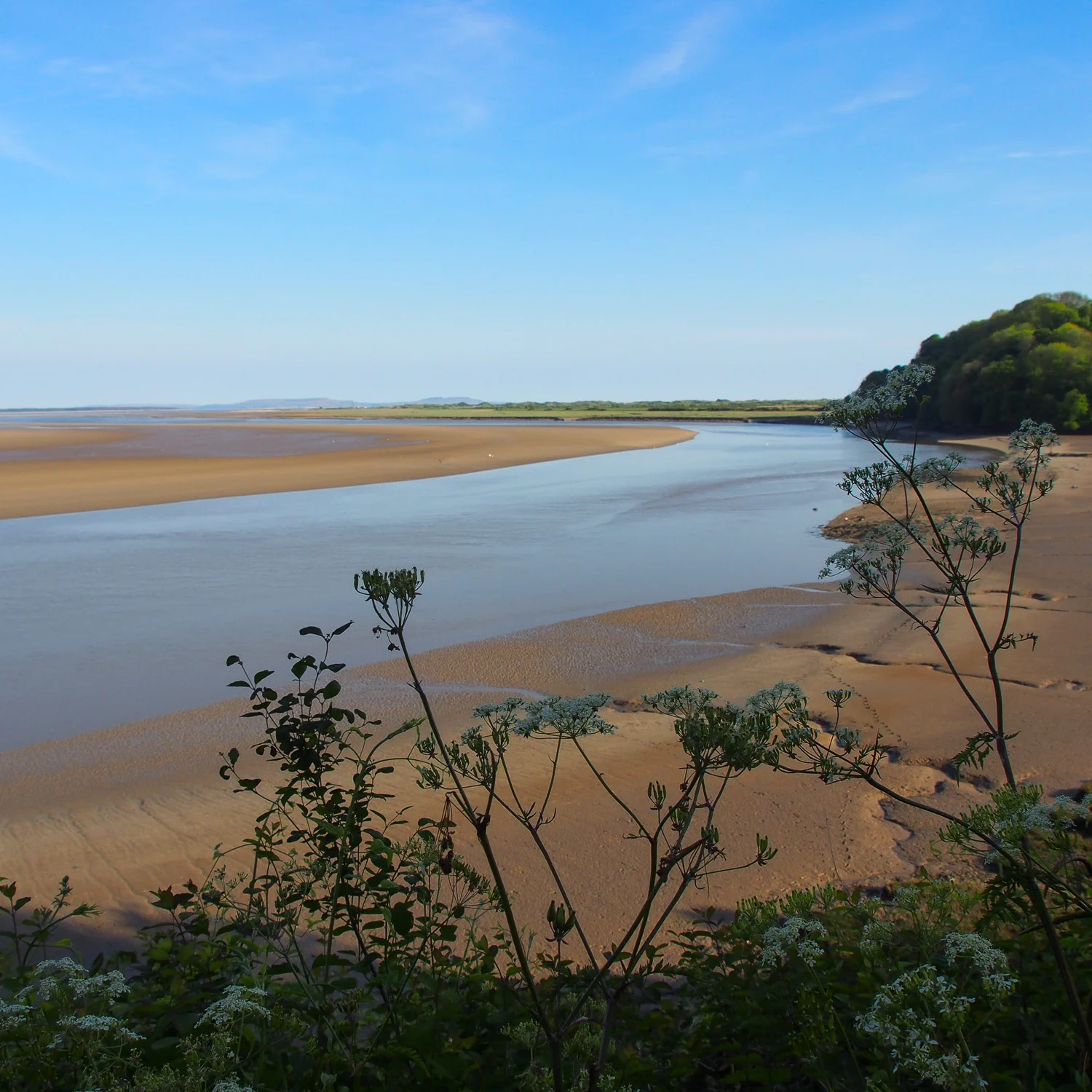
The boathouse is now open to visit, as a museum to Thomas’s work, furnished as it was when he lived there. Just down the lane is the Writing Shed, where Dylan Thomas worked.
It was left with papers scattered across the desk, as if he’d popped out for a walk along the beach. In the churchyard stands a white cross to commemorate Dylan Thomas and his wife Caitlin who is buried with him.
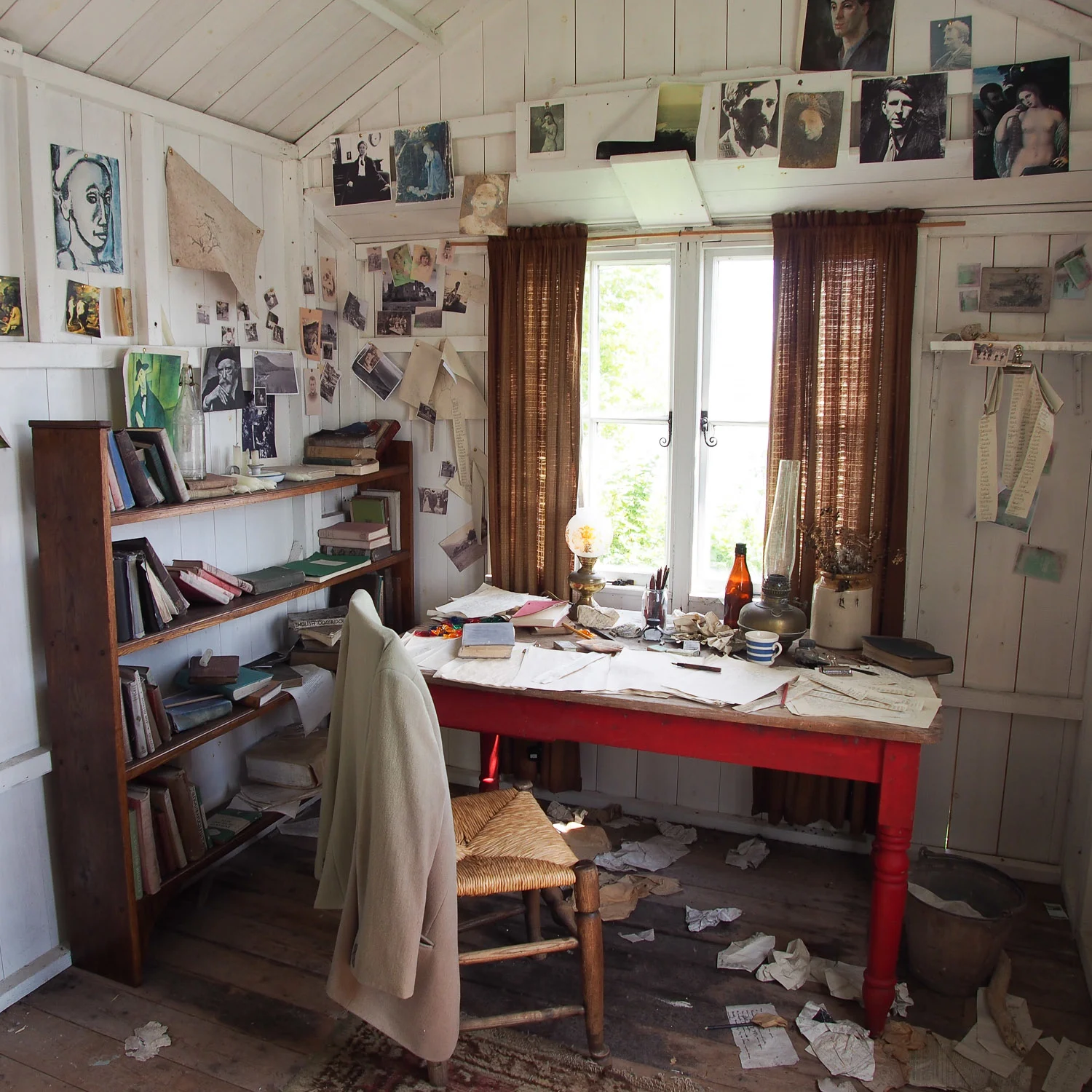
Dylan Thomas birthday walk
The Dylan Thomas birthday walk takes you through Laugharne and along the edge of the estuary. Stopping points mark places where the poet was inspired in his poetry, especially his “Poem in October”. Browns Hotel in the heart of Laugharne was the favourite pub that Thomas treated as an extension of his living room.
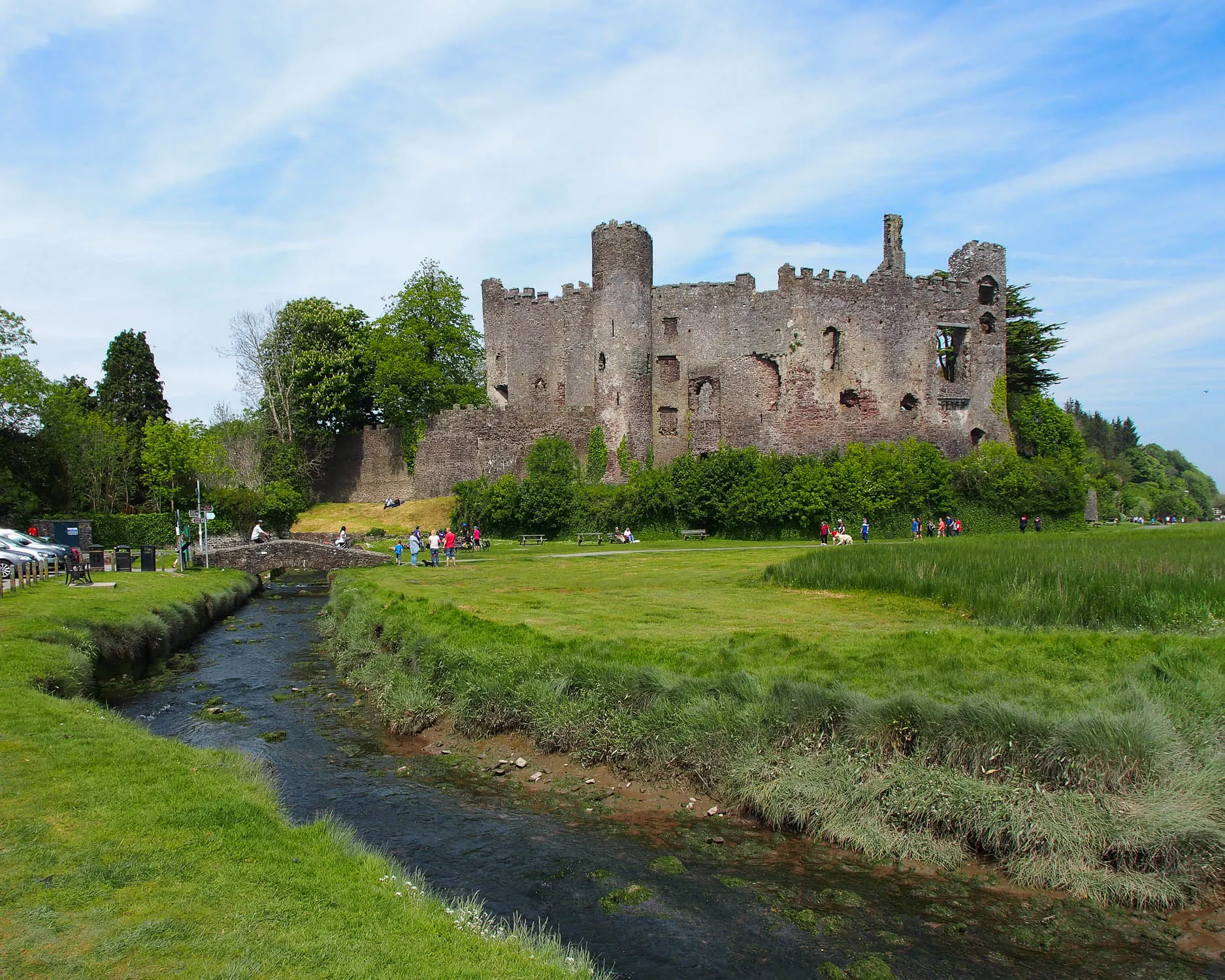
As it’s now a boutique hotel, you can stay at Browns Hotel Llaugharne, or just stop for a drink in the Dylan Thomas bar. The town is dominated by the ruins of Laugharne Castle which you can visit and climb the tower. In the grounds is the garden gazebo, owned by his friends, where Thomas would sit and write.
Read more about all the things to do in Laugharne in my article – Visit Laugharne on the Dylan Thomas Trail
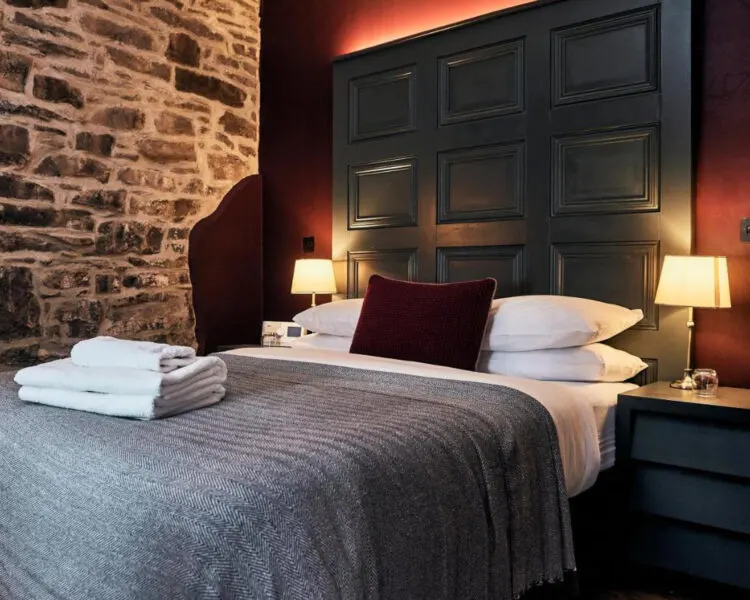
Stay at Browns Hotel in Laugharne – a stylish boutique hotel where we stayed when we visited Laugharne
15 The Cawdor – a cosy boutique hotel
For our weekend in Carmarthenshire, we based ourselves at the cosy Cawdor Hotel in Llandeilo. You can’t miss it as you pass through the town, as it’s painted deep red.
The hotel was built in 1765 and was originally called the Bear Inn before changing its name when it was purchased by the Earl of Cawdor in the 1830s. In 2004, the hotel was taken over by new owners and went through an extensive renovation, to create the boutique hotel with bar and restaurant that you see today.
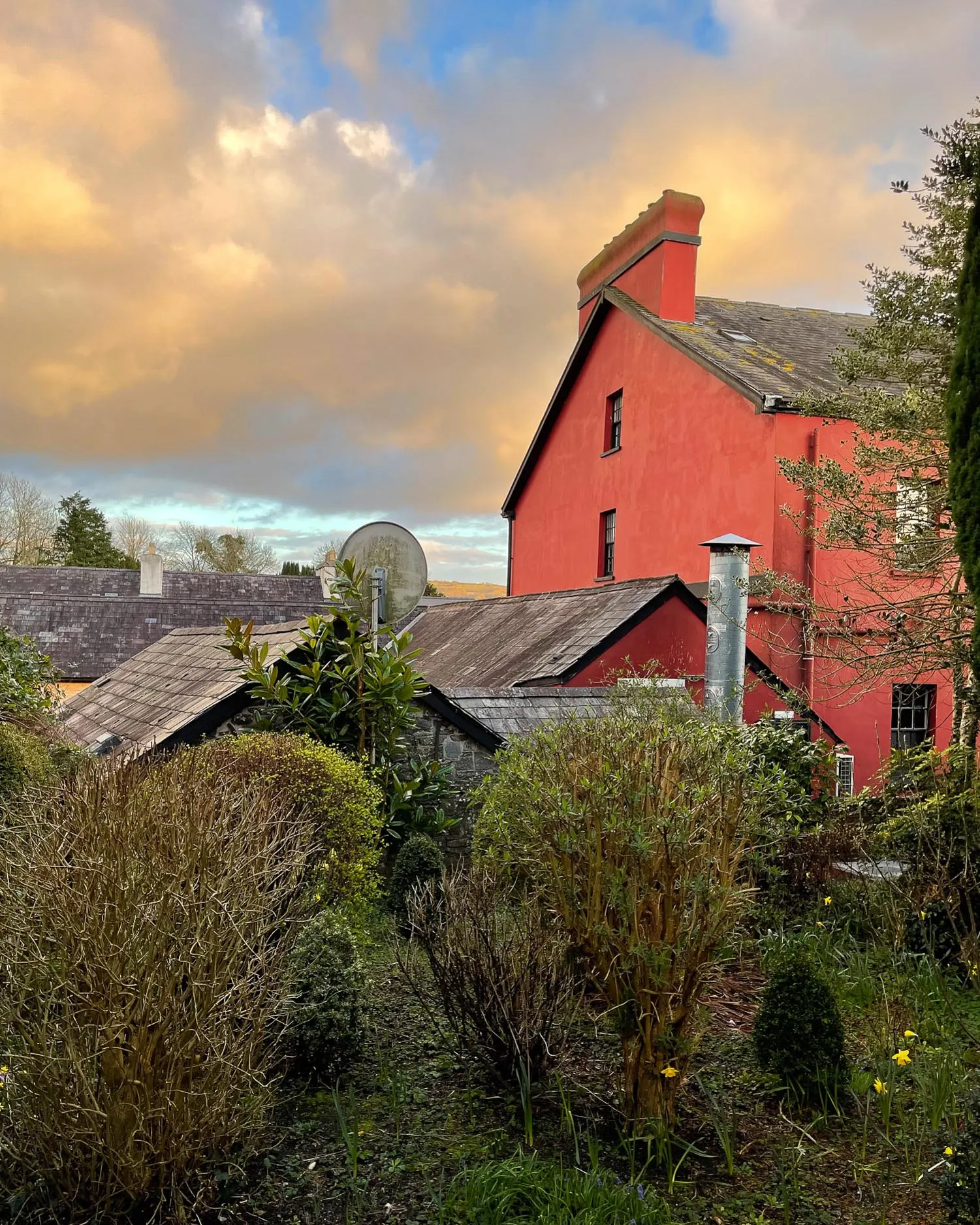
Our bedroom was an enormous penthouse loft room named Dinefwr. All the rooms are named after local places like the nearby Dinefwr castle.
We loved the old wooden beams that give the hotel an authentic Welsh feel, and the cosy Welsh blankets from Melin Tregwynt. They’ve made an art of updating these traditional woollen blankets in contemporary styles.
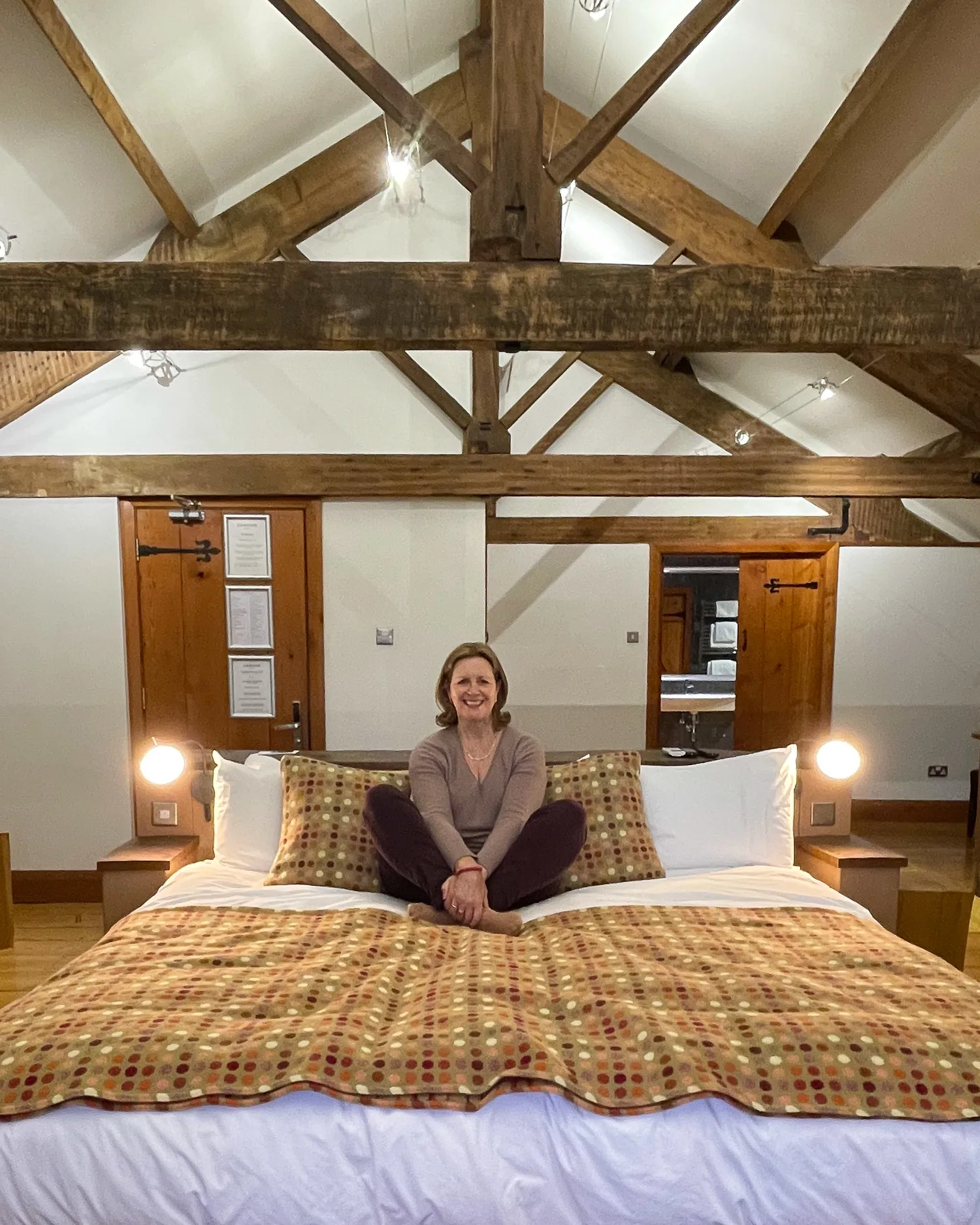
Our bathroom was sleek and contemporary, with refillable toiletries from Myddfai. These luxurious products are created by a social enterprise that works with vulnerable adults from the local community. Best of all was the wonderful view across the valley from the window seat, that we could enjoy from the bed.
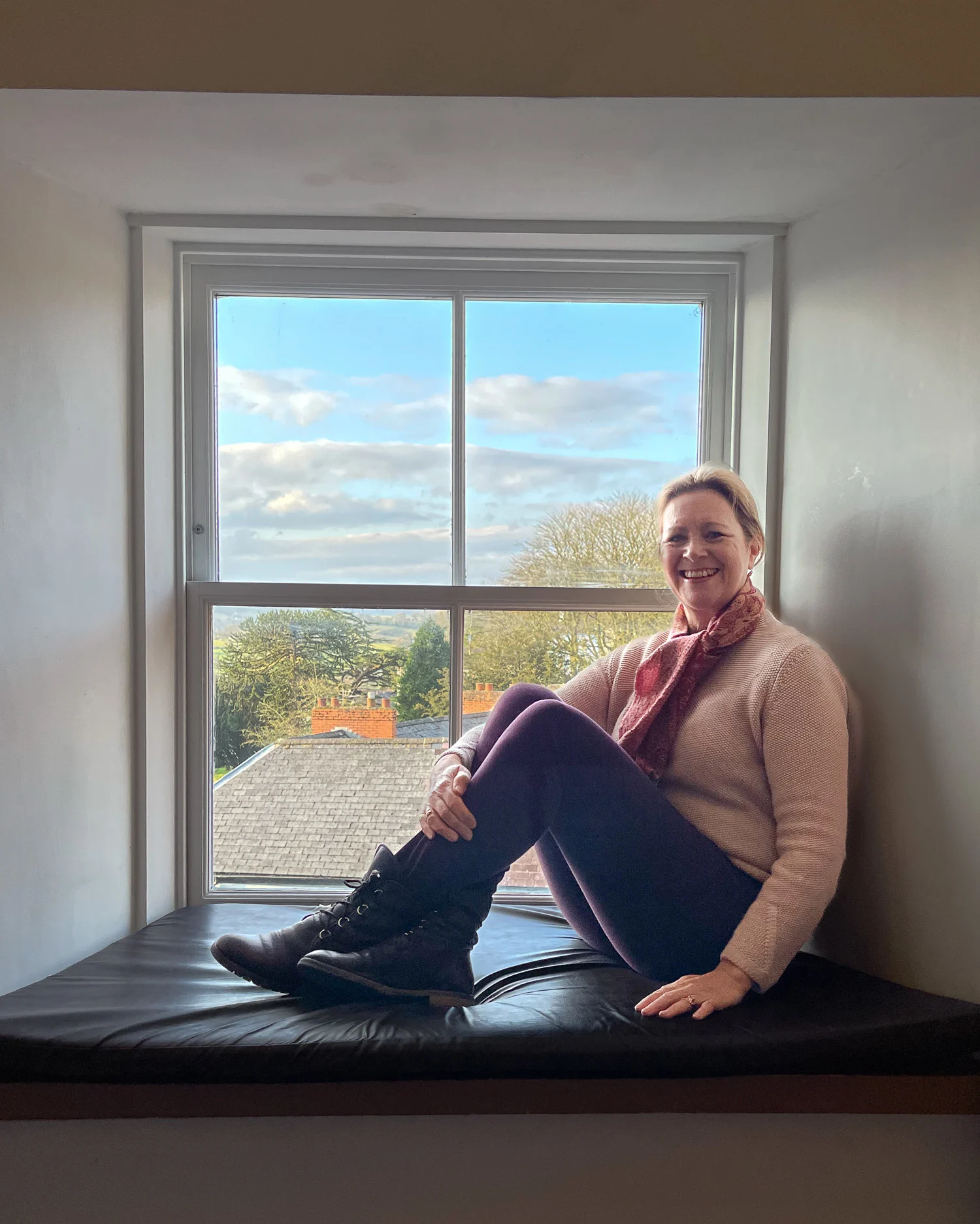
A popular local spot
The Cawdor is a popular local spot for a drinks or dinner, welcoming guests and locals alike to its excellent restaurant, lounge and bar. If you are lucky you might be able to bag a seat in front of the fire in the lounge for a coffee or in the window seat to watch the world pass by on Llandeilo’s high street. In the bar, we spent a long while looking at all the old photos on the wall that capture the town as it has evolved in the last two hundred years.
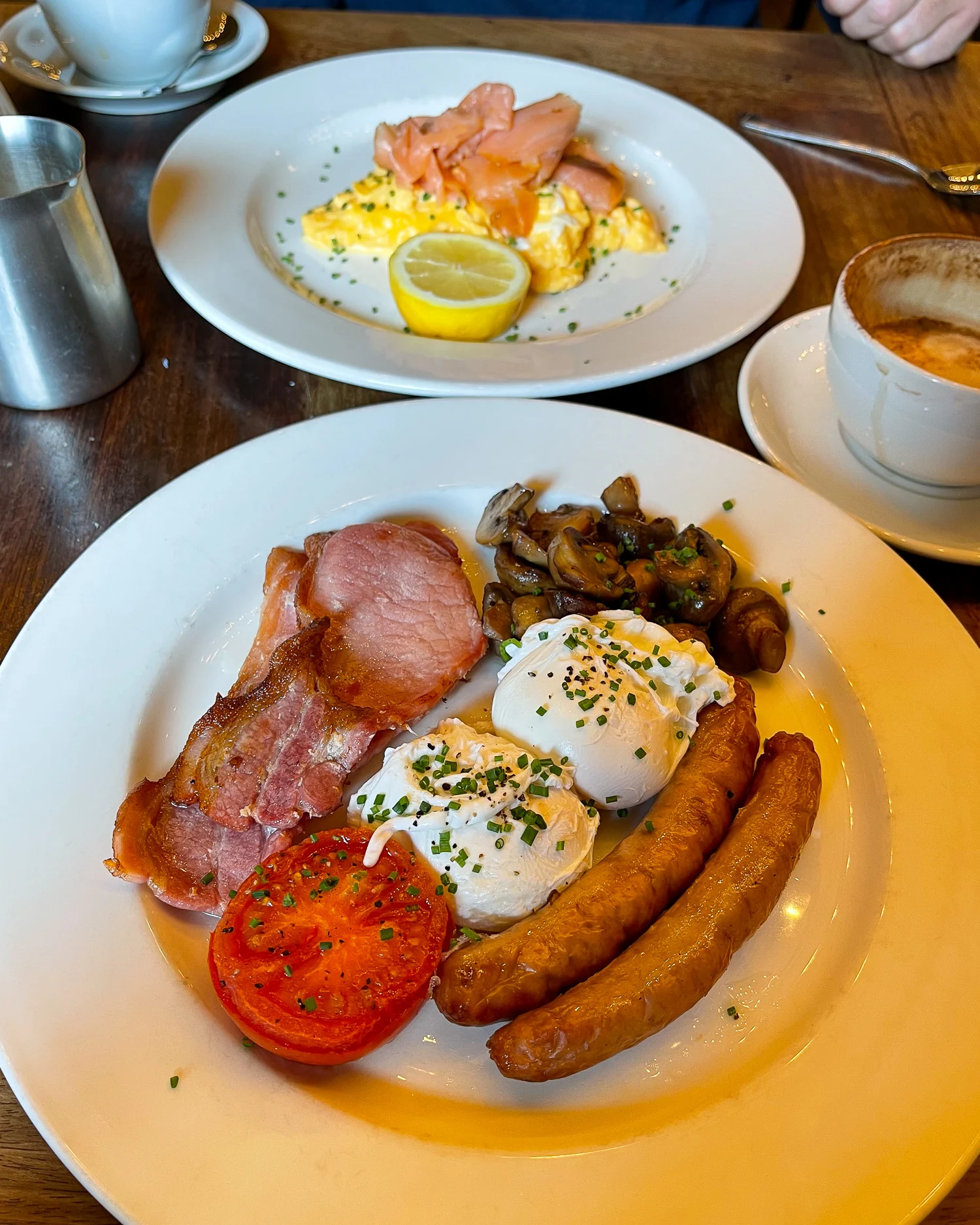
Breakfast was served in the spacious dining room, and our cooked dishes of smoked salmon with scrambled eggs. The Welsh breakfast was top notch, with an additional small selection of meusli, fruit, pasties and toast.
The restaurant was clearly a popular choice for locals to eat. We soon found out why in the evening, with excellent dishes we tried, that feature local and seasonal produce where possible.
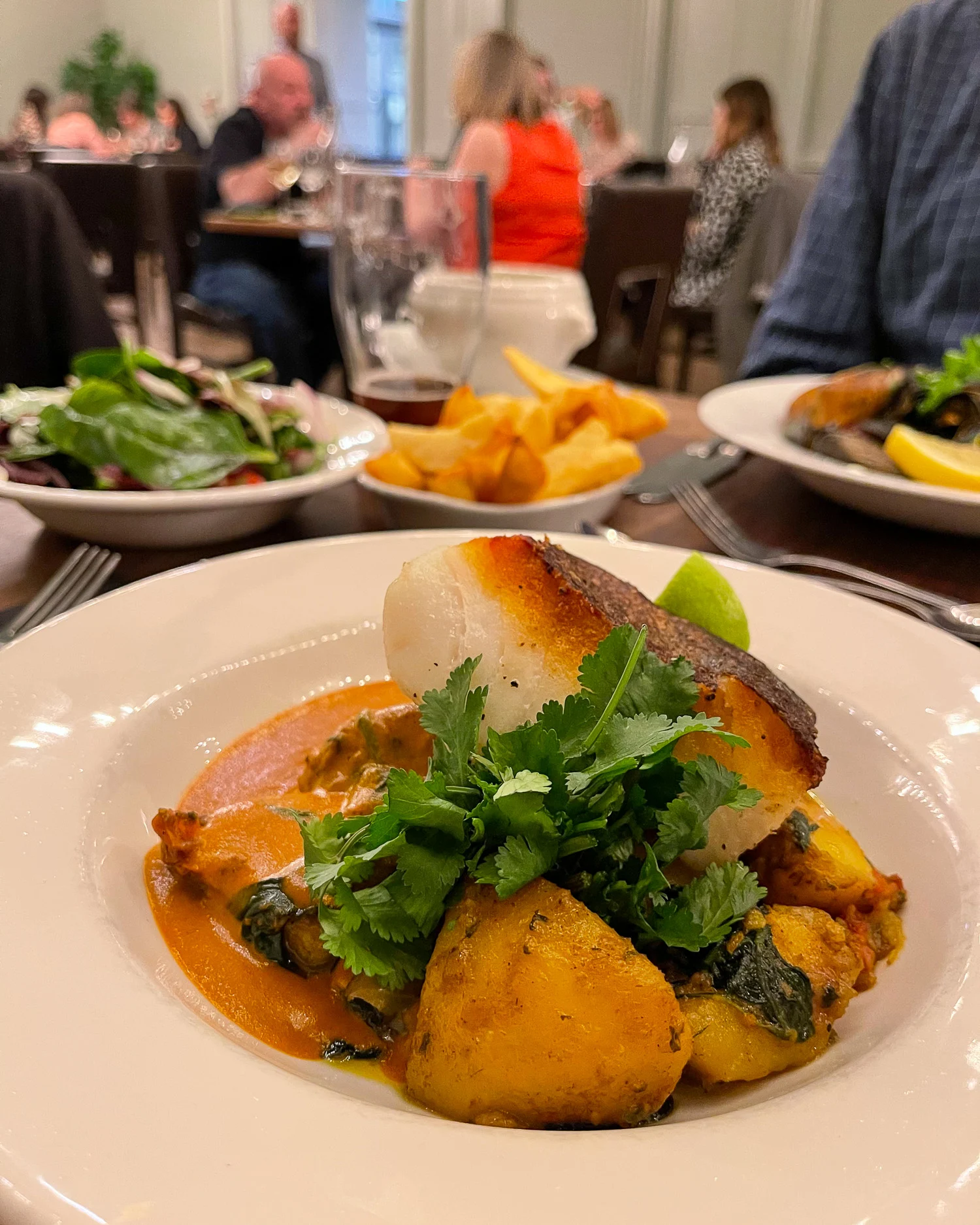
There’s an all day menu for relaxed dining featuring burgers, salads and hearty home style dishes. You can also choose from the evening specials menu. I selected a delicious flaky fillet of seared cod, with Bombay potatoes and creamy sweet curry sauce.
The style of food created by head chef Gavin Oram is hearty and generous, with lots of attention paid to the quality, presentation and flavours. Just what you’d hope to find in a welcoming country hotel.
More information to book your stay on The Cawdor Hotel Website or if this hotel is not what you are looking for check out these other Carmarthenshire Hotels.

Stay at the stylish boutique hotel The Cawdor in Llandeilo – this was the base for our weekend in Carmarthenshire
Plan your trip to Carmarthenshire
To find out more about Carmarthenshire and plan your trip, check out the Discover Carmarthenshire website.
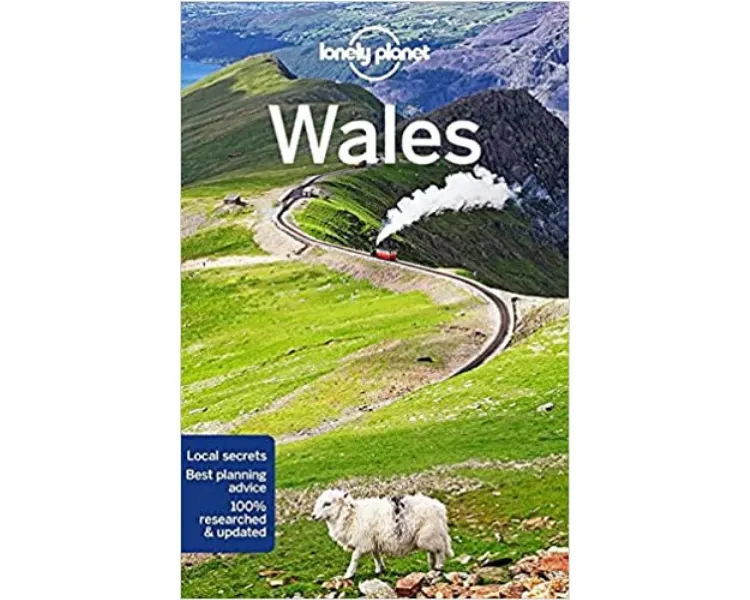
Need a guidebook for Wales? We recommend the Lonely Planet Wales Travel Guide
Pin it
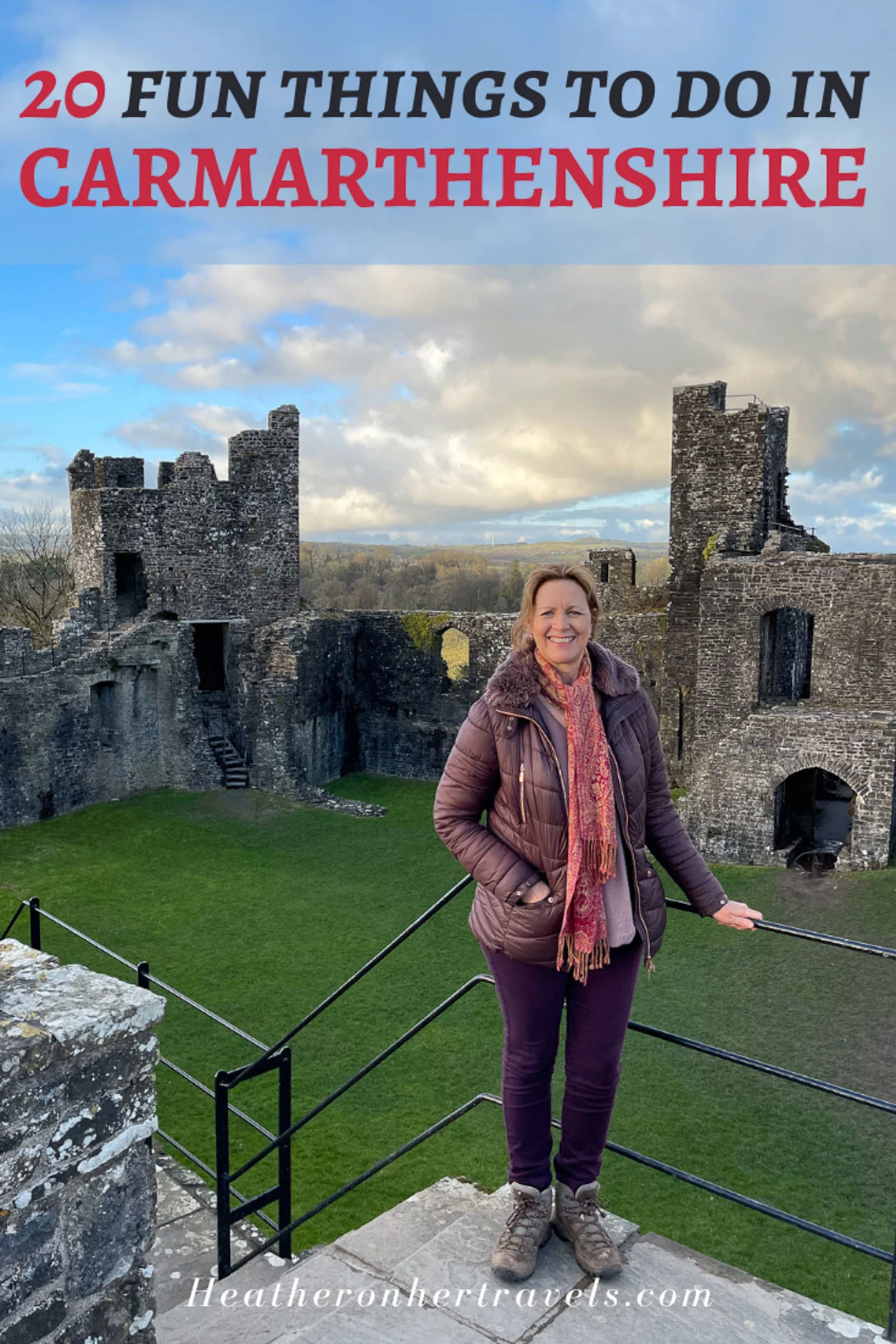
Read Next
Read more about our visit to Laugharne in Carmarthenshire in my article – Visit Laugharne on the Dylan Thomas Trail
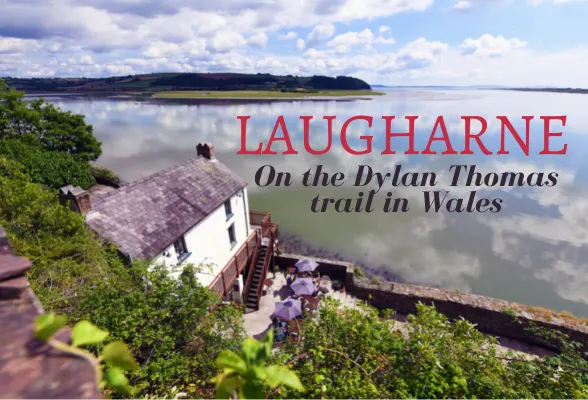
Our visit was sponsored* by Discover Carmarthenshire, who provided accommodation and some of the experiences mentioned.
* More info on my policies page
This article is originally published at Heatheronhertravels.com

